Top Attractions and Hidden Gems in Sri Lanka
Top Attractions and Hidden Gems in Sri Lanka
Solo Travel Guide Sri Lanka
This guide is made for true adventurers, those who live and breathe travel and can’t wait to discover new and different places. Whether you're an explorer at heart or someone seeking a deeper connection with this beautiful island, this journey will show you Sri Lanka in its full glory.
Packed with exciting stops and hidden gems, this trip will take at least 6 weeks to complete, giving you ample time to soak in the culture, landscapes, and off-the-beaten-path experiences. From bustling cities to serene escapes, this map is all you need to uncover Sri Lanka’s best-kept secrets.
So, if you're excited to embark on a travel adventure like no other, this guide will be your perfect companion, helping you explore with confidence and excitement every step of the way!
Updated ago
Save
Share


Colombo
@ravinkavish
Colombo, Sri Lanka’s vibrant capital, is a dynamic blend of modernity and history, offering travelers a unique mix of culture, cuisine, and charm. This bustling metropolis is home to a diverse array of attractions, from ancient temples and colonial-era buildings to contemporary skyscrapers and chic cafes.
Explore the historic Fort area, where Dutch and British colonial architecture meet modern developments, or stroll along Galle Face Green, a seaside promenade perfect for catching sunsets. For those interested in culture, the Gangaramaya Temple and Independence Square showcase the city's rich heritage. Colombo also boasts lively markets like Pettah, where you can shop for everything from spices to souvenirs.
Pro tip: Colombo is a great starting or ending point for your Sri Lankan journey, with convenient access to the airport. Plan to spend at least a day exploring its highlights and indulging in the local cuisine, especially at the trendy restaurants and street food stalls scattered across the city.
Add to
Details

Kandy
@ravinkavish
Kandy, nestled in the lush hill country of Sri Lanka, is a city of deep cultural, historical, and spiritual significance. As the last capital of the ancient Sinhala kings, it played a crucial role in preserving the island’s heritage during colonial times. The city’s crown jewel is the Temple of the Sacred Tooth Relic (Sri Dalada Maligawa), which houses a sacred tooth of the Buddha and is a UNESCO World Heritage Site.
Surrounded by emerald-green hills, Kandy is also known for the picturesque Kandy Lake, which adds to its serene atmosphere. The city comes alive during the annual Esala Perahera, a grand cultural procession featuring elephants, dancers, and drummers that pay homage to the Sacred Tooth Relic.
Beyond its cultural attractions, Kandy offers a gateway to nature, while the Royal Botanical Gardens in Peradeniya showcases a stunning collection of flora. The bustling streets of Kandy are perfect for sampling local delights like Kandyan sweets or shopping for traditional crafts and jewelry.
**Pro tip:** Visit the city in the early morning to explore the Temple of the Tooth before the crowds, and plan a sunset walk around the lake for spectacular views of Kandy’s skyline. Don’t miss the chance to take a scenic train ride to or from Kandy, one of the most beautiful rail journeys in the world.
Add to
Details

Nuwara Eliya
@ravinkavish
Nuwara Eliya, often referred to as "Little England," is a charming hill station nestled in the heart of Sri Lanka’s central highlands. Known for its cool climate, colonial-era architecture, and sprawling tea plantations, this picturesque town offers a unique blend of history, natural beauty, and leisure.
The town was established during the British colonial period and became a favorite retreat for the British elite. Today, you can still see colonial-style bungalows, red-brick post offices, and well-maintained gardens. Nuwara Eliya is also famous for its tea culture, and visiting a tea factory to witness the production process is a must. The serene Gregory Lake, lush Hakgala Botanical Garden, and the iconic Horton Plains National Park with the dramatic World's End viewpoint are among the many attractions in the area.
**Pro tip:** Nuwara Eliya is especially magical in April during the flower season and its vibrant horse races. Pack warm clothing as temperatures can drop, especially in the evenings. Don’t miss the chance to indulge in fresh strawberries and a steaming cup of locally grown Ceylon tea while soaking in the breathtaking views.
Add to
Details

Haputale
@ravinkavish
Haputale, a serene hill town perched at an elevation of around **1,431 meters**, offers some of Sri Lanka's most breathtaking views. Nestled in the central highlands, it is a haven for tea lovers, nature enthusiasts, and anyone seeking a peaceful escape. With its cool climate, lush tea plantations, and mist-draped landscapes, Haputale exudes an unhurried charm.
One of the highlights of Haputale is **Lipton’s Seat**, the favorite viewpoint of Sir Thomas Lipton, who revolutionized tea production in the region. The panoramic view from this spot stretches across verdant valleys and distant peaks. The nearby **Dambatenne Tea Factory**, established by Lipton himself, provides insight into the tea-making process.
Other must-visit attractions include **Adisham Bungalow**, a picturesque Benedictine monastery, and the tranquil **Thangamale Sanctuary**, ideal for birdwatching and short hikes. Haputale is also a gateway to **Horton Plains National Park** and the iconic **World’s End**.
**Pro tip:** Early mornings are the best time to explore, as the mist rolls in by afternoon, adding a mystical feel to the surroundings. Don’t forget a camera to capture the dramatic landscapes!
Add to
Details
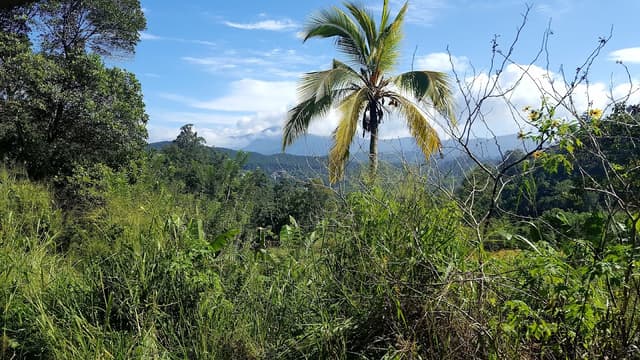
Ella
@ravinkavish
Ella, a charming village in Sri Lanka's hill country, is a paradise for travelers seeking stunning views, outdoor adventures, and a laid-back vibe. Surrounded by misty mountains, lush tea plantations, and cascading waterfalls, Ella offers a perfect blend of natural beauty and cultural richness.
The iconic **Nine Arches Bridge**, a colonial-era marvel, is a favorite spot for photography, especially when the train winds its way through the lush greenery. The trek to **Ella Rock** rewards you with panoramic views, while the shorter climb up **Little Adam’s Peak** is perfect for beginners, offering equally mesmerizing vistas.
Ella is also a hub for tea lovers. Visit the **Halpewatte Tea Factory** to learn about Sri Lanka’s world-renowned tea industry. For history enthusiasts, the nearby **Ravana Ella Falls** and **Ravana Cave** are linked to the epic Ramayana, adding a touch of mythology to your journey.
**Pro tip:** Plan your hike early in the morning for the best weather and views. Afterward, relax with a cup of locally grown tea or enjoy the lively cafes and restaurants that line the streets of Ella town.
Add to
Details

Sigiriya Town
@ravinkavish
Sigiriya Town, located in the heart of Sri Lanka's cultural triangle, is a charming and vibrant destination with much to offer. Famous for the iconic Sigiriya Rock Fortress, this town is a hub for history, culture, and nature. Sigiriya is a UNESCO World Heritage Site and attracts travelers with its ancient ruins, beautiful gardens, and panoramic views from the top of the rock.
The town itself is peaceful, with plenty of accommodation options, local markets, and eateries offering traditional Sri Lankan cuisine. Sigiriya is also surrounded by lush forests, tranquil lakes, and smaller sites like the Pidurangala Rock, providing visitors with plenty of opportunities for exploration.
**Pro tip:** Visit early in the morning or late afternoon to avoid crowds at Sigiriya Rock and enjoy cooler weather. If you have extra time, explore nearby sites like the ancient city of Polonnaruwa or Minneriya National Park for a full cultural and natural experience. Sigiriya Town is the perfect base for adventurers and history buffs alike.
Add to
Details

Anuradhapura
@ravinkavish
Anuradhapura, one of Sri Lanka's most iconic ancient cities, is a UNESCO World Heritage Site and the heart of the island's rich cultural and spiritual heritage. Established in the 4th century BCE, it served as the capital of Sri Lanka for over 1,300 years, showcasing a golden era of art, architecture, and Buddhism.
The city is famed for its sprawling ruins, including majestic stupas like **Ruwanwelisaya** and **Jetavanaramaya**, ancient monasteries, and sacred sites like the **Sri Maha Bodhi**, a revered fig tree believed to be the oldest living tree planted by humans, dating back to 288 BCE. The irrigation marvels, including massive tanks like **Tissa Wewa**, reflect the advanced engineering skills of its ancient inhabitants.
**Pro tip:** Explore Anuradhapura by bicycle or tuk-tuk to fully immerse yourself in its historical grandeur. Don't miss sunrise or sunset at one of the stupas, where the golden light enhances the mystical aura of this ancient city.
Add to
Details

Katunayake
@ravinkavish
Add to
Details

Galle
@ravinkavish
Galle, located on Sri Lanka’s southwestern coast, is a historic city known for its charming blend of colonial architecture, vibrant culture, and coastal beauty. The **Galle Fort**, a UNESCO World Heritage site, is the city's most famous attraction, offering cobblestone streets, old Dutch buildings, and panoramic views of the Indian Ocean. The fort was built by the Portuguese in the 16th century and later fortified by the Dutch, reflecting a rich colonial past.
Beyond the fort, Galle is home to beautiful beaches, including **Unawatuna Beach**, a popular spot for swimming and snorkeling. The city also offers bustling markets, boutique shops, and cafes where you can experience local culture and cuisine.
**Pro tip:** Take a walk along the ramparts of Galle Fort at sunset for a beautiful view of the ocean and the city’s skyline.
Add to
Details

Matara
@ravinkavish
Matara, located along Sri Lanka’s southern coast, is renowned for its beautiful and tranquil beaches, offering a perfect mix of relaxation and adventure. The beaches here are less crowded compared to other tourist hotspots, making them ideal for those seeking a peaceful coastal experience.
**Polhena Beach** is one of the standout beaches in Matara, famous for its calm waters and coral reefs, making it a perfect spot for snorkeling and swimming. The beach is lined with palm trees and has a relaxed vibe, with a few local eateries serving fresh seafood right by the water.
**Matara Beach** itself offers stunning views and a quieter atmosphere compared to other southern beaches. It’s ideal for long walks along the shore, swimming, or simply enjoying the sunset. Nearby, you’ll find the **Matara Fort** and local markets, adding a touch of culture to your beach experience.
For a more secluded experience, **Madhiha Beach** is a hidden gem located just a short drive from the town. It’s perfect for those looking to escape the crowds and enjoy the natural beauty of Sri Lanka’s southern coastline.
**Pro tip:** Matara’s beaches are best visited during the dry season from November to April, when the weather is perfect for sunbathing, swimming, and exploring.
Add to
Details

Tissamaharama
@ravinkavish
Add to
Details

Mirissa
@ravinkavish
**Mirissa**, a charming beach town on Sri Lanka’s southern coast, is the ultimate tropical getaway known for its stunning sandy beaches, vibrant nightlife, and unforgettable marine experiences. Whether you're seeking relaxation or adventure, Mirissa has something for everyone.
The crescent-shaped **Mirissa Beach** is the town’s crown jewel, offering crystal-clear waters perfect for swimming, snorkeling, or simply lounging under the sun. It’s also a hub for water sports, with options like surfing for both beginners and seasoned riders.
One of Mirissa's most iconic attractions is **Parrot Rock**, a small rocky islet accessible during low tide, offering panoramic views of the coastline. For a magical sunrise or sunset, it's the perfect spot to soak in the beauty of the Indian Ocean.
Mirissa is also world-famous for **whale watching**, particularly from November to April. Tours departing from Mirissa Harbor give visitors a chance to see blue whales, sperm whales, and playful dolphins up close.
The vibrant nightlife features beachfront restaurants and bars offering fresh seafood, cocktails, and live music. It's an ideal setting for travelers to unwind and socialize.
**Pro tip:** Visit Mirissa early in the morning for whale watching and spend the rest of the day exploring the beach or nearby attractions like the secret beach or Weligama. The best time to visit is during the dry season for calm seas and clear skies.
Add to
Details

Tangalle
@ravinkavish
Tangalle, located on Sri Lanka's southern coast, is a charming coastal town known for its golden beaches, turquoise waters, and relaxed vibe. It’s a perfect getaway for those seeking a peaceful retreat away from the crowds, offering a mix of natural beauty, cultural attractions, and laid-back coastal life.
The beaches in Tangalle, such as Goyambokka, Silent Beach, and Rekawa, are pristine and ideal for sunbathing, swimming, or simply unwinding to the sound of the waves. Rekawa Beach is also famous for its turtle conservation project, where you can witness sea turtles laying eggs under the moonlight. Tangalle’s lagoon offers kayaking and bird-watching opportunities, while its local markets give a glimpse into the town’s vibrant culture.
For history enthusiasts, Mulkirigala Rock Temple, a short drive away, showcases ancient Buddhist murals and offers panoramic views from the top of the rock.
**Pro tip:** Visit Tangalle between November and April for the best beach weather. Don’t miss sampling fresh seafood at a beachfront restaurant and exploring the nearby mangroves and countryside. Tangalle’s tranquility makes it an ideal spot for both relaxation and adventure.
Add to
Details

Talpe
@ravinkavish
Add to
Details
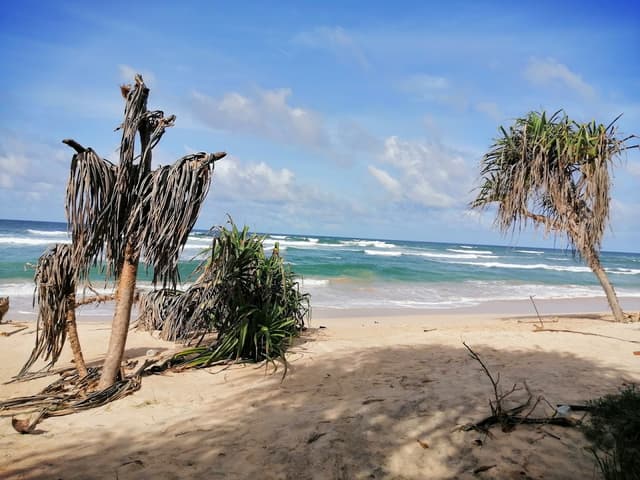
Ahangama
@ravinkavish
Add to
Details

Weligama
@ravinkavish
Weligama is a lively coastal town located between Mirissa and Matara, known for its long sandy beach, surf-friendly waves, and vibrant atmosphere. The name "Weligama" translates to "sandy village," and the beach lives up to its name with its expansive shoreline perfect for beach walks, swimming, and sunbathing.
Weligama is particularly famous for its surf scene, attracting both beginners and seasoned surfers. The beach is known for its gentle, consistent waves, making it a great place to take surf lessons or simply enjoy the ocean. It's also home to the unique **stilt fishing** method, where fishermen perch on stilts in the shallow waters, a practice that has become a notable feature of the local culture.
Beyond the beach, Weligama has a relaxed, yet vibrant atmosphere, with a growing number of cafes, restaurants, and shops along the main road. The town is also a great base for exploring nearby attractions like **Kushtarajagala Temple**, which features a large statue of a seated Buddha.
For those looking for a mix of relaxation, adventure, and local culture, Weligama offers an ideal blend.
**Pro tip:** For a quieter experience, visit early in the morning or during weekdays, when the beach is less crowded. Don’t miss the stilt fishermen, especially at sunrise or sunset, for a truly unique photo opportunity.
Add to
Details
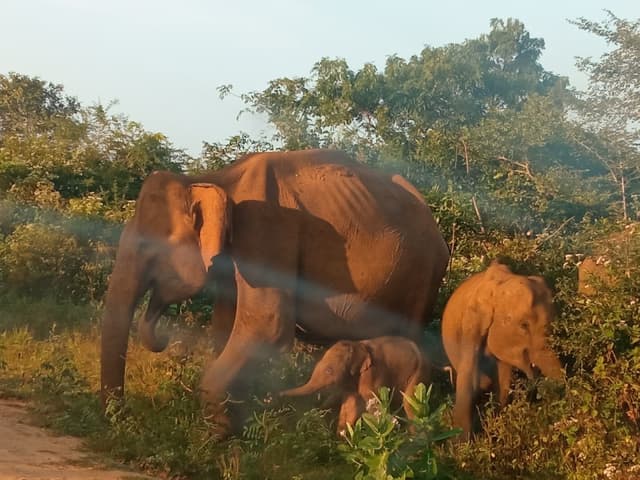
Udawalawa
@ravinkavish
Add to
Details

Polonnaruwa Ancient City/ entrance to a collection of ancient sites
@ravinkavish
Polonnaruwa Ancient City, a UNESCO World Heritage site, is one of Sri Lanka’s most significant historical landmarks, offering a fascinating glimpse into the country’s rich cultural and architectural heritage. Once the capital of Sri Lanka from the 11th to 13th centuries, Polonnaruwa is renowned for its well-preserved ruins and ancient structures, which include palaces, temples, and stupas.
The city flourished under the reign of King Parakramabahu I, who is credited with expanding and beautifying the city, as well as building extensive irrigation systems that transformed the area into a prosperous hub. Key highlights of the city include the remarkable *Gal Vihara* rock temple with its stunning Buddha statues, the majestic *Rankoth Vehera* stupa, and the *Royal Palace* ruins. The *Parakrama Samudra*, an ancient man-made reservoir, is also a notable feature of the site, reflecting the advanced engineering of the time.
**Pro tip:** The ancient city is spread over a large area, so it’s recommended to either rent a bicycle or hire a guide to help explore the key sites. It’s also a great place for photography, especially at sunrise or sunset, when the lighting enhances the beauty of the ruins. Take time to appreciate the historical significance of the city and the legacy of the ancient Sri Lankan kings who once ruled from this magnificent capital.
Add to
Details
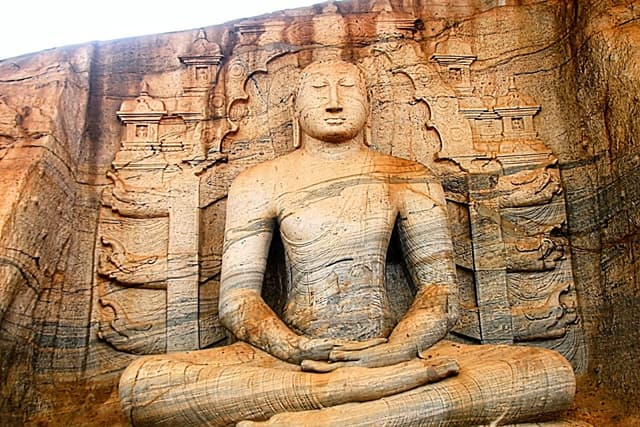
Uththararamaya (Gal Vihara)
@ravinkavish
Uththararamaya, also known as Gal Vihara, is one of the most significant and awe-inspiring Buddhist sites in Sri Lanka, located in the ancient city of Polonnaruwa. This remarkable rock temple, dating back to the 12th century, was built by King Parakramabahu I. It is renowned for its impressive statues of the Buddha, carved directly into the rock face, making it a striking example of ancient Sri Lankan craftsmanship.
The most famous feature of Gal Vihara is its large reclining Buddha statue, which is considered a masterpiece of Sri Lankan sculpture. In addition to the reclining Buddha, there are two standing statues and a seated Buddha, each exuding grace and serenity. The intricate details and proportions of the statues reflect the advanced artistry of the time.
**Pro tip:** Visit early in the morning or late afternoon to avoid the heat and enjoy the peaceful atmosphere of the site. Gal Vihara is a must-see for travelers interested in Sri Lanka's ancient Buddhist art and architecture. It’s a tranquil place to reflect, explore history, and marvel at the craftsmanship of ancient artisans.
Add to
Details
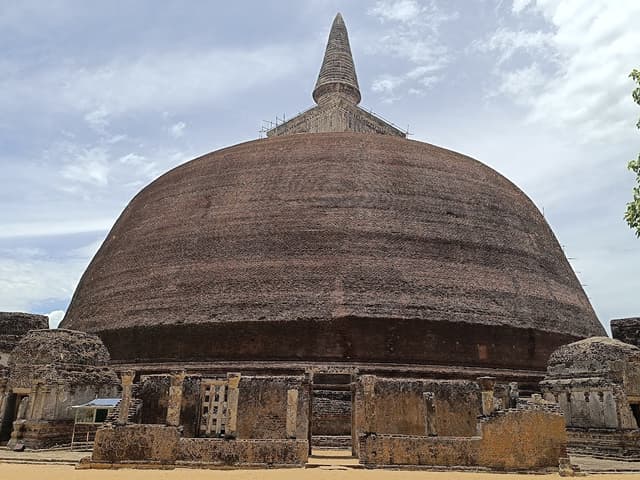
Rankoth Vehera
@ravinkavish
Rankoth Vehera, located in the ancient city of Polonnaruwa, is a stunning stupa with significant historical and religious importance. Built by King Nissanka Malla in the 12th century, this stupa is one of the largest and most beautifully preserved in the region. The name "Rankoth Vehera" translates to "Golden Pinnacle Stupa," reflecting its grandeur and the religious significance it held during its time.
The stupa, with its large dome and beautifully crafted stone railing, stands as a testament to the architectural brilliance of ancient Sri Lanka. It is surrounded by tranquil gardens, adding to its serene and peaceful atmosphere. Visitors can also find smaller structures and relic chambers around the stupa, which were once used for meditation and worship by Buddhist monks.
**Pro tip:** When visiting Rankoth Vehera, take time to appreciate the detailed stone carvings on the surrounding railings and the serene atmosphere of the site. It's a great place to connect with Sri Lanka's ancient Buddhist heritage while enjoying the calm beauty of Polonnaruwa. Be sure to visit at sunrise or sunset for the best lighting and a peaceful experience.
Add to
Details
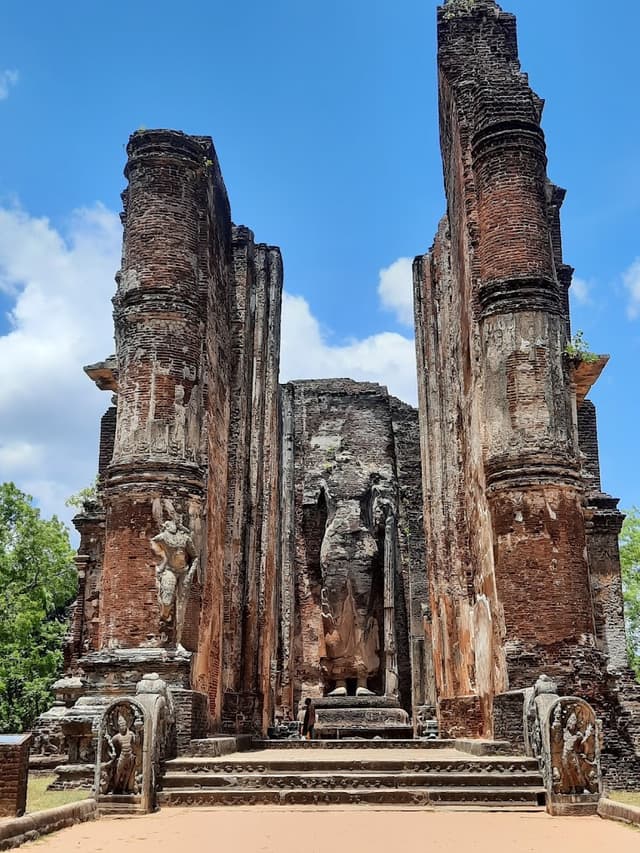
Lankatilaka Temple
@ravinkavish
Lankatilaka Temple, located in the ancient city of Polonnaruwa, is a remarkable and historically significant Buddhist temple known for its unique architecture and serene atmosphere. Built during the 14th century by King Parakramabahu II, the temple stands on a rock plateau and offers panoramic views of the surrounding landscape, adding to its allure.
The temple is best known for its massive image of the Buddha, housed inside a large, imposing structure with intricate carvings and paintings that reflect the rich cultural heritage of the time. The structure is a blend of traditional Sri Lankan and South Indian architectural styles, showcasing the evolution of Buddhist architecture in Sri Lanka.
**Pro tip:** Lankatilaka Temple is often less crowded compared to other sites in Polonnaruwa, offering a more peaceful visit. Be sure to explore the surrounding area, where you can also find the ruins of the surrounding monastery. The temple's serene atmosphere makes it an excellent place for reflection and to appreciate Sri Lanka's ancient architectural and religious heritage.
Add to
Details

Statue of King Parakramabahu
@ravinkavish
The Statue of King Parakramabahu I stands proudly in the heart of Polonnaruwa, Sri Lanka, as a tribute to one of the island's most revered monarchs. King Parakramabahu I, who reigned from 1153 to 1186, is often remembered for his extraordinary contributions to the development of Sri Lanka, especially in terms of agriculture, infrastructure, and the revival of the island's glory after a period of fragmentation.
The statue is located near the Parakrama Samudraya (Sea of Parakrama) reservoir, which the king famously constructed during his reign. Standing tall and regal, the statue depicts King Parakramabahu I as a warrior king, symbolizing his strong leadership and his role in unifying the country under one rule. The statue’s presence near the reservoir serves as a reminder of his forward-thinking policies, such as his massive irrigation projects, which transformed Sri Lanka's agriculture and ensured the prosperity of the kingdom.
Historical Significance:
King Parakramabahu I’s reign marked a golden era in Sri Lanka's history. His administration was known for implementing extensive irrigation systems, building reservoirs, and improving trade and commerce. His famous quote, "Not a drop of water should flow into the sea without being used by man," reflects his revolutionary approach to water management, and the Parakrama Samudraya is one of his most enduring legacies.
**Pro tip:** The statue is a great spot for photography, especially at sunrise or sunset when the light enhances the grandeur of the monument. After visiting the statue, take a walk around the nearby Parakrama Samudraya and explore the ancient city of Polonnaruwa to fully appreciate the king's lasting influence on the region.
Add to
Details

Ancient Technology Museum & Wax Museum
@ravinkavish
The Ancient Technology Museum & Wax Museum in Polonnaruwa offers a fascinating glimpse into the advanced technological achievements and cultural heritage of ancient Sri Lanka. Situated near the heart of Polonnaruwa's ancient city, this museum serves as a gateway to understanding the ingenuity of Sri Lanka's past, especially during the reigns of visionary kings like Parakramabahu I and Nissanka Malla.
The Ancient Technology Museum showcases intricate models, replicas, and interactive exhibits detailing the sophisticated irrigation systems, architecture, and engineering marvels that shaped the island's golden era. From the construction of massive reservoirs like Parakrama Samudraya to complex hydraulic mechanisms and urban planning, the exhibits highlight how ancient Sri Lankans mastered sustainable living practices.
The adjoining Wax Museum brings history to life with lifelike wax statues depicting prominent figures, including kings, monks, and everyday citizens. These exhibits offer a window into the social and cultural aspects of ancient Sri Lanka, including religious rituals, royal ceremonies, and the daily lives of the people.
**Pro tip:** This museum is an excellent starting point before exploring Polonnaruwa's ancient sites. It provides essential context that enhances your appreciation of the ruins and landmarks. Allocate an hour for the visit and pair it with a walk around the ancient city to fully immerse yourself in the ingenuity of Sri Lanka’s heritage.
Add to
Details

Royal Palace of King Maha Parakramabahu
@ravinkavish
The Royal Palace of King Maha Parakramabahu is one of the most impressive and historically significant structures in the ancient city of Polonnaruwa, Sri Lanka. King Parakramabahu I, who ruled from 1153 to 1186, was one of Sri Lanka’s greatest and most visionary kings, known for his vast contributions to the development of Polonnaruwa and the island's infrastructure. His reign is marked by the construction of many monumental buildings, including his royal palace.
The palace itself was a grand and imposing structure, designed to reflect the king’s power and status. It is believed to have been a multi-story building with elaborately designed rooms, courtyards, and gardens. Though much of the palace has been reduced to ruins, several important features remain visible, including the base of the palace and the foundation walls, which hint at its original grandeur. Visitors can still see the remnants of stone stairways, pillar bases, and sections of walls that once formed part of the royal residence.
The Royal Palace is particularly notable for its use of advanced architectural techniques and intricate stonework, including fine carvings and artistic details that showcase the craftsmanship of the time. Surrounding the palace complex, you can also explore other significant structures built during the reign of Parakramabahu, such as the famous Parakrama Samudra reservoir and the Gal Vihara rock temple.
**Pro tip:** While visiting the Royal Palace of King Maha Parakramabahu, be sure to take in the expansive layout of the site. It’s worth exploring the ruins slowly, as there are many intricate carvings and architectural details to appreciate. Early morning visits are ideal for capturing the beauty of the ruins before the site becomes crowded with other tourists.
Add to
Details

Thivanka Image House
@ravinkavish
Thivanka Image House, located in the ancient city of Polonnaruwa, Sri Lanka, is one of the most significant and well-preserved structures from the island's medieval period. Built by King Parakramabahu I in the 12th century, this historical site is famous for its stunning architecture and intricate carvings. The name "Thivanka" refers to the three bends or curves in the figure of the Buddha depicted inside.
The Image House is renowned for its impressive wall murals and well-preserved Buddha statues, showcasing exquisite examples of Sri Lankan Buddhist art. Visitors can admire the detailed artwork and carvings that depict scenes from the life of the Buddha, as well as the rich cultural history of the era.
**Pro tip:** The Thivanka Image House is part of the Polonnaruwa archaeological complex, so be sure to explore the surrounding ruins, including the Royal Palace and Gal Vihara. The structure is a peaceful and fascinating site for history enthusiasts and anyone interested in Sri Lanka’s ancient Buddhist traditions.
Add to
Details

Palace of King Nishshanka Malla
@ravinkavish
Must Visit The Palace of King Nissanka Malla is a fascinating glimpse into the grandeur of Polonnaruwa’s past. Built in the 12th century by King Nissanka Malla, this palace was once a grand structure, boasting impressive walls and numerous rooms. The king, known for his ambitious building projects, made sure his palace was no exception. What’s left today is a series of well-preserved foundations and some towering walls that give you an idea of just how massive this place once was. Walking through the ruins, you can almost picture the royal court in full swing, with its intricate carvings and bustling activity. One of the most striking features is the large audience hall, where the king would have held court. The stone pillars still stand tall, and if you look closely, you can see the ornate carvings that decorate them. It’s easy to imagine the king sitting on his throne, overseeing his kingdom with these majestic pillars surrounding him. The palace may be in ruins now, but it’s still a powerful reminder of the once-great kingdom and the vision of a king who wanted to leave his mark on history. It’s a quieter spot compared to some of the other sites, which makes it perfect for taking a moment to absorb the ancient atmosphere.
Add to
Details

Palace of King Vijayabahu the Great
@ravinkavish
The Palace of King Vijayabahu the Great is an important historical site in the ancient city of Polonnaruwa, Sri Lanka. King Vijayabahu I, who reigned from 1055 to 1110, is best known for his role in uniting Sri Lanka after a period of fragmentation and for establishing Polonnaruwa as the capital of the island following the decline of Anuradhapura.
Vijayabahu's palace, which is now in ruins, was once a grand and strategic center of royal power. The palace complex is believed to have been a large, multi-level structure with significant architectural features, designed to reflect the king's authority. The site consists of the remains of several stone-built structures, including foundations, platforms, and walls, which give a glimpse of the grandeur that once defined this royal residence.
One of the most remarkable features of the palace is its strategic location. It was built on elevated ground with sweeping views of the surrounding landscape, including the extensive reservoirs and irrigation systems that the king developed to support agriculture and the economy of Polonnaruwa. The palace area is part of a larger royal precinct that includes other important sites such as the Vatadage and the Atadage, making it an essential part of the city's historical and architectural legacy.
**Pro tip:** When visiting the Palace of King Vijayabahu, take the time to explore the remains of the palace walls and foundations, as well as the surrounding royal precinct. While the site is not as heavily visited as some of the other attractions in Polonnaruwa, it offers a unique opportunity to appreciate the early history of the city. Early morning or late afternoon visits are ideal for avoiding crowds and capturing the beauty of the ancient ruins.
Add to
Details
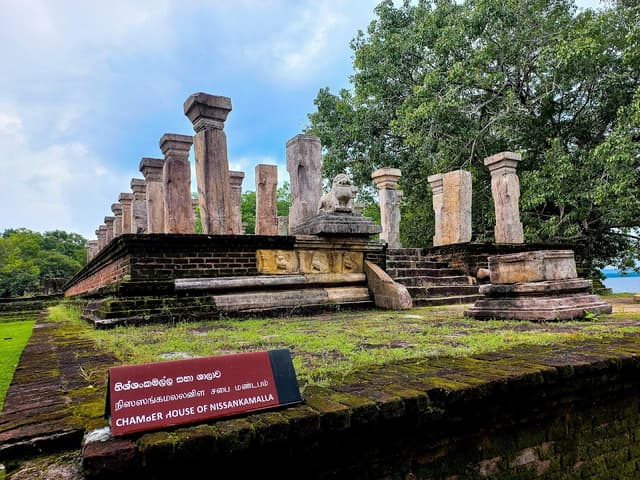
Deepa Uyana and Nissankamalla Palace
@ravinkavish
Deepa Uyana, located in the ancient city of Polonnaruwa, Sri Lanka, is an ancient garden complex that adds a serene, lush element to the historical site. This tranquil area, which is believed to have been used as a royal garden, is part of the grand design of Polonnaruwa’s sacred and royal precincts.
The garden is most notable for its well-maintained water features, including a large pond, intricate water channels, and water fountains that reflect the advanced hydraulic engineering of the time. The landscape is beautifully complemented by various stone carvings and sculptures, and it is often associated with the reign of King Parakramabahu I, who is known for his remarkable contributions to the city's development.
**Pro tip:** Deepa Uyana offers a peaceful retreat with its lush greenery and serene atmosphere, making it a perfect spot for a quiet walk or meditation. Don’t forget to take in the beauty of the ancient water features and the harmony between nature and architecture. Early mornings or late afternoons are the best times to visit, as the weather is cooler, and the light creates a beautiful effect on the surrounding ruins.
Add to
Details

Kumara Pokuna - 32 (Pond)
@ravinkavish
Highly Recommended Kumara Pokuna, also known as the "32-Pond," is a charming relic from the Polonnaruwa era. This ancient pond, built during the reign of King Parakramabahu I in the 12th century, was part of a sophisticated water management system that the king implemented to support his massive irrigation projects. The pond itself is quite striking with its large, rectangular shape and neatly carved stone edges. It’s surrounded by ruins that hint at the original grandeur of the area. The intricate stonework and well-preserved design make it a fascinating spot for history buffs and those curious about ancient engineering. What makes Kumara Pokuna particularly interesting is its role in the royal bathing rituals and ceremonies. The pond was not just functional but also a part of the royal and religious life of the time. It’s easy to imagine the elaborate ceremonies that would have taken place here, with the king and his court using the pond as a backdrop. Visiting Kumara Pokuna offers a peaceful retreat with fewer crowds, making it a great spot to reflect on the ingenuity of ancient Sri Lankan civilization while enjoying the serene surroundings.
Add to
Details

Pabalu Vehera
@ravinkavish
Pabalu Vehera, located in the ancient city of Polonnaruwa, Sri Lanka, is an important and serene Buddhist stupa with a fascinating history. It is believed to have been constructed by King Parakramabahu I in the 12th century, making it one of the many remarkable structures built during his reign. The name "Pabalu Vehera" translates to "The Stupa of Pearl," likely referring to its historical association with relics and the treasure of ancient Buddhist monks.
Though smaller than some of the other stupas in the region, Pabalu Vehera is noted for its unique charm and peaceful surroundings. The stupa is surrounded by lush greenery and well-maintained grounds, offering visitors a tranquil place to reflect and enjoy the spiritual ambiance.
**Pro tip:** The relatively quieter nature of Pabalu Vehera, compared to the larger stupas of Polonnaruwa, makes it an excellent spot for those seeking a peaceful experience away from the crowds. Explore the surrounding area for other historical ruins and enjoy the calming atmosphere of this sacred site.
Add to
Details

Palace Complex of King Nissankamalla
@ravinkavish
The Palace of King Nissanka Malla, located in the ancient city of Polonnaruwa, Sri Lanka, is an impressive structure that dates back to the 12th century. Built by King Nissanka Malla, who ruled Sri Lanka from 1187 to 1196, the palace reflects the grandeur and architectural skill of the time.
The palace was once a majestic royal residence, but today, only the ruins remain. The layout of the palace consists of a large rectangular complex with an inner courtyard and numerous rooms. Some parts of the palace, like the stone stairways and walls, are still quite well-preserved, offering visitors a glimpse of the palace's former splendor. The site also features intricately carved stonework and decorative pillars, which are testament to the artistic abilities of ancient Sri Lankan craftsmen.
**Pro tip:** When visiting the Palace of King Nissanka Malla, be sure to explore the surrounding area, as the site is part of a larger archaeological zone in Polonnaruwa. Don’t miss the stunning stone carvings and detailed artwork that remain on the walls, and imagine the vibrant royal life that once unfolded here. The palace is best visited early in the day to avoid the heat and to enjoy the peaceful atmosphere of this historic site.
Add to
Details

Vatadage
@ravinkavish
Vatadage, located in the ancient city of Polonnaruwa, Sri Lanka, is a beautifully preserved and historically significant circular structure. Built during the reign of King Parakramabahu I in the 12th century, it is one of the most outstanding examples of Sri Lankan architecture from the medieval period.
Vatadage is a unique and impressive structure designed to house sacred relics. The circular building is surrounded by a stone platform with four entryways, each guarded by intricately carved guard stones. At the center of the platform is a stone platform that once supported a large stupa, although it is now in ruins. The most striking feature of the Vatadage is the stunning stone carvings, especially of Buddha statues, which adorn the inner walls.
**Pro tip:** When visiting Vatadage, take time to explore the fine details of the carvings and the layout of the site. The peaceful ambiance and architectural beauty make it a perfect spot for reflection and photography. Visit early in the morning to avoid the heat and experience the serenity of the ancient ruins in a quiet setting.
Add to
Details
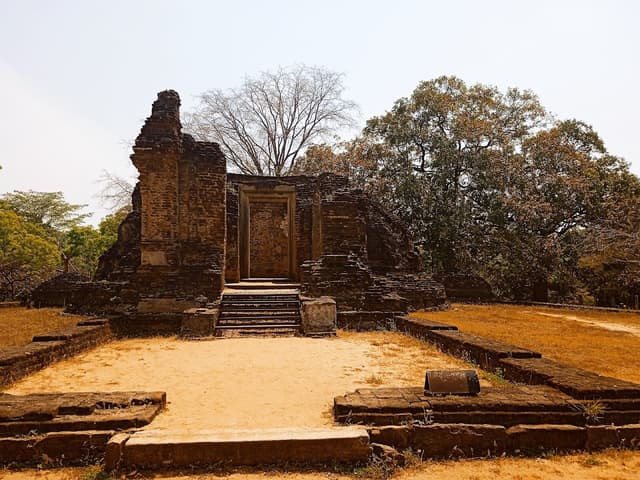
Potgul Temple
@ravinkavish
Highly Recommended Potgul Temple, tucked away in Polonnaruwa, is a hidden gem with a fascinating history. This temple, dating back to the 12th century, was originally built by King Parakramabahu I. It's known for its unique design and intriguing layout, which make it stand out among other ancient sites. One of the highlights of Potgul Temple is its unusual architecture. The temple features a circular structure with a central stupa and surrounding chambers. This layout is quite different from typical temple designs, giving it a distinctive character. The temple’s design is believed to have been influenced by ancient Buddhist practices and architectural styles. Another notable feature is the well-preserved carvings and stonework. The intricate details in the stone, even though weathered by time, still showcase the craftsmanship of the era. As you wander through the site, you’ll notice the serene and contemplative atmosphere, which adds to its charm. Potgul Temple is also a great spot to escape the more crowded tourist sites. It offers a peaceful environment where you can immerse yourself in the history and beauty of ancient Sri Lankan architecture. If you’re into exploring less-traveled paths and uncovering hidden treasures, Potgul Temple is definitely worth a visit.
Add to
Details

Sigiriya Town
@ravinkavish
Sigiriya Town, located in the heart of Sri Lanka's cultural triangle, is a charming and vibrant destination with much to offer. Famous for the iconic Sigiriya Rock Fortress, this town is a hub for history, culture, and nature. Sigiriya is a UNESCO World Heritage Site and attracts travelers with its ancient ruins, beautiful gardens, and panoramic views from the top of the rock.
The town itself is peaceful, with plenty of accommodation options, local markets, and eateries offering traditional Sri Lankan cuisine. Sigiriya is also surrounded by lush forests, tranquil lakes, and smaller sites like the Pidurangala Rock, providing visitors with plenty of opportunities for exploration.
**Pro tip:** Visit early in the morning or late afternoon to avoid crowds at Sigiriya Rock and enjoy cooler weather. If you have extra time, explore nearby sites like the ancient city of Polonnaruwa or Minneriya National Park for a full cultural and natural experience. Sigiriya Town is the perfect base for adventurers and history buffs alike.
Add to
Details

Sigiriya Lion Rock
@ravinkavish
Sigiriya Lion Rock, one of Sri Lanka's most iconic landmarks, is a must-visit destination for history and nature lovers alike. This ancient rock fortress rises 200 meters above the surrounding jungle and offers breathtaking panoramic views from the top. Sigiriya is renowned for its impressive architecture, frescoes, and the giant lion's paws that once guarded the entrance to the summit.
The fortress dates back to the 5th century AD, built by King Kashyapa as a royal palace and fortress. As you ascend the rock, you’ll pass through lush gardens, ancient water features, and well-preserved frescoes that depict celestial maidens. The climb to the top is a bit challenging but rewarding, with stunning views of the surrounding landscapes and the nearby Pidurangala Rock.
**Pro tip:** Arrive early to avoid the midday heat and crowds. The best time for a visit is during the early morning or late afternoon when the light creates perfect conditions for photography. Sigiriya Lion Rock is a UNESCO World Heritage site, offering a fascinating blend of history, culture, and natural beauty.
Add to
Details

Little Pidurangala
@ravinkavish
Little Pidurangala, also known as Mapagala, is a hidden gem just 750 meters from Sigiriya Rock, offering a quieter and equally stunning alternative. This ancient site, once a part of King Kashyapa's defensive fortifications, is a fascinating mix of history and nature. The climb is shorter than Pidurangala, making it perfect for those seeking a less strenuous adventure.
At the summit, you’ll be rewarded with unobstructed views of Sigiriya Rock rising majestically above the lush jungle—a photographer’s dream. The area feels untouched, with fewer crowds, giving it a peaceful and almost secret vibe.
Pro tip: Visit during sunrise or sunset for the most magical views. Little Pidurangala is perfect for travelers who love off-the-beaten-path experiences with a touch of history and breathtaking scenery.
Add to
Details
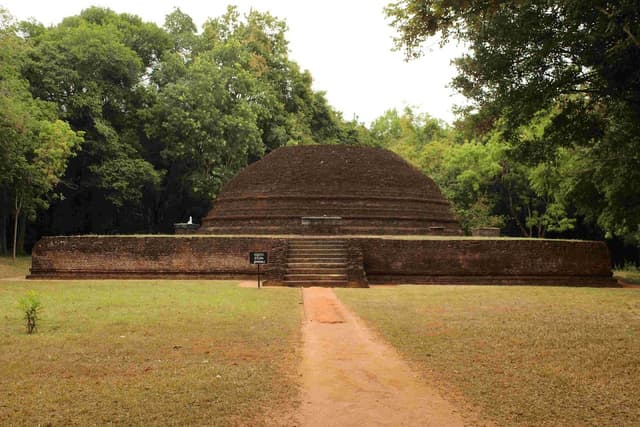
Pidurangala Old Dageba
@ravinkavish
Add to
Details

Dambulla Royal Cave Temple and Golden Temple
@ravinkavish
Dambulla Golden Temple, located at the base of the Dambulla Rock, is an iconic Buddhist site known for its striking golden statue of the Buddha that stands 29 meters tall. The temple is part of the Dambulla Royal Cave Temple complex, but it stands out due to its modern golden exterior and peaceful atmosphere.
Visitors can explore the surrounding temple grounds, which include a large hall filled with beautiful murals and statues of Buddha. The area offers stunning views of the nearby rock and countryside. The temple is a serene spot for reflection, making it a great place to learn more about Sri Lanka’s spiritual heritage.
Pro tip: Visit early to avoid crowds and take in the morning light on the golden statue. The Dambulla Golden Temple is perfect for travelers interested in Buddhist art, history, and stunning architecture.
Add to
Details

Pidurangala Rock
@ravinkavish
Pidurangala Rock is a stunning natural landmark located just a few kilometers from the iconic Sigiriya Lion Rock. Known for its panoramic views, Pidurangala offers a less crowded alternative to its famous neighbor while still delivering breathtaking vistas of the Sigiriya Rock Fortress and the surrounding jungle.
The climb to the top is an adventurous one, taking you through a mix of jungle paths, boulders, and rock ledges. Along the way, you'll encounter a small Buddhist temple, adding a touch of history and spirituality to the hike. The summit of Pidurangala provides sweeping views of Sigiriya, the surrounding countryside, and distant mountain ranges—an excellent spot for sunrise or sunset.
**Pro tip:** The hike up Pidurangala Rock is shorter but steeper than Sigiriya, and it's much quieter, allowing for a more peaceful experience. To get the best views of Sigiriya, climb early in the morning or late in the afternoon. Pidurangala is the perfect destination for those looking to enjoy both nature and history without the crowds.
Add to
Details

Minneriya National Park
@ravinkavish
Minneriya National Park is a wildlife hotspot, famous for hosting the world-renowned "Elephant Gathering," where hundreds of elephants gather around the Minneriya Tank during the dry season (July to October). It's one of the best places in Sri Lanka to see wild elephants in their natural habitat. Along with elephants, you might encounter toque macaques, sambar deer, and even crocodiles lurking near the water. The park is also home to colorful bird species like kingfishers and painted storks.
Pro tip: An afternoon safari offers the best chance to see elephants and other wildlife as they come to the tank to drink. The park’s open landscapes and forest patches create the perfect setting for unforgettable wildlife sightings and stunning sunset views.
Add to
Details

Kalawewa National Park
@ravinkavish
Kalawewa National Park, located in the North Central Province of Sri Lanka, is a serene and lesser-known gem for nature lovers and wildlife enthusiasts. The park surrounds the Kalawewa Reservoir, one of the oldest and largest irrigation tanks in Sri Lanka, which was originally constructed by King Dhatusena in the 5th century CE.
The park is home to a diverse range of flora and fauna, including a variety of birds, mammals, and reptiles. The reservoir itself attracts numerous bird species, particularly during migratory seasons, making it a prime spot for birdwatching. The park is also known for its elephant population, which can often be spotted around the reservoir and in the surrounding forested areas. Other wildlife includes deer, wild boar, and a range of smaller animals like monkeys and lizards.
The Kalawewa Reservoir plays a crucial role in the local ecosystem and has become a hub for fishing, boating, and peaceful retreats. It’s an ideal location for those seeking a more tranquil experience compared to other more heavily visited parks.
**Pro tip:** The park is not as crowded as some other national parks in Sri Lanka, providing a more peaceful experience. Early mornings or late afternoons offer the best chances for wildlife sightings. You can also enjoy a boat ride on the reservoir, which gives you a chance to spot birds and enjoy the beauty of the surrounding landscape.
Add to
Details

Kalawewa National Park Camping point
@ravinkavish
Add to
Details

Kalawewa Kayaking
@ravinkavish
Kalawewa Kayaking is a tranquil adventure that takes you across the historic waters of the Kalawewa Reservoir, built in the 5th century by King Dhatusena. This engineering marvel, part of an ancient irrigation network, still nourishes the surrounding landscapes. As you paddle through its calm waters, you’ll feel a connection to Sri Lanka’s rich history while enjoying breathtaking views, including the towering Avukana Buddha statue nearby.
Wildlife adds to the magic—spot herds of giant elephants grazing near the banks, water buffalo cooling off, and crocodiles basking in the sun. Bird enthusiasts can look out for pelicans, herons, and kingfishers gliding above.
Pro tip: Early mornings or late afternoons are ideal for kayaking, offering cooler weather, peaceful vibes, and the best chances for wildlife sightings. Kalawewa combines adventure, natural beauty, and a deep sense of history, making it an unforgettable experience for any traveler.
Add to
Details

Sigiriya Entrance 2
@ravinkavish
Add to
Details

Dambulla Somawathi Stupa
@ravinkavish
Add to
Details

Ederagala Wana Senasuna
@ravinkavish
Add to
Details

Galkoth Kanda Mountain Peak
@ravinkavish
Add to
Details

Avukana Buddha Statue
@ravinkavish
The Avukana Buddha Statue, located in the Kala Wewa region of Anuradhapura, is one of Sri Lanka’s most iconic and largest standing Buddha statues. Dating back to the 5th century CE, this majestic statue is believed to have been carved during the reign of King Dhatusena (455–473 CE), and it stands at a height of about 13 meters (43 feet).
The statue is renowned for its impressive craftsmanship and serene posture, symbolizing both strength and tranquility. Carved from a single granite rock, the Buddha stands in a dignified Abhaya Mudra (gesture of fearlessness), offering a sense of peace and protection to all who visit. The statue is set against a backdrop of lush greenery, adding to the spiritual ambiance of the site.
Avukana is not only an important religious site but also an excellent example of ancient Sri Lankan art and engineering. The beauty of the statue and the surrounding area draws visitors seeking both cultural insight and natural serenity.
**Pro tip:** Visit early in the morning or late afternoon to enjoy the cooler weather and capture stunning photos of the statue with the soft light. The surrounding area offers a tranquil atmosphere perfect for reflection. The nearby Kala Wewa Reservoir adds to the site's charm, offering a peaceful place to relax after visiting the statue.
Add to
Details

Anuradhapura
@ravinkavish
Anuradhapura, one of Sri Lanka's most iconic ancient cities, is a UNESCO World Heritage Site and the heart of the island's rich cultural and spiritual heritage. Established in the 4th century BCE, it served as the capital of Sri Lanka for over 1,300 years, showcasing a golden era of art, architecture, and Buddhism.
The city is famed for its sprawling ruins, including majestic stupas like **Ruwanwelisaya** and **Jetavanaramaya**, ancient monasteries, and sacred sites like the **Sri Maha Bodhi**, a revered fig tree believed to be the oldest living tree planted by humans, dating back to 288 BCE. The irrigation marvels, including massive tanks like **Tissa Wewa**, reflect the advanced engineering skills of its ancient inhabitants.
**Pro tip:** Explore Anuradhapura by bicycle or tuk-tuk to fully immerse yourself in its historical grandeur. Don't miss sunrise or sunset at one of the stupas, where the golden light enhances the mystical aura of this ancient city.
Add to
Details

Vessagiriya | වෙස්සගිරිය - අනුරාධපුරය
@ravinkavish
Add to
Details

Isurumuniya Temple
@ravinkavish
Isurumuniya Temple, located near the famous sacred city of Anuradhapura, is one of Sri Lanka's most captivating historical and cultural landmarks. Dating back to the 3rd century BCE, it was originally established by King Devanampiyatissa. The temple is known for its stunning rock carvings and unique architectural features, including a serene pond and intricately designed stone sculptures.
The temple’s most famous feature is the "Isurumuniya Lovers" sculpture, a well-known piece of ancient art depicting a couple in a loving embrace, which is widely considered a masterpiece of Sri Lankan rock art. Another notable attraction is the temple's beautiful frescoes and stone carvings of animals and religious symbols.
Pro tip: When visiting Isurumuniya Temple, make sure to explore the tranquil surroundings and take time to appreciate the ancient rock carvings. The peaceful environment and rich history make it an excellent spot for reflection and photography, especially for those interested in Sri Lanka's artistic and cultural heritage.
Add to
Details

Star Gate - Ranmasu Uyana
@ravinkavish
The Star Gate, located in Ranmasu Uyana, is one of Sri Lanka's most fascinating and mysterious ancient sites. Ranmasu Uyana, also known as the "Royal Pleasure Gardens," is an archaeological park in Anuradhapura, which was once a royal garden used by the kings of ancient Sri Lanka. The Star Gate is an intriguing structure, believed by some to be an astronomical observatory or a ceremonial gateway.
The Star Gate is a large stone arch with carvings that some researchers suggest may have been aligned with celestial events, such as the movement of stars or the solstices. Its exact purpose remains a mystery, but it is widely believed to have been a significant site for ancient Sri Lankan astronomy or religious rituals.
Pro tip: When visiting the Star Gate, take time to appreciate the intricate stone carvings and the peaceful garden setting. It’s an excellent spot for history enthusiasts and those interested in the mysteries of ancient Sri Lanka. The site offers a glimpse into the sophisticated knowledge and cultural practices of the ancient kingdom.
Add to
Details
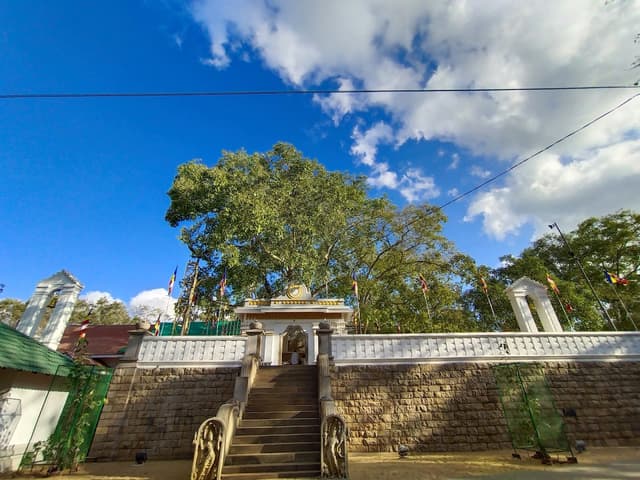
Jaya Sri Maha Bodhi
@ravinkavish
Jaya Sri Maha Bodhi, located in Anuradhapura, is one of the most sacred and revered sites in Sri Lanka and the world’s oldest historically documented tree. It is a direct descendant of the tree under which the Buddha attained enlightenment in Bodh Gaya, India. The tree was planted in 288 BCE by King Devanampiyatissa, making it over 2,300 years old.
This sacred Bodhi tree is situated in a beautifully serene environment within the Mahamewna Gardens and is surrounded by various shrines and monuments. Pilgrims from all over the world come to pay homage and meditate under its branches, as it is considered a symbol of peace, enlightenment, and spiritual strength.
Pro tip: When visiting Jaya Sri Maha Bodhi, take time to quietly reflect and experience the spiritual ambiance. The site is particularly beautiful during early mornings or evenings when the soft light and peaceful surroundings create a calm, meditative atmosphere. It’s a must-visit for anyone exploring Sri Lanka’s deep Buddhist heritage.
Add to
Details

Lovamahapaya
@ravinkavish
Lovamahapaya, also known as the "Brazen Palace," is an ancient structure located in Anuradhapura, Sri Lanka. Built by King Dutugemunu in the 2nd century BCE, this five-story building was originally intended as a residence for monks, and it was one of the most magnificent architectural feats of its time. The name "Brazen Palace" refers to the brass or bronze roof tiles that once covered the structure, giving it a golden, radiant appearance in the sunlight.
The building was made from timber and stone, and although only the foundations and some columns remain today, its size and design are still awe-inspiring. The palace originally housed over 1,000 monks and was a key center of learning and religious practice.
Pro tip: When visiting Lovamahapaya, take a moment to appreciate the size and scale of the ruins and imagine how grand it must have been in its prime. The site offers stunning views of the surrounding area, including the nearby Ruwanweli Maha Seya and other important historical landmarks. It's a must-see for anyone interested in Sri Lanka’s ancient architecture and Buddhist heritage.
Add to
Details

Ruwanweli Maha Seya
@ravinkavish
Ruwanweli Maha Seya, located in Anuradhapura, is one of Sri Lanka's most iconic and revered Buddhist stupas. Built by King Dutugemunu in 140 BCE, it stands as a symbol of the king's victory and devotion to Buddhism. This majestic stupa, with its impressive height and serene surroundings, is considered one of the largest and most significant stupas in Sri Lanka.
The Ruwanweli Maha Seya is an architectural marvel, with its perfectly symmetrical dome and ancient inscriptions that reflect the rich history of the area. Pilgrims and travelers alike visit the stupa to pay homage, and it remains a peaceful and spiritual site where visitors can soak in the history and tranquility of the ancient kingdom.
Pro tip: When visiting, take time to walk around the stupa, paying respect to the sacred site, and explore the nearby ancient ruins of Anuradhapura. The stupa is a key part of Sri Lanka's cultural heritage and is an essential stop for those exploring the island's history and Buddhist traditions.
Add to
Details
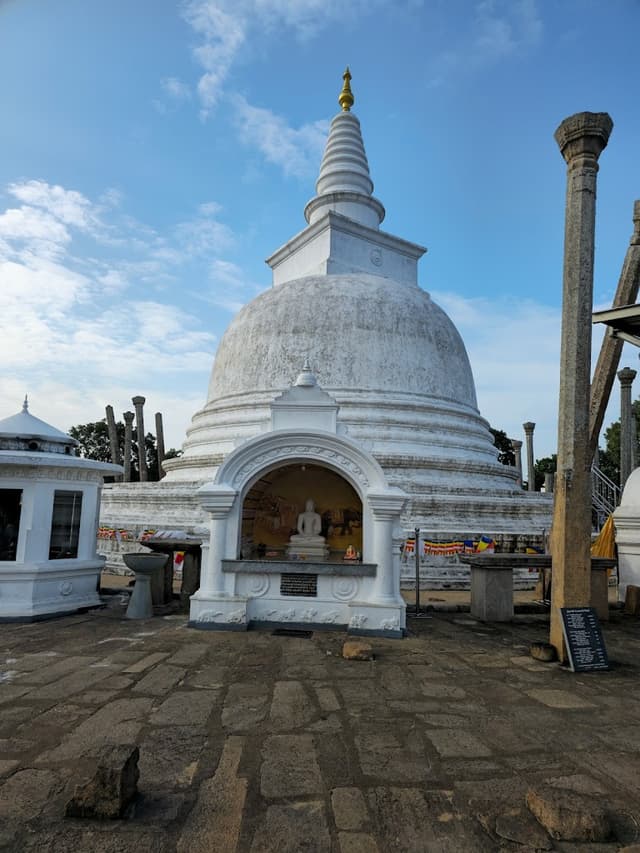
Thuparamaya
@ravinkavish
Thuparamaya, located in Anuradhapura, is one of Sri Lanka's oldest and most sacred Buddhist stupas. It was the first stupa built after the introduction of Buddhism to Sri Lanka by Emperor Ashoka’s missionary, Mahinda, in 247 BCE. Thuparamaya is said to house a relic of the Buddha, making it a significant pilgrimage site for Buddhists.
The stupa's simple yet striking design features a large white dome, which has been beautifully preserved over the centuries. Its historical and religious importance is further highlighted by the ancient stone pillars surrounding the site, which are remnants of the original structure built by King Devanampiyatissa.
Pro tip: While visiting Thuparamaya, take time to appreciate the tranquil surroundings and the rich history of this sacred site. It's a must-see for anyone interested in Sri Lanka’s Buddhist heritage and the early days of Buddhism on the island. The peaceful atmosphere makes it an ideal spot for reflection and exploration.
Add to
Details

Elephant Pond
@ravinkavish
The Elephant Pond, located in Anuradhapura, is a remarkable and historically significant site from ancient Sri Lanka. It is one of the large ceremonial bathing ponds built during the Anuradhapura Kingdom, believed to have been used by the royal family and monks for ritualistic bathing and purification purposes. The pond is named for its large size, which could accommodate a large number of elephants that were bathed and cleaned there during royal processions and ceremonies.
The Elephant Pond is expertly designed with stone steps leading to the water and is surrounded by intricately carved stonework, showcasing the advanced hydraulic engineering of the time. Its serene surroundings and historical significance make it a fascinating place to visit.
Pro tip: When visiting the Elephant Pond, take time to explore the pond’s spacious layout and enjoy the peaceful atmosphere. It’s a great spot for photography, especially with its historical ruins and tranquil environment. It offers a unique glimpse into the royal and ceremonial life of ancient Sri Lanka.
Add to
Details
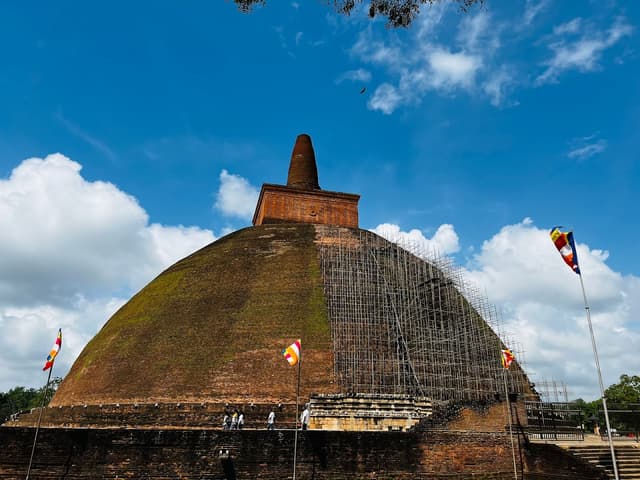
Abhayagiriya
@ravinkavish
Abhayagiriya, located in Anuradhapura, is one of the most significant monastic complexes of ancient Sri Lanka, renowned for its historical and archaeological value. Built by King Vattagamani Abhaya (also known as King Valagamba) in the 1st century BCE, it was once a thriving Buddhist center and a major hub for religious learning, with a vast library and thousands of monks residing there.
Abhayagiriya is known for its impressive ruins, including an enormous stupa, stone inscriptions, and remnants of monastic buildings, all set amidst a peaceful and expansive area. The stupa, though not as large as the Ruwanweli Maha Seya, is significant for its historical context and role in the island's Buddhist heritage.
Pro tip: When visiting Abhayagiriya, take time to explore the well-preserved ruins and imagine the bustling spiritual life that once took place here. The site provides a fascinating glimpse into the early days of Buddhism in Sri Lanka, and the serene atmosphere makes it an excellent place for reflection and exploration.
Add to
Details

Twin ponds (Kuttam Pokuna)
@ravinkavish
Kuttam Pokuna, also known as the Twin Ponds, is an exceptional ancient bathing complex located in Anuradhapura. These two beautifully crafted ponds, which date back to the 8th century, were part of the royal monastery and are considered a marvel of ancient engineering. The ponds are meticulously designed with fine stone carvings and steps leading to the water, showcasing the advanced hydraulic knowledge of the time.
The larger pond is rectangular, while the smaller one is round, and both are fed by a sophisticated system of channels and reservoirs. The Twin Ponds were used for ceremonial bathing by the monks and royal figures, and their well-preserved state offers insight into the artistic and architectural achievements of ancient Sri Lanka.
Pro tip: When visiting Kuttam Pokuna, take time to admire the intricate stonework and the serene atmosphere around the ponds. It's a peaceful spot for photography, offering a unique view of ancient Sri Lankan design and a quiet retreat from the busy city. The ponds are particularly beautiful during the early morning or late afternoon light.
Add to
Details

Dalada Maligawa Anuradhapura
@ravinkavish
Add to
Details

Jethawanaramaya
@ravinkavish
Jetavanaramaya, located in Anuradhapura, is one of the largest and most impressive ancient stupas in Sri Lanka. Built by King Mahasena in the 3rd century CE, it was originally the tallest structure in the world, standing at 122 meters (400 feet). The stupa was constructed as a tribute to Lord Buddha and is one of the most important landmarks of Anuradhapura's historical city.
Jetavanaramaya is renowned for its size, both in terms of height and volume. The stupa is encircled by ancient ruins, including remnants of monastic buildings and meditation chambers. The site once housed relics of the Buddha and was a major center for Buddhist learning.
Pro tip: Visit Jetavanaramaya to marvel at the scale and grandeur of this ancient monument. While much of the stupa’s original splendor has faded, its enormous size and the surrounding ruins offer an awe-inspiring glimpse into the architectural achievements of ancient Sri Lanka. It’s a must-visit for history enthusiasts and those keen on exploring the cultural heritage of Sri Lanka’s ancient capitals.
Add to
Details

Ranmasu Uyana (Royal Park)
@ravinkavish
'Ran Masu Uyana' or it is know as the 'Royal Garden' used by the Kings of Sri Lanka for centuries was built by King Devanampiya Tissa in the 3rd Century BC. The pleasure pavilions, ponds etc. other fixtures seen to-date were built during the 8-9 centuries AD which gives an idea for how long this has been used by various kings and their family members. In Sinhala language 'Ran Masu' stands for 'Gold Fish' which may have had exotic fish at the time. The world famous #stargate can be seen with encircled figures of fish as well. This Royal garden is a key example of Sri Lankan garden architecture.
Add to
Details

Jethawanaramaya
@ravinkavish
Jetavanaramaya, located in Anuradhapura, is one of the largest and most impressive ancient stupas in Sri Lanka. Built by King Mahasena in the 3rd century CE, it was originally the tallest structure in the world, standing at 122 meters (400 feet). The stupa was constructed as a tribute to Lord Buddha and is one of the most important landmarks of Anuradhapura's historical city.
Jetavanaramaya is renowned for its size, both in terms of height and volume. The stupa is encircled by ancient ruins, including remnants of monastic buildings and meditation chambers. The site once housed relics of the Buddha and was a major center for Buddhist learning.
Pro tip: Visit Jetavanaramaya to marvel at the scale and grandeur of this ancient monument. While much of the stupa’s original splendor has faded, its enormous size and the surrounding ruins offer an awe-inspiring glimpse into the architectural achievements of ancient Sri Lanka. It’s a must-visit for history enthusiasts and those keen on exploring the cultural heritage of Sri Lanka’s ancient capitals.
Add to
Details

Kaudulla National Park
@ravinkavish
Kaudulla National Park, located in the north-central region of Sri Lanka, is a haven for nature lovers and wildlife enthusiasts. The park is known for its large population of elephants, particularly during the dry season when hundreds of elephants gather around the park’s reservoirs to drink and bathe. It is one of the best places in Sri Lanka to see wild elephants up close in their natural habitat. In addition to elephants, the park is home to a variety of other wildlife including deer, leopards, and an impressive array of bird species, making it a fantastic destination for birdwatchers as well.
The park itself is lush with dry zone forest, grasslands, and wetlands, offering diverse ecosystems that attract a range of animals and plants. Kaudulla is less crowded compared to other popular national parks like Yala or Udawalawe, offering a more peaceful and immersive safari experience. The park is also connected to Minneriya National Park, and the two parks form a crucial wildlife corridor.
Pro Tip: Kaudulla is easily accessible from the town of Habarana, making it a convenient stop for those exploring Sri Lanka’s cultural triangle. A visit here provides an opportunity to experience the island's rich wildlife and natural beauty.
Add to
Details

Bahirawakanda Temple
@ravinkavish
Add to
Details

Kataragama Devalaya
@ravinkavish
Add to
Details

St Paul's Church, Kandy
@ravinkavish
St. Paul’s Church in Kandy is a historical Anglican church that stands as a quiet testament to the colonial era and the city’s multicultural heritage. Located adjacent to the Temple of the Sacred Tooth Relic, this charming church offers a fascinating contrast to the Buddhist temples of Kandy while sharing in the spiritual tranquility of the area.
Built between 1843 and 1852, during the British colonial period, St. Paul’s Church served as a place of worship for British officers and residents. Its neo-Gothic architecture, featuring stained glass windows, intricate wooden pews, and a stately bell tower, reflects classic British ecclesiastical designs of the 19th century. The interior is serene and simple, with polished wooden beams and a peaceful ambiance ideal for reflection.
The church is still active today, hosting services and welcoming visitors of all faiths. Its proximity to the Temple of the Sacred Tooth Relic makes it a unique stop for travelers exploring the rich spiritual and cultural tapestry of Kandy.
**Pro tip:** After visiting the church, enjoy a leisurely walk around Kandy Lake, located just across the road, to soak in the serene beauty of the hill capital. Don’t forget to check the service schedule if you’d like to attend a traditional Anglican worship session.
Add to
Details

Ehelepola Walawwa
@ravinkavish
This under-rated site now been used as an administrative office by the Archaeology Department in Rathnapura. This is the "Consorts" Castle of Ehelepola Nilame (1773 – 1829) was a courtier of the Kingdom of Kandy. He was the first Adigar (a role which combined the powers of a prime minister and a chief justice) from 1811 to 1814 under the reign King Sri Vikrama Rajasinha (Last King of the country). He was appointed by the king as the Disawe (local governor) of Sabaragamuva. His Mansion (Walawwa) is separate from this Mansion which is currently the house to Rathnapura Museum. Apart from this he has a separate mansion built in Kandy as well. Not even the King had a structure of this magnitude for his consorts during the Kandyan era. Wooden teak floors and the Architecture resembles the meticulously given details when building the mansion which was housed to the British agents since 1917 after the fall of the Kandyan Kingdom and its ruling provinces to the British Empire.
Add to
Details
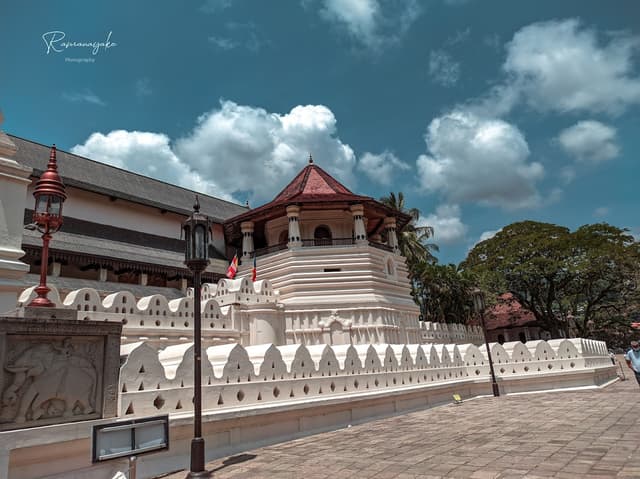
Sri Dalada Maligawa
@ravinkavish
The Sri Dalada Maligawa, or Temple of the Sacred Tooth Relic, is one of the most revered Buddhist sites in the world, located in the heart of **Kandy**. This temple is home to the Tooth Relic of Lord Buddha, an artifact that holds immense spiritual and historical significance to Buddhists in Sri Lanka and around the world. The relic is believed to have been brought to Sri Lanka in the 4th century and has played a key role in the island’s religious and political history.
The temple itself is a stunning example of Kandyan architecture, with intricate wooden carvings, golden embellishments, and beautifully decorated interiors. The Inner Chamber, where the Tooth Relic is kept, is carefully guarded and is only opened during religious ceremonies. Devotees from across the world come to offer their prayers, and special rituals, such as the Dalada Perahera (a grand procession), are held annually in July and August to honor the relic.
The Sri Dalada Maligawa is located near Kandy Lake, which adds to the tranquil and sacred atmosphere of the temple. Visitors can explore the various halls, courtyards, and shrines within the complex, each with its own cultural and historical importance.
**Pro tip:** When visiting, ensure you dress modestly as the temple is a sacred site. Also, consider visiting during the evening for the special puja (prayer) ceremony to witness the religious rituals surrounding the sacred relic.
Add to
Details

Kandy City Centre
@ravinkavish
Add to
Details

Queen's Palace - Madawasala
@ravinkavish
“Medavasala” which is the Queen’s Chamber. Residence of Queen Venkatha Ranga Jammal (Rengammal) the last Queen of the King Sri Wickrama Rajasinghe (1798-1815 AD) who is also the last King of the Kandyan Kingdom before it fell to the hands of the British empire in 1815. The entrance door to the Queen’s chamber exemplifies the exquisite features of the Kandyan period architecture and when the door is closed it can only be opened from the inside as a measure of security. The remains of a Urinal Stone can be seen as well in the chamber right along side her bed. All made of stone and wooden. Wooden pillars consists of rectangular and octangular sections with wood carvings.
Add to
Details
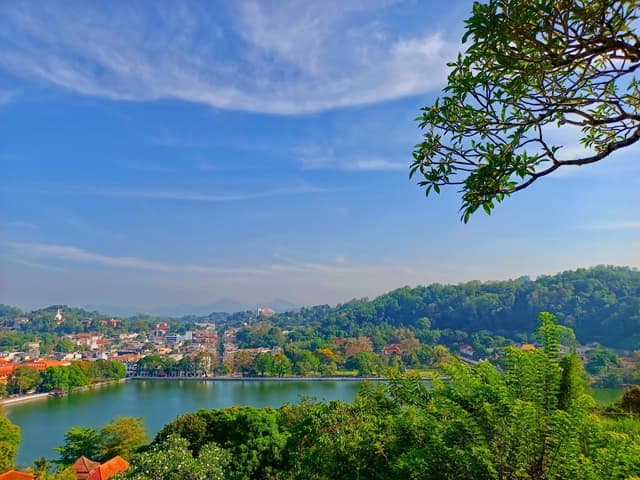
Kandy view point
@ravinkavish
Add to
Details

Kandy Lake Club - Cultural Dance Show
@ravinkavish
Add to
Details

Royal Botanic Gardens, Peradeniya
@ravinkavish
The Royal Botanic Gardens, Peradeniya, located just outside the bustling city of Kandy, is one of Sri Lanka's most renowned gardens and a must-visit for nature lovers and travelers. Spanning over 147 acres, this beautifully landscaped garden is home to more than 4,000 species of plants, including tropical and subtropical trees, palms, orchids, and medicinal plants. It offers a peaceful retreat, allowing visitors to immerse themselves in lush greenery while exploring its various themed sections.
The Royal Botanic Gardens have a rich history, dating back to the early 14th century when it was initially established as a royal garden by King Kirthi Sri Rajasinha in the 18th century. However, it was during the British colonial period that the gardens were expanded and modernized, making it one of the finest botanic gardens in Asia.
Among the most notable attractions within the garden is the Avenue of Royal Palms, which creates an impressive entryway, and the Orchid House, which showcases a stunning collection of orchids. There's also the Gingko Biloba Tree, believed to be over 2,000 years old, and the Cannonball Tree, known for its large, round fruits. The garden is also home to a variety of bird species, making it a fantastic spot for birdwatching.
One of the highlights is the Coconut Palm Collection, which is recognized as one of the most diverse in the world, and the Spice Garden, where visitors can learn about Sri Lanka's famous spices like cinnamon, cardamom, and pepper.
For those looking to enjoy a more leisurely experience, there are plenty of shaded paths, large grassy lawns perfect for picnics, and even boat rides on the nearby river.
**Pro tip:** The gardens are a great spot to take a relaxing walk or enjoy a peaceful afternoon picnic. If you're a nature or photography enthusiast, don’t forget your camera to capture the stunning flora and wildlife.
Add to
Details

Gadaladeniya Raja maha viharaya
@ravinkavish
Gadaladeniya Raja Maha Viharaya is a historic Buddhist temple located near Peradeniya in the Kandy District of Sri Lanka. Built in the 14th century, it is renowned for its unique architectural style that combines both Sinhalese and South Indian influences, reflecting the cultural exchanges between Sri Lanka and South India during that era.
The temple was constructed during the reign of King Bhuvanekabahu IV, and it is said to have been designed by a South Indian architect, Godaya, whose influence can be seen in the temple's intricate design. The structure is primarily made of stone and wood, with beautiful carvings and sculptures that showcase the skill of ancient artisans. One of the most notable features is the Vahalkada (porch), with its finely crafted stone pillars and beautiful arches.
The main attraction of the temple is the image house, where a serene statue of Buddha is housed, surrounded by vibrant frescoes depicting the life of the Buddha and other religious themes. The temple also has a stupa (sacred mound), which serves as a focal point for meditation and prayer.
Despite its relatively small size compared to other historical sites in Sri Lanka, Gadaladeniya Raja Maha Viharaya offers a peaceful and serene atmosphere, making it an ideal spot for reflection and exploration of Sri Lanka's rich Buddhist heritage.
**Pro tip:** Visitors to the temple can enjoy the surrounding natural beauty and take a short hike to Lankatilaka Viharaya, another significant temple located nearby, for a full experience of this religious and cultural area.
Add to
Details
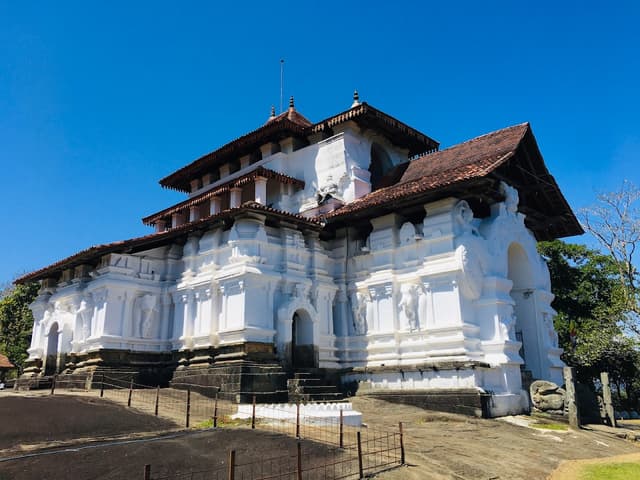
Sri Lankathilake Rajamaha Viharaya
@ravinkavish
Sri Lankathilake Rajamaha Viharaya, located in the historic town of Kandy, is an ancient Buddhist temple rich in history and architectural beauty. This serene temple is known for its impressive structure, which features intricate carvings, a large Buddha statue, and a stunning view of the surrounding hills and countryside. Its peaceful ambiance makes it a great spot for those interested in Sri Lanka’s religious heritage and architectural marvels.
Dating back to the 14th century, Sri Lankathilake Rajamaha Viharaya was built by King Parakramabahu VI and is one of the most significant temples in the region. It is also a great place to learn about Sri Lanka’s rich cultural and spiritual traditions.
**Pro tip:** While visiting the temple, take time to explore the surrounding area, which offers picturesque views and a tranquil atmosphere perfect for reflection and relaxation. The temple is best enjoyed during early morning or late afternoon when the weather is cooler, and the crowds are fewer.
Add to
Details
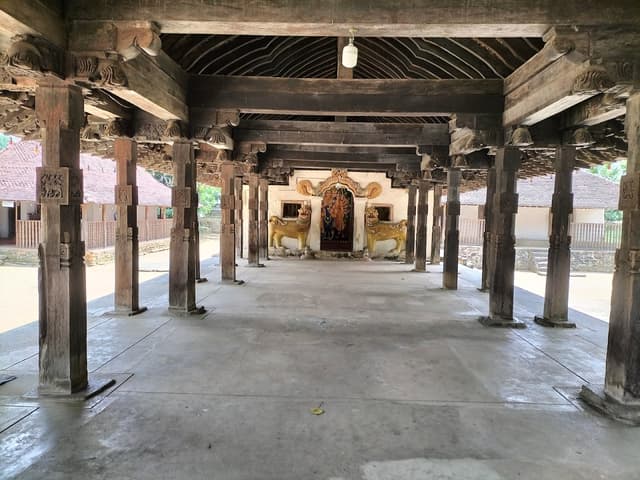
Embekka Dewalaya
@ravinkavish
Embekka Devalaya, located in the quaint village of Embekka near Kandy, is a masterpiece of ancient Sri Lankan woodcraft and cultural heritage. Built during the Gampola Kingdom in the 14th century by King Wickramabahu III, this shrine is dedicated to Kataragama Deviyo, a guardian deity in Sri Lankan tradition.
What makes Embekka truly remarkable is its intricately carved wooden pillars and beams. The carvings depict a variety of fascinating motifs, from floral designs to mythological figures, showcasing the exceptional skill of medieval Sri Lankan artisans. The Hall of Drummers (Digge), with its captivating wooden artistry, is particularly famous and draws admiration from art enthusiasts and travelers alike.
**Pro tip:** Visit during the morning to enjoy the serene atmosphere and the finer details of the woodwork in natural light. Pair your trip with visits to nearby cultural landmarks like Lankatilaka and Gadaladeniya temples for a deeper dive into Sri Lanka's rich history and art.
Add to
Details

Ambuluwawa Tower
@ravinkavish
The Ambuluwawa Tower, perched atop the Ambuluwawa Mountain near Gampola, is one of Sri Lanka's most breathtaking landmarks. This striking tower is part of the Ambuluwawa Biodiversity Complex, inaugurated in 2009 to promote environmental harmony and religious coexistence. The spiral design of the tower is inspired by a Buddhist stupa and symbolizes unity among the island’s diverse cultures and beliefs.
Climbing the tower is an exhilarating experience as the winding staircase narrows at higher altitudes, offering a thrilling ascent. Once at the top, you're rewarded with panoramic views of rolling hills, lush valleys, and distant peaks, including the Knuckles Mountain Range. The complex also features religious shrines representing Buddhism, Hinduism, Islam, and Christianity, emphasizing the area’s inclusive spirit.
**Pro tip:** Arrive early to beat the crowds and enjoy the sunrise, which paints the surrounding landscapes in stunning hues. The ascent can be challenging, so wear comfortable shoes and prepare for strong winds at the peak!
Add to
Details
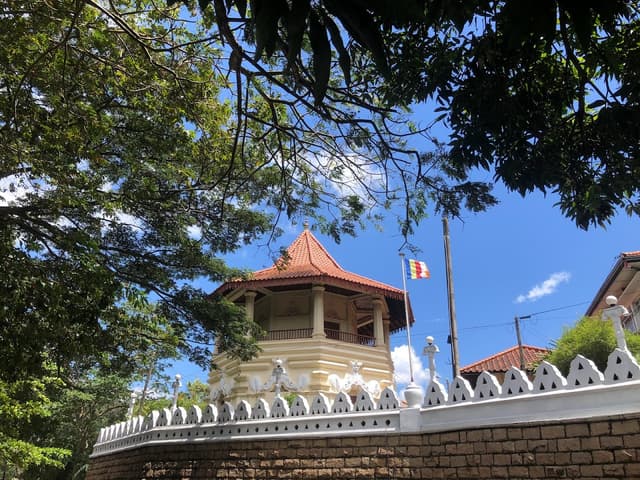
Malwatu Chapter Monastery
@ravinkavish
Add to
Details

Hanthana Mount Start Campus Road
@ravinkavish
Add to
Details

Hanthana Mountain View Point
@ravinkavish
Add to
Details

Hindagala Rajamaha Viharaya
@ravinkavish
Add to
Details

Katusu Konda trek start
@ravinkavish
Add to
Details

Katusu Konda
@ravinkavish
Add to
Details

Kandyan Cultural Centre
@ravinkavish
Highly Recommended for Culture Lovers
Cultural Performances Starts - 5:30 PM
Entrance Fee - 2500
One of the main attractions here is the traditional Kandyan dance performances. These shows are a high-energy mix of drumming, dancing, and acrobatics, featuring intricate costumes and colorful masks. It’s a fantastic way to experience Sri Lankan performing arts up close and feel the rhythm and energy of local traditions.
The center also offers a glimpse into traditional crafts. You can check out local artisans demonstrating their skills in areas like weaving, wood carving, and mask-making. It’s a cool chance to see how these ancient crafts are still practiced today.
The museum section of the center has displays of traditional Sri Lankan artifacts, including costumes, musical instruments, and ceremonial objects. It’s a great spot to learn about the cultural significance of these items and how they were used in ceremonies and daily life.
Overall, the Kandyan Cultural Centre is a vibrant hub for anyone looking to experience and understand the rich cultural heritage of Kandy. It’s lively, educational, and a lot of fun—perfect for getting a deeper dive into Sri Lankan culture.
Add to
Details

Asgiri Maha Vihara pirivena
@ravinkavish
Asgiri Maha Vihara Pirivena, located in the heart of Kandy, is one of the two main monastic complexes associated with the Sacred Temple of the Tooth Relic, the other being the Malwathu Maha Viharaya. This ancient monastery dates back to the 14th century, during the reign of King Parakramabahu IV, and has served as a center for Buddhist learning, meditation, and ritual for centuries.
The Asgiri Vihara is known for its serene setting, historic buildings, and its role in safeguarding Sri Lanka's Buddhist heritage. It plays a vital role in the annual Esala Perahera, one of the most significant cultural and religious festivals in Sri Lanka. The monks here are guardians of a part of the sacred Tooth Relic, which symbolizes the sovereignty of Sri Lanka.
The complex also features a pirivena (monastic school), where monks are trained in Buddhist doctrine and Pali studies. The architecture of the site reflects a mix of ancient and colonial influences, with well-preserved murals, statues, and stupas.
**Pro tip:** While visiting the Temple of the Tooth Relic, take time to explore the Asgiri Maha Vihara for a deeper understanding of Kandy’s religious significance. Pair it with a visit to the nearby Malwathu Maha Viharaya to see the two interconnected spiritual centers.
Add to
Details

Sri Vishnu Devalaya
@ravinkavish
The Sri Vishnu Devala in Kandy is a sacred shrine dedicated to Lord Vishnu, one of the most revered deities in Hinduism and an important guardian deity in Sri Lankan Buddhism. Known locally as the Maha Vishnu Devalaya, this historic temple is part of the Temple of the Sacred Tooth Relic complex and plays a vital role in the religious and cultural fabric of Kandy.
Believed to have been constructed during the Kandyan kingdom, the Devala is a place where both Hindus and Buddhists come to seek blessings and protection. Lord Vishnu is venerated here as a divine protector of Sri Lanka and as one who ensures the continuity of the Buddha's teachings on the island. The architecture of the shrine features traditional Kandyan styles, with ornate wooden carvings, decorative arches, and vibrant murals depicting Vishnu's role in Sri Lankan history and folklore.
The shrine is integral to the annual **Esala Perahera**, where offerings are made to Lord Vishnu before the procession begins. The rituals performed here reflect a harmonious blend of Hindu and Buddhist practices, showcasing Sri Lanka's rich cultural integration.
**Pro tip:** When visiting the nearby Temple of the Sacred Tooth Relic, take time to explore this lesser-known but spiritually significant shrine. Visitors should dress modestly and respect the sacred atmosphere of the site.
Add to
Details

Old Royal Palace
@ravinkavish
The Old Royal Palace of Kandy, located near the Temple of the Sacred Tooth Relic, is a magnificent remnant of Sri Lanka’s last kingdom. Built during the reign of the Kandyan kings, the palace was the official residence of the monarchs until the British captured the city in 1815, marking the end of an era.
The complex features traditional Kandyan architecture, with intricate woodwork, elegant courtyards, and structures that reflect the artistic and cultural achievements of the kingdom. While much of the palace has been affected by time and historical events, significant portions remain intact, giving visitors a glimpse into the grandeur of the Kandyan royal court.
The palace complex includes several significant structures, such as the Audience Hall, where royal ceremonies and discussions took place. This hall is particularly famous for its wooden pillars carved with exquisite floral and geometric patterns. Nearby, the Queen’s Chambers and other auxiliary buildings showcase the practical yet artistic design of the time.
Today, the Old Royal Palace serves as a museum and cultural site, offering insights into the history, art, and architecture of the Kandyan period.
**Pro tip:** Combine your visit to the palace with a trip to the adjacent Temple of the Sacred Tooth Relic for a comprehensive experience of Kandy’s royal and spiritual heritage. Don’t forget to take your time exploring the intricate carvings in the Audience Hall—they’re a photographer’s dream!
Add to
Details

Add to
Details

Open Air Museum - Temple of the Tooth
@ravinkavish
The Open Air Museum of the Temple of the Tooth, located near the iconic Sri Dalada Maligawa in Kandy, is a unique space that brings the cultural and historical essence of the Kandyan Kingdom to life. This outdoor museum showcases artifacts, statues, and artistic creations that complement the grandeur and spiritual significance of the Temple of the Sacred Tooth Relic.
The exhibits include intricately carved stone sculptures, ancient inscriptions, and replicas of significant elements related to the temple and the Kandyan era. The museum is designed to immerse visitors in the artistry and craftsmanship of the period, with many pieces highlighting the influence of Buddhism on Kandyan art and architecture.
The serene surroundings of the museum, with lush greenery and Kandy Lake nearby, make it a peaceful spot for reflection and learning. It's a perfect complement to a visit to the temple, providing deeper insights into the cultural and historical context of one of Sri Lanka’s most treasured landmarks.
**Pro tip:** Visit during the early morning or late afternoon to enjoy the museum in cooler weather and avoid crowds. Pair it with a stroll around Kandy Lake for a relaxing and culturally rich experience.
Add to
Details

Museum of the Tusker Rajah
@ravinkavish
Add to
Details

Sri Dalada Maligawa
@ravinkavish
The Sri Dalada Maligawa, or Temple of the Sacred Tooth Relic, is one of the most revered Buddhist sites in the world, located in the heart of **Kandy**. This temple is home to the Tooth Relic of Lord Buddha, an artifact that holds immense spiritual and historical significance to Buddhists in Sri Lanka and around the world. The relic is believed to have been brought to Sri Lanka in the 4th century and has played a key role in the island’s religious and political history.
The temple itself is a stunning example of Kandyan architecture, with intricate wooden carvings, golden embellishments, and beautifully decorated interiors. The Inner Chamber, where the Tooth Relic is kept, is carefully guarded and is only opened during religious ceremonies. Devotees from across the world come to offer their prayers, and special rituals, such as the Dalada Perahera (a grand procession), are held annually in July and August to honor the relic.
The Sri Dalada Maligawa is located near Kandy Lake, which adds to the tranquil and sacred atmosphere of the temple. Visitors can explore the various halls, courtyards, and shrines within the complex, each with its own cultural and historical importance.
**Pro tip:** When visiting, ensure you dress modestly as the temple is a sacred site. Also, consider visiting during the evening for the special puja (prayer) ceremony to witness the religious rituals surrounding the sacred relic.
Add to
Details

Add to
Details

Sacred City of Kandy
@ravinkavish
Add to
Details

Cabbage Palm Avenue
@ravinkavish
Add to
Details

Palmyra Palm Avenue, තල් ගස් මාවත
@ravinkavish
Add to
Details

Bogambara prison Park
@ravinkavish
Bogambara Prison Park, located in the heart of Kandy, is a fascinating site that blends history and modernity. Once a colonial-era prison dating back to 1876, it has now been transformed into a public park that offers insight into Sri Lanka's penal history while providing a serene green space for relaxation. The well-preserved architecture of the old prison, including its high walls and iconic gate, stands as a reminder of its historic past.
The park is an excellent spot for a leisurely walk or simply to enjoy the surrounding views of Kandy. Information boards around the site provide details about its history, making it a unique cultural and historical experience.
**Pro tip:** Visit during the late afternoon to enjoy cooler weather and take in the history of the site as you stroll. Bogambara Prison Park is a must-visit for travelers who enjoy combining history with a tranquil environment.
Add to
Details

Teldeniya Old Town
@ravinkavish
Teldeniya Old Town, located near the scenic shores of the Victoria Reservoir, is a place rich in history and nostalgia. Once a bustling administrative hub and a vibrant community, the old town was submerged in the 1980s during the construction of the Victoria Dam, a key part of Sri Lanka’s Mahaweli Development Project. Today, the remnants of Teldeniya’s past remain as an evocative reminder of the sacrifices made for progress.
The new Teldeniya town, established nearby, keeps the memory of the old town alive, with some families still sharing stories of their ancestral homes and lives before the inundation. The area around the former site offers picturesque landscapes, including lush greenery, rolling hills, and the serene waters of the reservoir. It’s a popular spot for nature lovers and photographers.
**Pro tip:** Visit Teldeniya on your way to the Knuckles Mountain Range for a glimpse into Sri Lanka’s natural beauty and a touch of history. Sunrise or sunset around the reservoir provides stunning views that reflect the tranquil beauty of this transformed region.
Add to
Details

Haputale
@ravinkavish
Haputale, a serene hill town perched at an elevation of around **1,431 meters**, offers some of Sri Lanka's most breathtaking views. Nestled in the central highlands, it is a haven for tea lovers, nature enthusiasts, and anyone seeking a peaceful escape. With its cool climate, lush tea plantations, and mist-draped landscapes, Haputale exudes an unhurried charm.
One of the highlights of Haputale is **Lipton’s Seat**, the favorite viewpoint of Sir Thomas Lipton, who revolutionized tea production in the region. The panoramic view from this spot stretches across verdant valleys and distant peaks. The nearby **Dambatenne Tea Factory**, established by Lipton himself, provides insight into the tea-making process.
Other must-visit attractions include **Adisham Bungalow**, a picturesque Benedictine monastery, and the tranquil **Thangamale Sanctuary**, ideal for birdwatching and short hikes. Haputale is also a gateway to **Horton Plains National Park** and the iconic **World’s End**.
**Pro tip:** Early mornings are the best time to explore, as the mist rolls in by afternoon, adding a mystical feel to the surroundings. Don’t forget a camera to capture the dramatic landscapes!
Add to
Details

Adisham Bungalow (St.Benedict's Monastery)
@ravinkavish
Adisham Bungalow, also known as **St. Benedict's Monastery**, is a beautiful colonial-era estate located in the hills of **Haputale**, Sri Lanka. This peaceful retreat, surrounded by scenic views of lush forests, tea plantations, and rolling hills, is a popular stop for travelers exploring the central highlands.
Built in 1931 by Sir Thomas Lister Villiers, a British planter, Adisham Bungalow was originally his private residence. The bungalow’s design is inspired by English country homes, with beautiful brickwork, large windows, and a charming veranda that overlooks the surrounding landscape. Today, it serves as a monastery for Benedictine monks, who have maintained the property and its tranquil ambiance.
The place is well-known for its serene atmosphere and scenic beauty, with the gardens around the bungalow offering a perfect spot for a leisurely stroll. The monastery itself is a peaceful place of reflection, and visitors are welcome to explore the property, though it’s important to respect the peaceful environment and the monks who live there.
**Pro tip:** Don’t miss the chance to walk through the surrounding tea estates, as the area is known for its beautiful plantations and cool, misty climate. It’s also worth noting that there is a small chapel on the property where visitors can quietly reflect. For the best experience, visit early in the morning or late afternoon to enjoy the serene atmosphere without the crowds.
Add to
Details
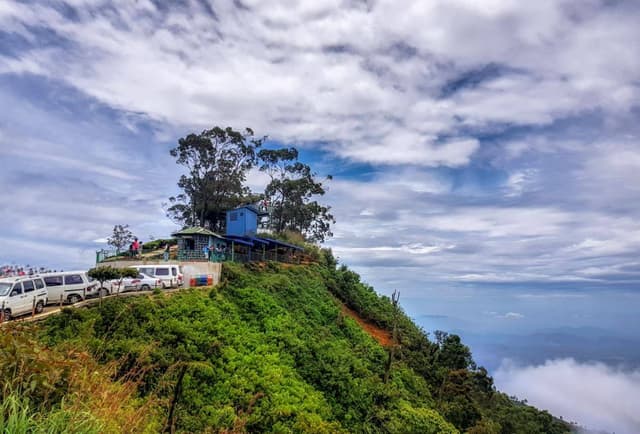
Lipton's Seat
@ravinkavish
Lipton's Seat, perched high in the hills of Haputale, offers one of the most breathtaking panoramic views in Sri Lanka. This iconic viewpoint, named after Sir Thomas Lipton, the famous tea planter, provides a stunning 360-degree vista of rolling tea plantations, misty mountains, and distant valleys. Whether you choose to hike or take a scooter ride, the journey to Lipton’s Seat is an adventure in itself, with the scenic route winding through lush tea estates and dense forests.
The trek or ride up to the viewpoint is around 7 kilometers from the nearest main road, and the cool, fresh air and mesmerizing landscapes make the effort worthwhile. The location is perfect for photography, picnics, or simply soaking in the beauty of Sri Lanka’s hill country.
**Pro tip:** The best time to visit is early in the morning or late afternoon when the mist clears, offering incredible views of the surrounding landscape. If you're driving, take a scooter for a more adventurous route, or opt for a hike if you enjoy a more peaceful, nature-filled experience. Lipton's Seat is a must-visit for anyone exploring Sri Lanka’s tea country.
Add to
Details

Upper Diyaluma Trek Start
@ravinkavish
Add to
Details

Upper Diyaluma Waterfall
@ravinkavish
Add to
Details

Ellewala Waterfall
@ravinkavish
Ellewala Waterfall, located near Wellawaya in Sri Lanka’s beautiful hill country, is a stunning, serene waterfall perfect for nature lovers seeking a peaceful escape. This 30-meter waterfall cascades down a rocky cliff, surrounded by lush greenery and dense forest. The waterfall’s tranquil pool at the base is ideal for a refreshing swim, especially in the dry months from December to March when the flow is gentler and safer for a dip.
To reach Ellewala, visitors can enjoy a short trek through picturesque tea plantations and forest paths, making it an excellent destination for hiking and photography. The natural beauty of the area provides a perfect backdrop for a peaceful retreat or picnic.
**Pro tip:** The best time to visit is from **December to March**, when the weather is dry, and the water flow is more inviting. Avoid visiting during **May** and **October**, which are typically the wettest months in the hill country and can result in stronger currents and slippery paths. If you’re in the Wellawaya area, don’t miss this hidden gem of nature!
Add to
Details

Railway Station Haputale
@ravinkavish
Add to
Details

Idalgashinna Mountain
@ravinkavish
Add to
Details

Idalgashinna
@ravinkavish
Add to
Details

Buduruwagala Raja Maha Viharaya
@ravinkavish
Buduruwagala Raja Maha Viharaya, located in a little below Ella and Haputale is an ancient Buddhist temple known for its impressive rock carvings and statues. This hidden gem is situated about 5 km from the town of **Wellawaya**, surrounded by lush jungle and offering a serene atmosphere. The temple complex dates back to the 10th century, during the **Polonnaruwa period**, and is famous for its large **rock-cut statues** that depict various Buddhist figures.
The most notable feature of Buduruwagala is its **45-foot-high Buddha statue**, which is carved directly into the rock face. The statue, which represents the **Samadhi Buddha** in a meditative pose, is surrounded by several smaller statues, including depictions of Bodhisattvas, making it a remarkable example of ancient Sri Lankan art and sculpture. The site is believed to have been a center for both religious worship and artistic expression during its peak.
The best time to visit Buduruwagala is during the **dry season**, from **December to March**, as this allows for easier exploration and photography in the region. **May** and **October**, the months typically experiencing heavy rainfall, might make the surroundings muddy and the trails slippery.
**Pro tip:** Be sure to take the time to explore the area and its surroundings. The rock carvings and the scenic location in the jungle are incredibly peaceful, and the quiet atmosphere makes it a perfect spot for reflection. Also, since the site is not as crowded as other cultural sites, you can enjoy a more intimate and tranquil experience here.
Add to
Details

Pilkington Point
@ravinkavish
Pilkington Point, located in the picturesque hills of Haputale, is a serene viewpoint that offers breathtaking panoramas of Sri Lanka’s southern plains. Named after a British colonial planter, this spot was historically a favorite retreat for those seeking to immerse themselves in nature’s beauty. From here, you can see lush tea plantations, rolling valleys, and distant mountain ranges stretching all the way to the southern coastline on a clear day.
Accessible via a short and scenic drive or hike through tea estates, Pilkington Point provides a tranquil escape, perfect for photography, picnics, or simply soaking in the fresh mountain air. Its elevation and peaceful surroundings make it a hidden gem for those exploring Haputale.
**Pro tip:** Visit during the early morning or late afternoon for the best lighting and clearer views. Pair this experience with a trip to other Haputale highlights like Lipton’s Seat or the Dambatenne Tea Factory for a full day of exploration in the hill country.
Add to
Details

Kirawana Waterfall
@ravinkavish
Add to
Details

Nuwara Eliya
@ravinkavish
Nuwara Eliya, often referred to as "Little England," is a charming hill station nestled in the heart of Sri Lanka’s central highlands. Known for its cool climate, colonial-era architecture, and sprawling tea plantations, this picturesque town offers a unique blend of history, natural beauty, and leisure.
The town was established during the British colonial period and became a favorite retreat for the British elite. Today, you can still see colonial-style bungalows, red-brick post offices, and well-maintained gardens. Nuwara Eliya is also famous for its tea culture, and visiting a tea factory to witness the production process is a must. The serene Gregory Lake, lush Hakgala Botanical Garden, and the iconic Horton Plains National Park with the dramatic World's End viewpoint are among the many attractions in the area.
**Pro tip:** Nuwara Eliya is especially magical in April during the flower season and its vibrant horse races. Pack warm clothing as temperatures can drop, especially in the evenings. Don’t miss the chance to indulge in fresh strawberries and a steaming cup of locally grown Ceylon tea while soaking in the breathtaking views.
Add to
Details

Swarnagiri Maha Viharaya / Single Tree Temple
@ravinkavish
Swarnagiri Maha Viharaya, also known as the Single Tree Temple, is a peaceful and historically significant Buddhist temple located near Nuwara Eliya. This serene site is believed to have been established centuries ago and is named after the single ancient tree that stands in the temple's courtyard. The tree, thought to be a sacred Bo tree, adds to the spiritual ambiance of the temple, making it a place of meditation and reverence for locals and visitors alike.
The temple itself is modest yet beautiful, with traditional Buddhist architecture and a calm atmosphere. The surrounding area is lush with greenery, and the tranquil environment makes it a perfect spot for reflection. The temple is not as crowded as other tourist spots, offering visitors a peaceful retreat in the midst of Sri Lanka’s hill country.
**Pro tip:** Make sure to take some time to meditate or simply enjoy the quiet surroundings. It’s a great place for a peaceful escape while traveling through Nuwara Eliya.
Add to
Details

Post Office - Nuwara Eliya
@ravinkavish
The Nuwara Eliya Post Office is an iconic landmark in the heart of this charming hill town. Established in 1894 during the British colonial era, this Tudor-style red-brick building stands as a testament to Sri Lanka’s colonial heritage. Its steep roofs, wooden balconies, and vintage charm make it one of the most photographed spots in Nuwara Eliya.
Still functioning as a post office, the building offers a unique opportunity to send postcards to loved ones with a touch of history. It also houses a philatelic bureau, making it a must-visit for stamp collectors and history buffs. The picturesque setting adds to the allure, with the lush gardens and cool mountain air enhancing its timeless appeal.
**Pro tip:** Visit early in the morning to capture the post office in the soft light of the day, and don’t forget to explore other colonial-era gems in Nuwara Eliya like the Grand Hotel and Victoria Park!
Add to
Details

Victoria Park - Nuwaraeliya
@ravinkavish
Victoria Park in Nuwara Eliya is a beautifully landscaped oasis in the heart of the hill town, offering a perfect escape into nature. Established in 1897 to mark Queen Victoria's Diamond Jubilee, the park spans 27 acres and is home to vibrant flowerbeds, lush lawns, and towering trees. It's a favorite spot for both locals and travelers to relax and enjoy the cool mountain air.
The park is also a birdwatcher’s paradise, hosting species like the Indian Pitta and Pied Thrush. For families, there’s a children’s play area and a small train ride. During the blooming seasons, particularly from March to May and August to September, the park bursts into a riot of colors, making it one of the most photogenic spots in Nuwara Eliya.
**Pro tip:** Visit in the morning for the best light and fewer crowds. Combine your trip with a walk to nearby Gregory Lake for a full day of exploring Nuwara Eliya’s charm. A small entrance fee applies.
Add to
Details

Holy Trinity Church, Nuwara Elia - Church of Ceylon
@ravinkavish
Holy Trinity Church, located in the heart of Nuwara Eliya, is a serene and historic Anglican church built in 1852 during the British colonial era. This quaint stone structure, surrounded by lush greenery, features beautiful stained-glass windows and a peaceful interior that reflects the simplicity and elegance of Gothic Revival architecture.
The church has strong historical significance, having served the colonial community and even being attended by notable figures such as Queen Elizabeth II. Its tranquil atmosphere makes it a lovely spot for reflection, and the adjacent cemetery offers a glimpse into the lives of early settlers in Nuwara Eliya.
**Pro tip:** Don’t miss the original pipe organ, a rare treasure, and the plaques inside that tell stories of the colonial era. Combine your visit with a leisurely stroll through Nuwara Eliya’s Victoria Park for a day steeped in history and natural beauty.
Add to
Details
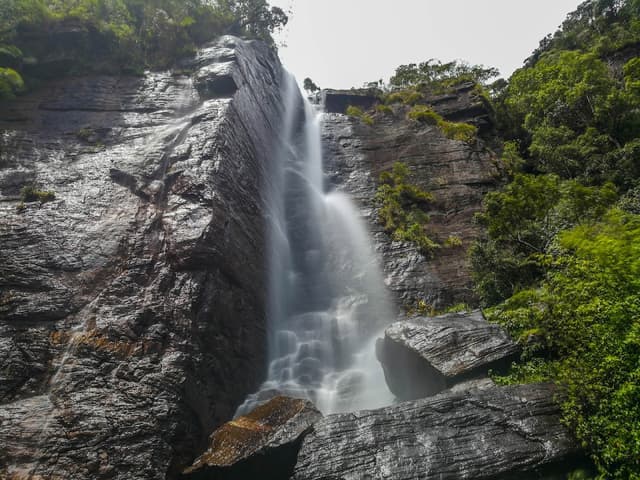
Lover's Leap Waterfall
@ravinkavish
Lover’s Leap Waterfall, a hidden gem near Nuwara Eliya, is a stunning cascade that plunges 30 meters down a rocky cliff surrounded by lush greenery. Named after a local legend of a tragic love story, this waterfall is not only a scenic spot but also steeped in romance and mystery. The water originates from the clear streams of Pidurutalagala, Sri Lanka’s tallest mountain, making it a pristine and refreshing sight.
A short trek through tea plantations leads you to the falls, offering picturesque views of the surrounding landscape along the way. The sound of rushing water and the cool misty breeze make it a serene escape for nature lovers and adventure seekers alike.
**Pro tip:** Visit during the rainy season (November to March) for the best water flow. Pair your visit with a tour of a nearby tea estate for an authentic hill-country experience.
Add to
Details

Gregory Park
@ravinkavish
Gregory Park, located in the heart of Nuwara Eliya, is a beautifully landscaped recreational area surrounding the tranquil Gregory Lake. Built during the British colonial era by Governor Sir William Gregory in 1873, the park has become a favorite spot for locals and tourists seeking relaxation and outdoor fun. The lush greenery, cool climate, and stunning lake views make it a perfect place to unwind.
The park offers a variety of activities, including boat rides on Gregory Lake, cycling, pony rides, and even family picnics on its well-maintained lawns. Food stalls and cozy cafes around the park serve local treats and refreshments, adding to the charm of this serene location.
**Pro tip:** Visit Gregory Park in the late afternoon to enjoy a leisurely walk or boat ride as the sun sets over the hills. The park is especially vibrant during the April season when flowers bloom, and festive events are held. It's an ideal spot for photography and spending quality time with family or friends in the cool mountain air.
Add to
Details

Seetha Amman Kovil
@ravinkavish
Seetha Amman Kovil, located in the lush hills of Nuwara Eliya, is a sacred Hindu temple dedicated to Seetha, the wife of Lord Rama from the ancient Indian epic, the Ramayana. According to legend, this is the place where Seetha was held captive by the demon king Ravana. The temple is a popular pilgrimage site for Hindus and a fascinating stop for travelers interested in Sri Lanka's rich mythological history.
The temple features vibrant carvings of Hindu deities and intricate architecture that reflect traditional South Indian temple design. The serene environment is complemented by the beautiful backdrop of the surrounding mountains and tea plantations. Nearby, a stream runs through the site, and the area is said to have been the place where Seetha bathed during her captivity.
**Pro tip:** Be sure to explore the peaceful surroundings and the nearby Seetha's water stream, said to be where she washed her hair. The temple is especially beautiful during festivals like Diwali and Maha Shivaratri when it is adorned with lights and flowers.
Add to
Details

Bomburu Ella Waterfall
@ravinkavish
Bomburu Ella Waterfall, also known as the "Ramboda Falls," is one of the most breathtaking and majestic waterfalls in Sri Lanka, located near the Ramboda Pass in the central highlands. The waterfall drops over 50 meters, cascading down in multiple tiers, creating a mesmerizing view of the surrounding forested hills. Its pristine, unspoiled environment and the cool mist rising from the water make it a must-visit for nature lovers and photographers.
The waterfall is easily accessible via a short trek from the main road, passing through a tea plantation and lush greenery. The surrounding area is rich in biodiversity, with various species of plants and birds adding to the appeal of the hike. The site offers a tranquil escape from the hustle and bustle of city life.
**Pro tip:** Visit during the monsoon season (April to October) to witness the waterfall in its full glory with powerful water flow. Don’t forget to take a dip in the cool, refreshing waters at the base of the falls for a truly invigorating experience.
Add to
Details
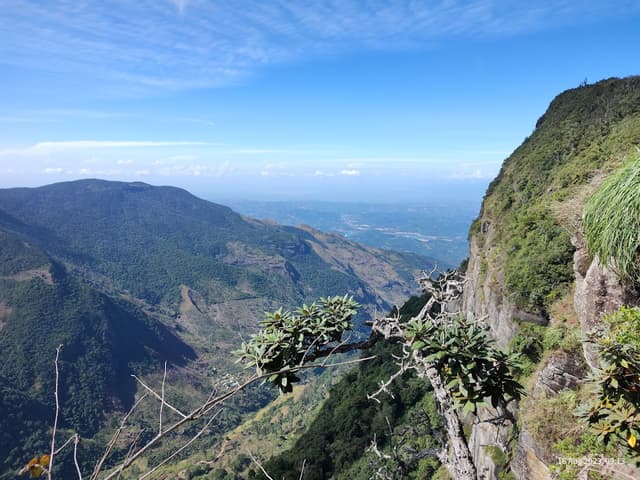
Horton Plains National Park
@ravinkavish
Horton Plains National Park, located in the central highlands of Sri Lanka, is a UNESCO World Heritage site renowned for its breathtaking landscapes, diverse wildlife, and unique ecosystem. The park is situated at an altitude of 2,100 to 2,300 meters (6,890 to 7,550 feet) above sea level, and it covers an area of around 3,160 hectares.
One of the park's main attractions is **World’s End**, a sheer cliff that drops dramatically for about 870 meters (2,850 feet), offering a stunning panoramic view of the surrounding valleys, forests, and distant hills. The **mini World's End**, located not far from the main viewpoint, provides another striking view and is a popular stop for hikers.
The park is home to a variety of flora and fauna, including endemic species such as the **Sri Lankan leopard**, **purple-faced langur**, and the **sambar deer**. Birdwatchers will find Horton Plains a haven, as it is home to numerous species like the **Sri Lanka bush warbler** and **yellow-eared bulbul**. The park also has a range of plant life, including montane grasslands, cloud forests, and heathlands, which support a variety of unique and rare plant species.
Visitors to Horton Plains can enjoy a scenic **trek** that takes them through the park's diverse environments, with highlights such as the **Baker's Falls**, a beautiful waterfall located within the park, and the various viewpoints that offer incredible vistas. The trail is approximately 9 kilometers (5.5 miles) long and takes about 3-4 hours to complete, making it a moderate hike suitable for most visitors.
Horton Plains is a great destination for nature lovers, wildlife enthusiasts, and trekkers, offering an immersive experience in one of Sri Lanka's most ecologically rich and scenic areas.
Add to
Details

Hakgala Botanical Garden
@ravinkavish
Hakgala Botanical Garden, located about 10 kilometers from Nuwara Eliya, is a stunning haven of flora and one of the largest botanical gardens in Sri Lanka. Nestled at the foot of the Hakgala Rock, this garden is perched at an elevation of nearly 5,400 feet, making it the highest in the country. Established in 1861 during the British colonial era, it initially served as a cinchona plantation before transitioning into a botanical garden featuring a remarkable collection of plants.
The garden boasts a diverse range of temperate and subtropical flora, including vibrant roses, colorful orchids, towering cedars, and rare ferns. It is divided into several sections, such as the rose garden, fernery, and rock garden, each offering a unique charm. Legend connects the site to the Ramayana, as the location where Hanuman brought a part of the Himalayas to Sri Lanka to heal Lakshmana.
**Pro tip:** Visit during spring or summer to see the garden in full bloom. Take your time wandering through its serene pathways, enjoying the cool mountain air and picturesque scenery. This is a peaceful retreat for nature enthusiasts, photographers, and those seeking tranquility amidst the beauty of the highlands.
Add to
Details

Ravan Ella Waterfall
@ravinkavish
Ravana Ella Waterfall, located near the famous town of Ella in Sri Lanka, is one of the island's most iconic and stunning waterfalls. Standing at about 25 meters tall, it is the second-largest waterfall in the Uva Province and is believed to be linked to the legendary story of Ravana, a mythical king in the Hindu epic Ramayana. According to the legend, Ravana hid his kidnapped wife Seetha in a cave near the waterfall, making this site not only a beautiful natural feature but also a significant cultural and historical landmark.
The waterfall is set in a lush, green environment, surrounded by dense jungle and rolling hills, which makes it a popular stop for travelers on the Ella trail. The surrounding area also offers great opportunities for a short hike, with paths leading to the waterfall's base where visitors can get up close to the gushing water.
**Pro tip:** The best time to visit is after the rainy season (October to April) when the waterfall is at its fullest and most impressive. Be sure to bring sturdy footwear, as the paths can be slippery. The area around the falls is also perfect for picnics or a relaxing afternoon surrounded by nature.
Add to
Details
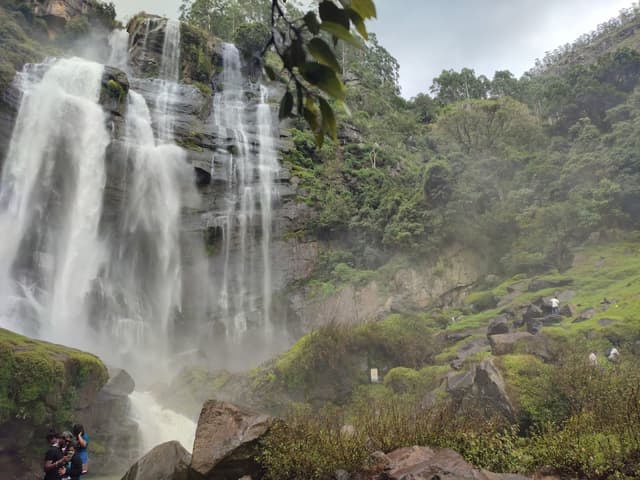
Upper Bomburu Falls
@ravinkavish
Add to
Details

Bombaru Ella Falls -upperFalls
@ravinkavish
Add to
Details

Devil's Staircase View Point
@ravinkavish
Devil's Staircase View Point, located in Sri Lanka's central highlands, is a thrilling destination for adventure seekers and nature lovers. Positioned along the infamous Devil's Staircase trail, this viewpoint offers breathtaking panoramas of lush valleys, cascading waterfalls, and tea-covered slopes. The rugged terrain and misty surroundings create an unforgettable atmosphere for travelers who crave a touch of wilderness.
Reaching the viewpoint involves a challenging yet rewarding hike or off-road drive through winding paths, making the journey as memorable as the destination. It’s a favorite among hikers, photographers, and thrill-seekers exploring the highlands.
**Pro tip:** Early morning visits provide the clearest views, while the rainy season (April to September) enhances the lush beauty of the area. Pair this experience with a stop at Bambarakanda Falls or a trek through Ohiya for a full day of adventure. Devil's Staircase View Point promises an awe-inspiring escape into Sri Lanka's untamed beauty.
Add to
Details

Baker's Falls
@ravinkavish
Baker's Falls, located in Horton Plains National Park, is one of Sri Lanka’s most stunning and picturesque waterfalls. Named after the British explorer Sir Samuel Baker, who is believed to have discovered the waterfall in the 19th century, it cascades gracefully over a series of rocks, creating a beautiful spectacle against the backdrop of lush forest and rolling hills.
The waterfall drops about 20 meters, with the surrounding area often enveloped in mist, adding to the ethereal beauty of the location. The falls are situated along the park's popular **Horton Plains Circular Trail**, which is a scenic 9 km hike offering a chance to see other natural wonders of the area, including the famous **World's End** viewpoint.
Baker's Falls is a great spot for travelers looking to enjoy the peaceful surroundings and natural beauty of the highlands. The area is also home to a variety of wildlife, including the endemic Sri Lankan sambar deer and several species of birds.
**Pro tip:** To get the best views of Baker's Falls, visit early in the morning when the mist is still present, giving the falls a mystical aura. Be sure to wear sturdy footwear, as the trails can be muddy and uneven, and bring a camera to capture this scenic gem.
Add to
Details
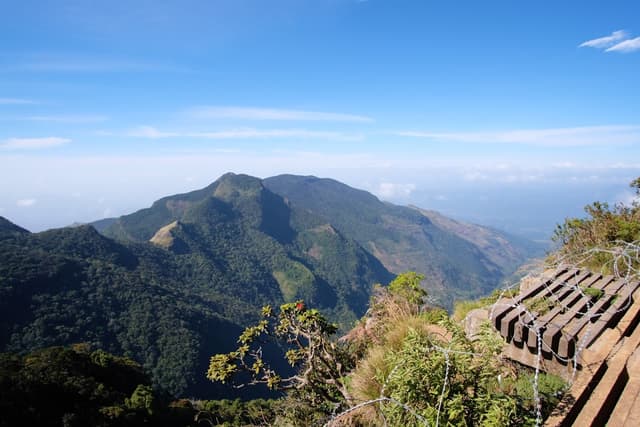
Great World's End Drop
@ravinkavish
**Great World's End** is one of the most dramatic and awe-inspiring natural features in Sri Lanka, located in **Horton Plains National Park**. This sheer cliff drop, with a vertical descent of around 880 meters (2,887 feet), offers one of the most spectacular views in the country. It is often referred to as "World’s End" due to the expansive views it offers, where the land appears to end abruptly, dropping steeply into the valley below.
From the viewpoint, you can see a vast stretch of jungle, rivers, and distant hills, often surrounded by mist that adds to the mystique and grandeur of the scene. The panoramic view on a clear day is breathtaking, providing an incredible opportunity for photographers and nature lovers alike.
To reach Great World's End, visitors can hike along the **Horton Plains Circular Trail**, a 9 km path that takes you through the park's scenic grasslands and cloud forests. The trail is relatively easy, though it can be a bit muddy, so it’s best to wear sturdy shoes. The hike typically takes around 3 to 4 hours, with Great World's End being one of the highlights.
**Pro tip:** The best time to visit Great World's End is early in the morning before the mist sets in, as the view is clearer and more dramatic. It's recommended to arrive at the site early to enjoy the solitude before the crowds arrive. The temperatures can be quite chilly in the morning, so bring a light jacket or sweater.
Add to
Details
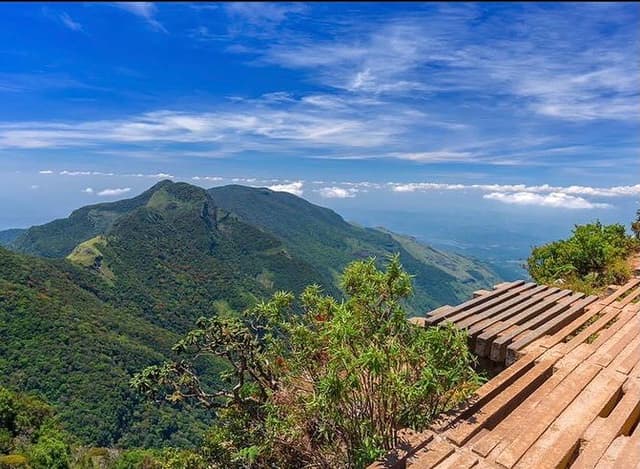
Mini World's End
@ravinkavish
**Mini World's End** is another stunning viewpoint located in **Horton Plains National Park**, situated just a short distance from the more famous **Great World's End**. Though not as high, Mini World's End still offers a breathtaking view with a vertical drop of about 270 meters (885 feet), providing sweeping vistas of the surrounding landscape, including dense forests, valleys, and distant hills.
The viewpoint is named "Mini World's End" due to its resemblance to the larger Great World's End, offering a more compact but equally impressive panorama. The spot is often quieter and less crowded, making it a peaceful alternative for those looking to experience the park's beauty without the crowds.
To reach Mini World's End, you'll follow part of the **Horton Plains Circular Trail**, which is about 9 km long. It’s a relatively easy walk through the park’s unique ecosystem of grasslands and montane forests, with several other scenic spots along the way. The trek typically takes about 3 hours, and Mini World's End is one of the stops on the circular route.
**Pro tip:** Like with Great World's End, the best time to visit Mini World's End is early in the morning to avoid the mist and enjoy clear views. Bring comfortable shoes, as the trail can be slippery in places, and don’t forget to bring your camera to capture the stunning landscapes!
Add to
Details

Gartmore Falls
@ravinkavish
Gartmore Falls, located near the town of Talawakele in Sri Lanka’s central highlands, is a beautiful and relatively lesser-known waterfall that tumbles down from a height of 50 meters. Set amidst lush tea plantations and surrounded by misty mountains, this waterfall is a hidden gem offering a peaceful retreat for nature lovers.
The falls are easily accessible with a short hike through scenic landscapes, providing the perfect opportunity to immerse yourself in the region’s natural beauty. Its gentle flow creates a tranquil atmosphere, making it a great spot for photography, picnics, or simply unwinding.
Add to
Details

Moray Falls
@ravinkavish
Moray Falls, a hidden gem in the central highlands of Sri Lanka, is a mesmerizing cascade nestled within lush greenery near the Moray Estate, close to Maskeliya. This serene waterfall flows gracefully from a height of 45 meters, creating a tranquil pool at its base and offering a picturesque escape for nature lovers and adventure seekers alike. The falls are part of the Maussakelle Reservoir’s catchment area, adding to their pristine charm.
To reach the falls, visitors must embark on a short but rewarding hike through tea plantations and forested trails, making the journey as memorable as the destination itself.
**Pro tip:** Visit during the rainy season (April to September) to see the falls at their most vibrant. Combine your trip with a visit to the nearby Adam's Peak for a perfect mix of adventure and natural beauty. Moray Falls is an ideal stop for those seeking off-the-beaten-path experiences in Sri Lanka.
Add to
Details

Gartmore falls viewpoint
@ravinkavish
Add to
Details

Laxapana Falls
@ravinkavish
Laxapana Falls, one of Sri Lanka’s most iconic waterfalls, cascades majestically from a height of 126 meters near Maskeliya. Nestled amidst lush greenery and rugged terrain, this stunning waterfall is fed by the Maskeliya Oya, a tributary of the Kelani River. Its name is linked to a legend that the Buddha rested here during one of his journeys, adding a spiritual dimension to its natural beauty.
The falls are also a source of hydroelectric power, making them both a natural wonder and a contributor to Sri Lanka's energy needs. Visitors can enjoy the mesmerizing view from the base or trek to the top for panoramic vistas of the surrounding landscape.
**Pro tip:** The best time to visit is during the rainy season (April to September), when the waterfall is at its fullest. Wear comfortable footwear for the trek, and take plenty of water. Laxapana Falls is perfect for travelers seeking a mix of natural beauty, adventure, and cultural lore.
Add to
Details

Aberdeen Waterfall
@ravinkavish
Hatton, nestled in Sri Lanka’s central highlands, is a charming town surrounded by emerald-green tea plantations and misty mountains. Known as a gateway to Adam’s Peak (Sri Pada), Hatton attracts pilgrims and adventurers alike, offering easy access to this iconic spiritual and hiking destination. The area is also home to some of Sri Lanka’s most famous waterfalls, including Devon Falls and St. Clair Falls, which add to its natural allure.
The town’s colonial history is evident in its architecture and tea estates, where visitors can experience Sri Lanka’s tea culture firsthand. A cup of freshly brewed Ceylon tea is a must while enjoying the cool climate and serene landscapes.
**Pro tip:** Hatton is best visited from December to April for clear weather, especially if climbing Adam’s Peak. It's also an excellent base for exploring nearby towns like Nuwara Eliya and Ella. Hatton promises a delightful mix of adventure, history, and natural beauty for travelers venturing into the highlands.
Add to
Details

Belilena Cave
@ravinkavish
Add to
Details

Ella
@ravinkavish
Ella, a charming village in Sri Lanka's hill country, is a paradise for travelers seeking stunning views, outdoor adventures, and a laid-back vibe. Surrounded by misty mountains, lush tea plantations, and cascading waterfalls, Ella offers a perfect blend of natural beauty and cultural richness.
The iconic **Nine Arches Bridge**, a colonial-era marvel, is a favorite spot for photography, especially when the train winds its way through the lush greenery. The trek to **Ella Rock** rewards you with panoramic views, while the shorter climb up **Little Adam’s Peak** is perfect for beginners, offering equally mesmerizing vistas.
Ella is also a hub for tea lovers. Visit the **Halpewatte Tea Factory** to learn about Sri Lanka’s world-renowned tea industry. For history enthusiasts, the nearby **Ravana Ella Falls** and **Ravana Cave** are linked to the epic Ramayana, adding a touch of mythology to your journey.
**Pro tip:** Plan your hike early in the morning for the best weather and views. Afterward, relax with a cup of locally grown tea or enjoy the lively cafes and restaurants that line the streets of Ella town.
Add to
Details

Little Adam's Peak Trailhead
@ravinkavish
Add to
Details

Flying Ravana Mega Zipline
@ravinkavish
Add to
Details

Uva Halpewatte Tea Factory Tour
@ravinkavish
Add to
Details

Nine Arches Bridge
@ravinkavish
Nine Arches Bridge is one of Sri Lanka’s most iconic landmarks, located near the town of Ella in the central highlands. Built during the British colonial era in the 1920s, this stunning bridge spans a deep valley surrounded by lush greenery and tea plantations. The bridge is 91 meters long and stands at 24 meters above the ground, with nine graceful arches giving it its name.
The Nine Arches Bridge is a marvel of engineering and has become a popular spot for both tourists and photographers, offering breathtaking views of the surrounding hills and valleys. The bridge is located along the railway line that connects Kandy to Badulla, and it’s a popular spot for watching the famous trains that pass through, creating a perfect photo opportunity.
The best time to visit Nine Arches Bridge is during the **dry season** from **December to March**, when the weather is stable and clear, offering perfect visibility for photography. **May** and **October** can bring heavy rainfall, which may make the area slippery and affect visibility.
**Pro tip:** The best views of the bridge can be captured from the nearby hills, which are easily accessible by a short hike. If you want to catch a train crossing the bridge, check the train schedule ahead of time, as it’s a popular spot for train enthusiasts and photographers.
Add to
Details
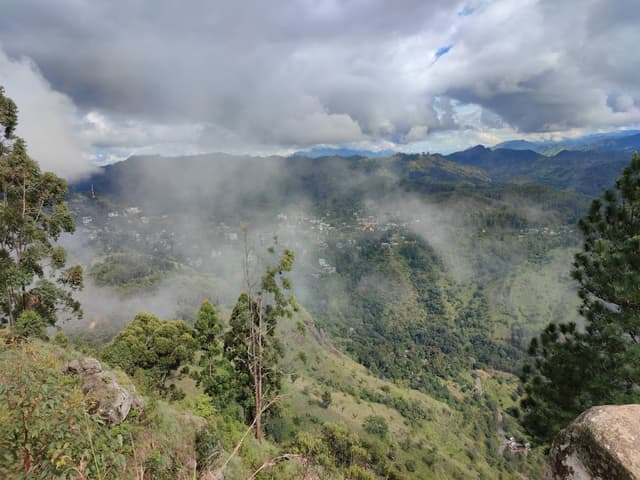
Ella Rock Trailhead
@ravinkavish
Add to
Details

Ravana Waterfall
@ravinkavish
Ravana Waterfall, located near the town of Ella in Sri Lanka's southern hill country, is one of the most famous and beautiful waterfalls in the region. Standing at around 25 meters in height, this waterfall is a popular stop for travelers exploring Ella and the surrounding areas. Named after the mythical king Ravana, the falls are steeped in local legends, and are believed to be linked to the ancient story of the Ramayana.
The waterfall is a multi-step cascade, with water flowing down from the mountains, creating a scenic and serene environment. The surrounding area is lush with greenery, making it an ideal spot for a short walk or picnic. The base of the falls offers a cool pool where you can enjoy a refreshing swim, although caution is needed during the rainy season as the water can rise quickly.
The best time to visit Ravana Waterfall is during the **dry season**, from **December to March**, when the weather is more stable and the waterfall is at its most picturesque. The **rainy season**, particularly **May** and **October**, can bring heavy rainfall, making the path slippery and the water flow strong.
**Pro tip:** If you're visiting, take the time to explore the surrounding area, as the waterfall is part of a larger natural attraction. The nearby Ravana Cave and the breathtaking views of the Ella Gap are also worth a visit. Be sure to carry a camera to capture the beauty of the falls and its surroundings, especially if you're lucky enough to see the falls in full flow after some rain.
Add to
Details

Blue Water Cave Pond (Nil Diya Pokuna)
@ravinkavish
Blue Water Cave Pond (Nil Diya Pokuna), located in the Knuckles Mountain Range, is a hidden gem surrounded by dense forest and rugged terrain. This crystal-clear pond, nestled in a serene cave, is known for its striking blue water, which gives it the name "Nil Diya Pokuna," meaning "Blue Water Pond." The water, fed by natural springs, remains cool and refreshing throughout the year, creating a peaceful environment for visitors.
The journey to Nil Diya Pokuna requires a moderate hike through the forest, making it an excellent destination for nature lovers and those seeking an off-the-beaten-path adventure. The pond itself is tranquil and offers a mesmerizing view of the surrounding greenery. It's also a great spot for photography, as the vibrant blue water contrasts beautifully with the lush vegetation and rocks.
The best time to visit Nil Diya Pokuna is during the **dry season**, from **December to March**, when the weather is more stable, and the path to the cave is easier to navigate. **May** and **October** can be challenging, as the rainy season can make the trail slippery and difficult to hike.
**Pro tip:** Since the area is remote and not as developed for tourism, it’s advisable to bring plenty of water, wear sturdy footwear, and be prepared for a hike through a forested trail. This serene spot is perfect for those looking to escape the crowds and experience the natural beauty of Sri Lanka's hill country.
Add to
Details

Kombukara Nature Pool and Secret Waterfall
@ravinkavish
Add to
Details

Mahamevnawa Buddhist Monastery
@ravinkavish
Mahamevnawa Buddhist Monastery near Ella is a serene spiritual retreat nestled in the misty hills of Sri Lanka's central highlands. This peaceful monastery is part of the renowned Mahamevnawa network of monasteries, established in 1999 to revive and propagate the teachings of the Buddha. It serves as a tranquil space for meditation, mindfulness, and learning, attracting devotees and curious travelers alike.
The monastery features simple, elegant architecture harmonizing with the natural surroundings, with quiet pathways, lush greenery, and an atmosphere of calm. Visitors can participate in meditation sessions, attend Dhamma talks, or simply take a reflective stroll around the grounds. The serene environment is ideal for those seeking inner peace or a break from the bustle of everyday life.
**Pro tip:** Dress modestly and respectfully when visiting. If you’re new to meditation or Buddhist practices, the monks are often welcoming and happy to guide you. It's a wonderful spot to experience Sri Lanka’s spiritual heritage amidst the beauty of Bandarawela’s hills.
Add to
Details

Ellewala Waterfall
@ravinkavish
Ellewala Waterfall, located near Wellawaya in Sri Lanka’s beautiful hill country, is a stunning, serene waterfall perfect for nature lovers seeking a peaceful escape. This 30-meter waterfall cascades down a rocky cliff, surrounded by lush greenery and dense forest. The waterfall’s tranquil pool at the base is ideal for a refreshing swim, especially in the dry months from December to March when the flow is gentler and safer for a dip.
To reach Ellewala, visitors can enjoy a short trek through picturesque tea plantations and forest paths, making it an excellent destination for hiking and photography. The natural beauty of the area provides a perfect backdrop for a peaceful retreat or picnic.
**Pro tip:** The best time to visit is from **December to March**, when the weather is dry, and the water flow is more inviting. Avoid visiting during **May** and **October**, which are typically the wettest months in the hill country and can result in stronger currents and slippery paths. If you’re in the Wellawaya area, don’t miss this hidden gem of nature!
Add to
Details

Pallewela Waterfall
@ravinkavish
Pallewela Waterfall, located in the village of Pallewela near Kegalle in Sri Lanka, is a serene and lesser-known waterfall that offers a peaceful retreat for nature lovers. The waterfall is surrounded by lush greenery and a vibrant forest, providing a picturesque setting for hiking and photography. The water cascades down in a single stream into a natural pool below, which is perfect for a refreshing swim.
The best time to visit Pallewela Waterfall is during the dry season, from **December to March**, when the weather is more stable, and the water flow is gentle enough for a safe swim. The area is accessible by a short trek through scenic landscapes, making it an ideal spot for travelers who enjoy a bit of adventure combined with tranquility.
**Pro tip:** It's best to avoid visiting in **May** and **October**, as these months often bring heavy rains that can make the paths slippery and the water flow stronger. If you’re looking for a peaceful, off-the-beaten-path waterfall experience, Pallewela is a great destination!
Add to
Details

Dowa Ancient Temple
@ravinkavish
Dowa Ancient Rock Temple, located in the **Badulla District** of Sri Lanka, is a fascinating historical and religious site that offers a unique blend of natural beauty and cultural heritage. The temple is built into a massive rock face, providing visitors with a sense of awe as they approach. Known for its stunning **rock carvings**, the Dowa Temple dates back to the 2nd century BC and holds significant importance in Sri Lanka's Buddhist history.
The main attraction at Dowa Ancient Rock Temple is the **large reclining Buddha statue**, which is carved into the rock. This statue is believed to have been created during the Anuradhapura period, and it stands as a testament to the skill and devotion of the artists of that time. In addition to the Buddha statue, the temple complex also features other smaller Buddha figures, intricate rock carvings, and ancient inscriptions that offer insight into the history of Buddhism in Sri Lanka.
The best time to visit Dowa Ancient Rock Temple is during the **dry season**, from **December to March**, when the weather is comfortable for exploring and hiking around the temple. The months of **May** and **October** are generally wetter and could make the trails slippery and harder to navigate.
**Pro tip:** The hike up to the temple involves a short climb, but the views from the top of the rock are well worth the effort. Take your time to explore the rock carvings and inscriptions, and don’t forget to take a moment to appreciate the peaceful atmosphere and the scenic surroundings.
Add to
Details

6. Trincomalee
@ravinkavish
Add to
Details

Velgam Vehera Buddhist Temple
@ravinkavish
Add to
Details

Sri Lakshmi Narayana Perumal Kovil
@ravinkavish
Add to
Details

Fort Frederick
@ravinkavish
Add to
Details

Rock Bunker
@ravinkavish
Hidden Gem The Rock Bunker in Fort Frederick, Trincomalee, is a real-life piece of military history that would intrigue any Call of Duty fan. This rugged bunker, carved into the rock face, was originally built by the Dutch during their colonial rule to defend against enemy attacks. The bunker’s strategic position on the cliff offers an impressive vantage point overlooking Trincomalee’s harbor. Imagine holding your ground while scanning the horizon for enemy ships—this spot was designed for exactly that kind of defense. Exploring the bunker, you'll see its thick stone walls and narrow passageways, giving you a taste of what it must have been like to man this outpost during historical sieges. The sense of being inside a real-life fortification adds an immersive touch for those who love military history or tactical games. The Rock Bunker not only offers a peek into Sri Lanka’s colonial past but also provides some epic views and a bit of that “battlefield” vibe—making it a perfect spot for anyone fascinated by military strategy and history.
Add to
Details
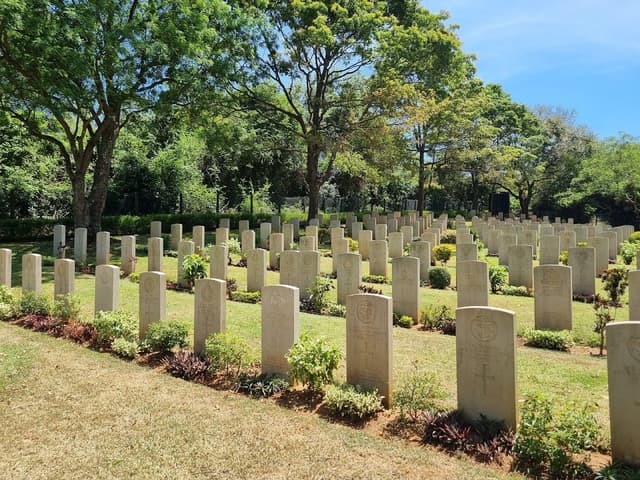
Trincomalee War Cemetery
@ravinkavish
Add to
Details
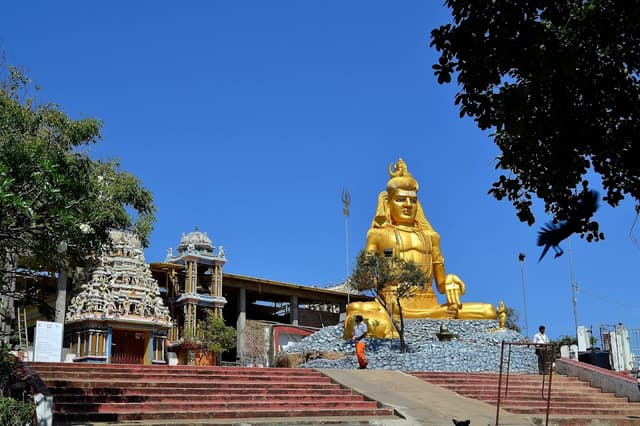
Thirukoneswaram Kovil
@ravinkavish
Add to
Details

Lovers Leap View Point Trincomalee
@ravinkavish
Add to
Details

North Dutch Gun Point Bunker
@ravinkavish
Recommended North Dutch Gun Point Bunker, located near Fort Frederick in Trincomalee, is a fascinating spot for history enthusiasts and adventurers alike. This old military bunker, built by the Dutch during their colonial rule in the 17th century, offers a glimpse into Sri Lanka’s past conflicts and strategic military importance. The bunker is perched on a hill with stunning views of Trincomalee’s harbor and the surrounding coastline. It’s a great place to explore if you’re into military history and want to see how the Dutch fortified their position against invaders. The structure itself is rugged and weathered, adding to its historic charm. A walk around the bunker lets you imagine the strategic importance it once held and offers fantastic photo opportunities of the panoramic ocean views. It’s a bit off the beaten path, making it a perfect spot for those looking to combine a bit of historical exploration with a scenic adventure.
Add to
Details

Villuntri Kandaswamy Temple
@ravinkavish
Add to
Details

Dolphin Watching Site
@ravinkavish
Add to
Details

Sandy Cove Beach
@ravinkavish
Add to
Details

Sampur Lighthouse | Foul Point Lighthouse
@ravinkavish
Add to
Details

Trincomalee Town Beach
@ravinkavish
Add to
Details

Nilaveli Beach
@ravinkavish
Add to
Details
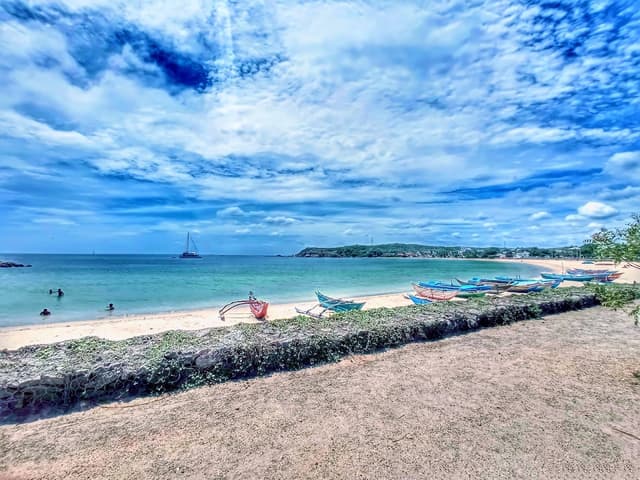
Dutch Bay Beach
@ravinkavish
Add to
Details
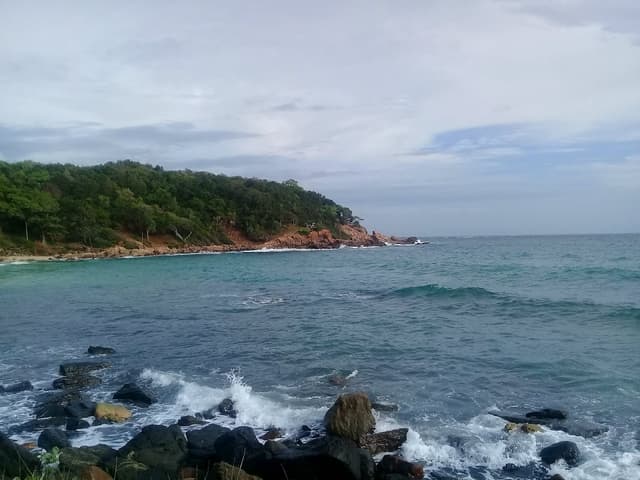
Green Bay Beach
@ravinkavish
Add to
Details

Marble Beach
@ravinkavish
Add to
Details
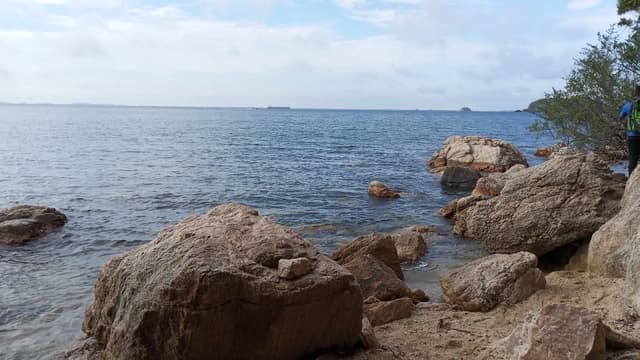
Stone cave
@ravinkavish
Add to
Details

Shri Badrakali Amman Hindu kovil
@ravinkavish
Must Visit Shri Badrakali Amman Hindu Kovil in Trincomalee is a captivating stop for travelers seeking a dose of local culture and spirituality. This vibrant Hindu temple is dedicated to the goddess Kali, known for her fierce and protective qualities. The temple's standout feature is its stunning, intricately carved façade, adorned with colorful statues and detailed artwork. As you explore, you’ll be struck by the vivid colors and elaborate designs that bring the temple to life. Inside, the atmosphere is both lively and serene. The temple is a hub of activity during festivals, with traditional ceremonies and offerings adding to the energetic vibe. It’s a great place to witness local religious practices and immerse yourself in the community’s spiritual life. Set against a backdrop of lush greenery, Shri Badrakali Amman Kovil offers a peaceful retreat where you can experience a rich blend of history, culture, and devotion. It’s a fantastic spot to soak in the local flavor and appreciate the artistic beauty of the temple.
Add to
Details

Naval Museum
@ravinkavish
Add to
Details

Sri Paththirakaali Kovil
@ravinkavish
Highly Recommended Sri Paththirakaali Kovil, located in Trincomalee, is a vibrant Hindu temple that's a must-see for anyone interested in experiencing local culture and spirituality. Dedicated to the goddess Kali, the temple is known for its vivid colors, elaborate carvings, and lively atmosphere. The highlight of Sri Paththirakaali Kovil is its stunning architecture, featuring intricate sculptures and vibrant murals that bring the temple to life. The temple’s façade and interiors are adorned with depictions of Hindu deities and mythological scenes, offering a visual feast for visitors. The temple is also known for its bustling festivals and ceremonies, where you can witness traditional rituals, music, and dance. These events add a dynamic and festive energy to the temple, providing a deeper insight into local religious practices. Set against a backdrop of Trincomalee’s scenic landscape, the temple’s location adds to its charm. The combination of its rich artistic details and the lively cultural scene makes Sri Paththirakaali Kovil a captivating stop for anyone exploring the spiritual and cultural heart of Sri Lanka.
Add to
Details

Historical Kottiyaaraama Sri pathra Dhathu Mula Rajamaha Viharaya (Gal Kanda Temple)
@ravinkavish
Highly Recommended The Historical Kottiyaaraama Sri Pathra Dhathu Mula Rajamaha Viharaya, commonly known as the Gal Kanda Temple, is a fascinating spot for travelers interested in ancient history and serene temple settings. Situated in a tranquil part of Sri Lanka, this temple stands out for its unique features and rich heritage. The name "Gal Kanda," which translates to "Rock Temple," perfectly describes its setting. The temple is carved into a large rock face, giving it a dramatic and rugged appearance. As you explore, you’ll notice intricate rock carvings and ancient Buddha statues that add to the site’s mystique and historical value. One of the most captivating aspects of the Gal Kanda Temple is its peaceful atmosphere. The temple’s location amidst lush greenery and rocky terrain creates a serene environment that’s perfect for quiet reflection and exploration. The temple is also noted for its connection to ancient Sri Lankan Buddhism, with legends suggesting it was a significant site for early Buddhist practices. Exploring the temple offers a unique opportunity to step back in time and appreciate the architectural and spiritual achievements of Sri Lanka’s past. For backpackers seeking a mix of history, spirituality, and natural beauty, Gal Kanda Temple provides an intriguing and off-the-beaten-path experience.
Add to
Details

Sangamiththa Viharaya/Temple
@ravinkavish
Optional Sangamiththa Viharaya in Trincomalee is a lesser-known but intriguing temple that’s worth a visit for its peaceful atmosphere and historical significance. The temple is dedicated to Sanghamitta Theri, a prominent Buddhist figure who played a key role in the spread of Buddhism to Sri Lanka. The site is surrounded by lush greenery, creating a serene setting that’s perfect for a tranquil retreat from the city. Highlights of the temple include its simple yet elegant design, with a blend of traditional Sri Lankan and Indian architectural elements. The temple’s calm environment and historical background offer a unique opportunity to connect with Sri Lanka’s Buddhist heritage in a quiet, reflective setting. Visiting Sangamiththa Viharaya provides a glimpse into the region's spiritual history and a chance to experience a peaceful spot off the beaten path.
Add to
Details

Gokanna Rajamaha Viharaya/Temple
@ravinkavish
Recommended Gokanna Rajamaha Viharaya, located in Trincomalee, is a hidden gem for those exploring Sri Lanka’s cultural and spiritual sites. This ancient Buddhist temple, dating back to the 3rd century BCE, offers a unique glimpse into the island’s rich religious history. The temple is renowned for its impressive rock-cut cave shrine and serene atmosphere. The main cave shrine features ancient Buddha statues and intricate carvings that tell stories of past eras. It’s a peaceful spot where you can enjoy some quiet reflection away from the usual tourist spots. One of the highlights of Gokanna Rajamaha Viharaya is its location atop a small hill, which provides stunning views of the surrounding landscape and the distant sea. The temple’s setting amidst lush greenery adds to its tranquil vibe, making it a great place for a relaxed visit. Local legends add to the charm of the temple, with stories of its historical significance and connections to early Buddhist figures. It’s a perfect spot to soak in some history, enjoy scenic views, and experience the spiritual tranquility of Sri Lanka’s ancient temples.
Add to
Details

Wilgamwehera Rajamaha Viharaya (Mahamevnawa Buddhist Monastery)
@ravinkavish
Add to
Details

Add to
Details
Jaffna

Jaffna
@ravinkavish
Add to
Details

Dutch Fort - Jaffna
@ravinkavish
Add to
Details

Jaffna Public Library
@ravinkavish
Add to
Details

Jaffna Archeological Museum
@ravinkavish
Add to
Details

Nallur Kandaswamy Devasthanam
@ravinkavish
Add to
Details

Inuvil Kanthaswamy Kovil
@ravinkavish
Add to
Details

Kankesanthurai Lighthouse
@ravinkavish
Add to
Details

Keerimalai Naguleswaram temple
@ravinkavish
Add to
Details
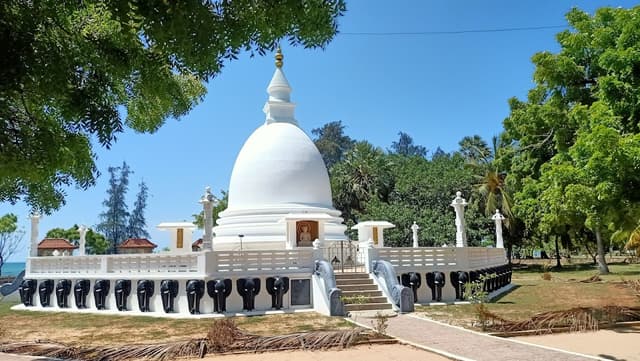
Dambakolapatuna Sangamiththa Temple
@ravinkavish
Add to
Details

Casuarina Beach
@ravinkavish
Add to
Details

Kovalam light house
@ravinkavish
Must Visit Kovalam Lighthouse, perched on a rocky hill in the picturesque coastal town of Kovalam, is a gem worth checking out. Built in 1972, this iconic lighthouse is a beacon for sailors and a favorite spot for visitors. The lighthouse’s red-and-white striped tower stands out against the backdrop of the turquoise sea and golden sands. Climbing to the top offers a panoramic view of the stunning coastline and the Arabian Sea. On a clear day, the view is nothing short of spectacular, with the endless blue of the ocean stretching out to the horizon. The surrounding area is pretty laid-back, with palm-fringed beaches and a relaxed vibe that’s perfect for unwinding. The lighthouse itself is an excellent place to capture some great photos and take in the sea breeze. Locals and tourists alike enjoy the gentle walk up to the lighthouse, which is relatively easy and leads to some beautiful views along the way. It’s a great spot to catch a sunset, as the sun dips below the horizon, painting the sky with hues of orange and pink. Overall, a visit to Kovalam Lighthouse is a charming experience, combining a bit of history with some breathtaking scenery. If you’re in the area, it’s definitely worth a visit for a dose of coastal beauty and a bit of local flair.
Add to
Details

Fort Hammenhiel
@ravinkavish
Add to
Details

Delft National Park
@ravinkavish
Add to
Details

Queen's Tower - Delft Island
@ravinkavish
Add to
Details

Vediyarasan Fort
@ravinkavish
Add to
Details

Dutch Fort - Delft Island
@ravinkavish
Add to
Details

Jaffna Divisional Secretariat Bus Stop
@ravinkavish
Add to
Details

Jaffna Railway Station
@ravinkavish
Add to
Details
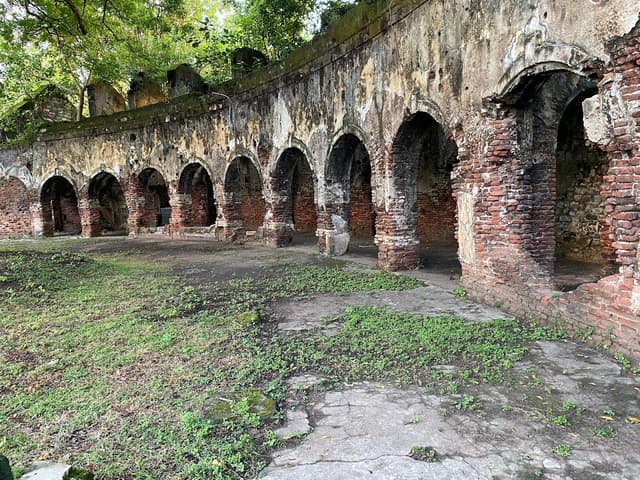
Add to
Details

Mantri Manai
@ravinkavish
Must Visit Mantri Manai, nestled in the heart of Jaffna, is a fascinating glimpse into the past. This old minister’s residence, believed to date back to the 17th century during the reign of the Jaffna Kingdom, is a relic that whispers stories of a bygone era. The name "Mantri Manai" itself translates to "Minister's Palace," hinting at its once important status. What makes Mantri Manai stand out is its unique blend of Dravidian and colonial architecture. The thick walls, high ceilings, and arched doorways give the place a certain grandeur, even though time has worn it down. Walking through its remains, you can almost imagine the hustle and bustle of royal affairs and the whispers of secret meetings that once took place within these walls. The place isn’t huge, but it’s rich in atmosphere. There’s something quite special about standing in a spot that has witnessed centuries of history. Plus, it’s not crowded, making it a peaceful stop where you can take a moment to reflect or snap a few cool photos. If you’re exploring Jaffna, Mantri Manai is a quick and intriguing stop to add to your itinerary. It’s like a little time capsule tucked away in the city, offering a quiet reminder of Jaffna’s rich heritage.
Add to
Details
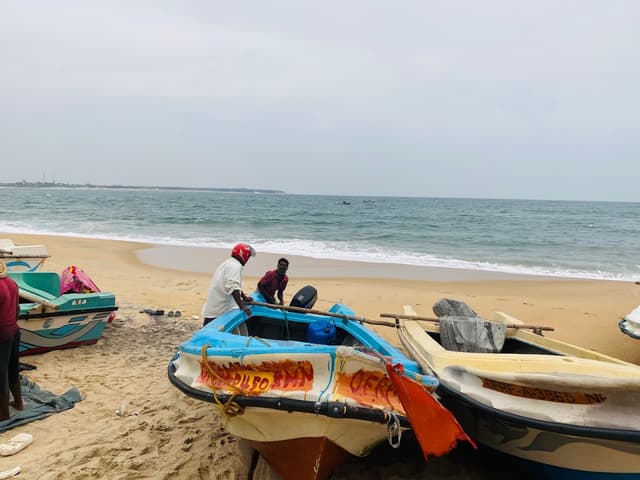
Arugam Bay
@ravinkavish
Add to
Details

Lahugala Magul Maha Viharaya
@ravinkavish
Add to
Details

Kotawehera Ancient Temple
@ravinkavish
Add to
Details

Pottuvil point
@ravinkavish
Add to
Details

Lagoon Elephant View Point
@ravinkavish
Add to
Details
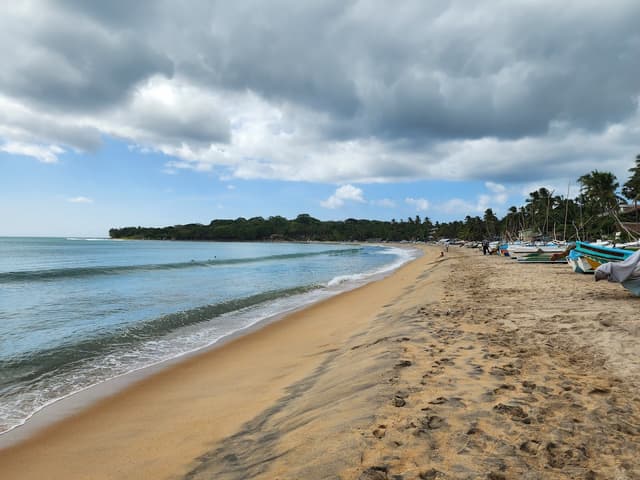
Arugam Bay Beach
@ravinkavish
Add to
Details

Crocodile Rock
@ravinkavish
Add to
Details

Elephant Rock
@ravinkavish
Add to
Details

Mani Naga Pabbatha Raja maha Viharaya, Sastrawela, Panama
@ravinkavish
Add to
Details

Peanut Farm Beach
@ravinkavish
Add to
Details

Panama Beach
@ravinkavish
Add to
Details
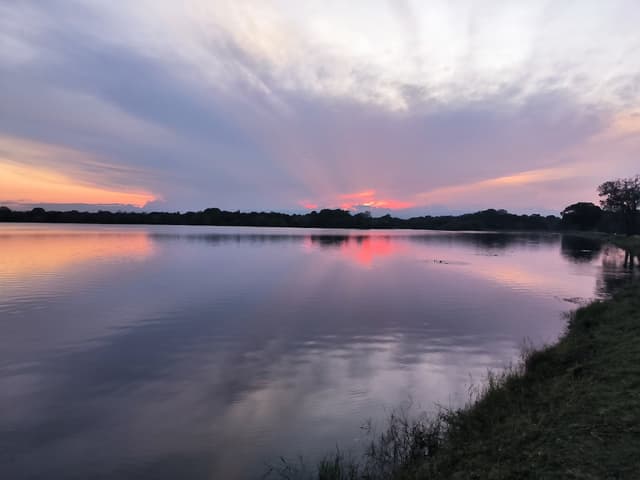
Panama Wewa/Lake
@ravinkavish
Add to
Details

Kudumbigala Monastery Complex
@ravinkavish
Add to
Details

Kumana National Park
@ravinkavish
Add to
Details

Galle
@ravinkavish
Galle, located on Sri Lanka’s southwestern coast, is a historic city known for its charming blend of colonial architecture, vibrant culture, and coastal beauty. The **Galle Fort**, a UNESCO World Heritage site, is the city's most famous attraction, offering cobblestone streets, old Dutch buildings, and panoramic views of the Indian Ocean. The fort was built by the Portuguese in the 16th century and later fortified by the Dutch, reflecting a rich colonial past.
Beyond the fort, Galle is home to beautiful beaches, including **Unawatuna Beach**, a popular spot for swimming and snorkeling. The city also offers bustling markets, boutique shops, and cafes where you can experience local culture and cuisine.
**Pro tip:** Take a walk along the ramparts of Galle Fort at sunset for a beautiful view of the ocean and the city’s skyline.
Add to
Details

Triton di Slvar Bastion
@ravinkavish
The Triton Di Slvar Bastion, also known as the "Triton Bastion," is another historical feature of Galle Fort, built during the Dutch colonial era in the 17th century. As with other bastions in the fort, it was constructed for defense, designed to protect the fort and its harbor from attacks by sea. The name "Triton" likely refers to the ancient Greek god of the sea, symbolizing the bastion’s strategic position overlooking the ocean.
Though not as well-known as some of the other bastions, Triton Di Slvar Bastion offers visitors a quieter spot to reflect on the fort’s history. From here, you can enjoy panoramic views of the coastline, the bustling harbor, and the surrounding areas. As with other bastions in the fort, it serves as a reminder of Galle’s importance as a maritime hub during colonial times. Exploring the bastion provides insight into the fort's military significance while offering a peaceful place for travelers to appreciate the history and natural beauty of Galle.
Add to
Details

Lloyd Naval Signal Station
@ravinkavish
The Lloyd Naval Signal Station, now in ruins, is a fascinating piece of history for those interested in Sri Lanka’s colonial past and maritime heritage. Originally built in the 19th century by the British to oversee the harbor of Galle, the station was crucial for communication between ships and the colonial authorities, signaling naval and merchant vessels as they approached the port.
Today, the remains of the signal station, which stand on the fort’s ramparts, offer a glimpse into the strategic importance of Galle Fort during the British colonial era. The views from the site are still breathtaking, with the ruins offering a historic backdrop to the vibrant surroundings of the fort. Though the structure itself is now crumbling, its place in Sri Lanka’s naval history is undeniable, and it provides travelers with a chance to reflect on the island's colonial maritime past while enjoying the scenic beauty of the coast.
Add to
Details

Sri Sudharmalaya Buddhist Temple
@ravinkavish
The Sri Sudharmalaya Buddhist Temple, located within the Galle Fort, is a serene spiritual retreat that contrasts beautifully with the colonial surroundings. This small but significant temple, established in the 19th century, serves as a place of worship and meditation for the local community. Its simple architecture, featuring a peaceful stupa and a tranquil courtyard, radiates calmness amidst the fort's bustling streets.
Visitors are welcome to explore its sacred spaces, admire the Buddha statues, and experience a moment of quiet reflection. The temple's unique location by the fort ramparts offers stunning views of the ocean, making it a peaceful stop during your Galle Fort journey.
Add to
Details

Galle Lighthouse
@ravinkavish
The Galle Lighthouse, standing gracefully on the southern edge of the Galle Dutch Fort, is the oldest lighthouse in Sri Lanka, originally built in 1848. The current structure, rebuilt in 1939 after a fire, rises 26.5 meters and is an iconic feature of the fort’s skyline. Surrounded by palm trees and overlooking the Indian Ocean, it offers a picturesque view that draws photographers and visitors alike.
Positioned near the ramparts, the lighthouse also provides a serene spot to relax while enjoying the sea breeze and watching local fishing boats. It's a must-see highlight when wandering through the historic streets of Galle Fort.
Add to
Details
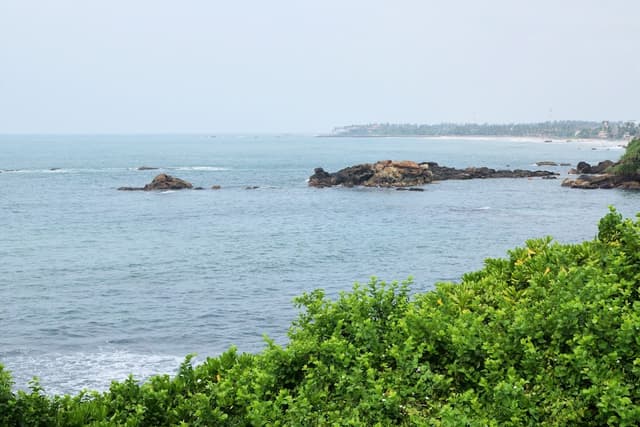
Aeolus Bastion
@ravinkavish
Aeolus Bastion is one of the prominent bastions within Galle Fort, built by the Dutch during the 17th century as part of their efforts to fortify the town against foreign invasions. Named after Aeolus, the Greek god of winds, this bastion is strategically located along the fort's ramparts, offering expansive views of the Indian Ocean and the town of Galle.
Historically, the bastion was used as a lookout point for spotting approaching ships, particularly during the colonial era when Galle was an important port for trade and military operations. Today, it stands as a well-preserved example of Dutch colonial military architecture. Visitors can explore its remains, enjoy the panoramic vistas, and appreciate the bastion’s role in Galle's rich history. It’s an excellent stop for travelers interested in both the fort’s past and the stunning coastal scenery.
Add to
Details

Clippenberg Bastion
@ravinkavish
Clippenberg Bastion, located within the historic Galle Fort, is one of the fort's key defensive structures, offering a glimpse into the strategic military significance of the area during the colonial period. Built by the Dutch in the 17th century, the bastion was part of the fort’s extensive fortifications designed to protect the harbor and the town from naval attacks. It features thick stone walls and a commanding view of the sea, providing a prime vantage point for spotting enemy ships.
Today, the bastion is a peaceful spot within the fort, offering scenic views of the ocean and the bustling town of Galle. It's a great stop for history lovers and photographers, as the site combines colonial-era architecture with breathtaking views, making it a must-see for travelers exploring Galle Fort's rich history.
Add to
Details

Dutch Reformed Church
@ravinkavish
The Dutch Reformed Church, also known as **Groote Kerk**, is a historic gem within the Galle Dutch Fort, dating back to 1755. Built by the Dutch, this church is a striking example of colonial-era architecture, with its gabled roof, simple whitewashed walls, and antique wooden pews. Its floor, paved with gravestones from the 17th and 18th centuries, holds stories of the past, while the church's interior houses an impressive pulpit carved from calamander wood.
Surrounded by the tranquil atmosphere of the fort, this well-preserved landmark offers a glimpse into Sri Lanka's colonial heritage and a moment of peace amidst the bustling streets. It's a must-visit for history enthusiasts and architecture lovers.
Add to
Details

All Saints' Church, Galle - Church of Ceylon
@ravinkavish
All Saints' Church in Galle, located within the historic Galle Fort, is a beautifully preserved Anglican church consecrated in 1871. Built in a striking Gothic Revival style, the church features intricate stained glass windows, high vaulted ceilings, and finely crafted wooden pews, showcasing British colonial influence.
Nestled amidst the cobbled streets of the fort, it stands as a testament to Sri Lanka's multicultural history and architectural diversity. Whether you're drawn by its serene ambiance or its historical significance, All Saints' Church offers visitors a glimpse into the spiritual and cultural legacy of Galle Fort.
Add to
Details
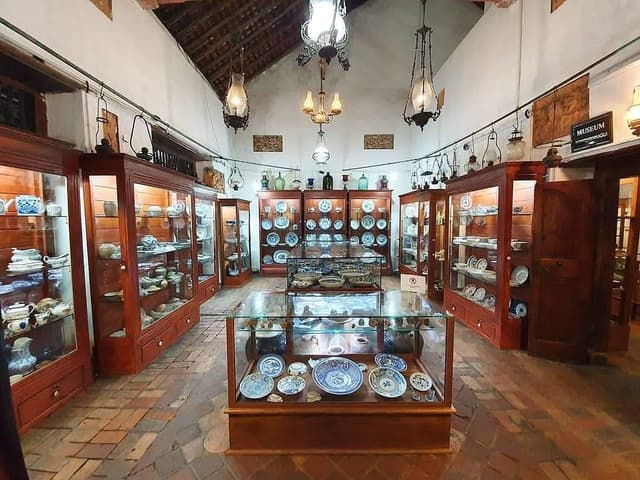
Historical Mansion Museum
@ravinkavish
Add to
Details

Maritime Museum
@ravinkavish
The Maritime Museum in Galle is a fascinating dive into Sri Lanka’s seafaring history, located within the UNESCO-listed Galle Fort. Housed in a restored colonial warehouse from the 17th century, the museum vividly showcases the island’s maritime heritage, highlighting its connections to trade, exploration, and naval history. It is the only museum in Sri Lanka dedicated solely to maritime culture and history.
Inside, visitors can explore a collection of artifacts, including ancient shipwrecks, navigational equipment, maps, and fishing tools that reflect the maritime activities of the Dutch, Portuguese, and British colonial eras. The museum also highlights the region's rich biodiversity with exhibits on coral reefs and marine life, emphasizing the importance of coastal conservation.
The building itself, with its thick walls and vaulted ceilings, is a testament to Dutch colonial architecture. A visit to the Maritime Museum is perfect for history enthusiasts and curious travelers wanting to uncover the stories of Galle’s port, which was once a bustling hub in the Indian Ocean trade network.
Add to
Details
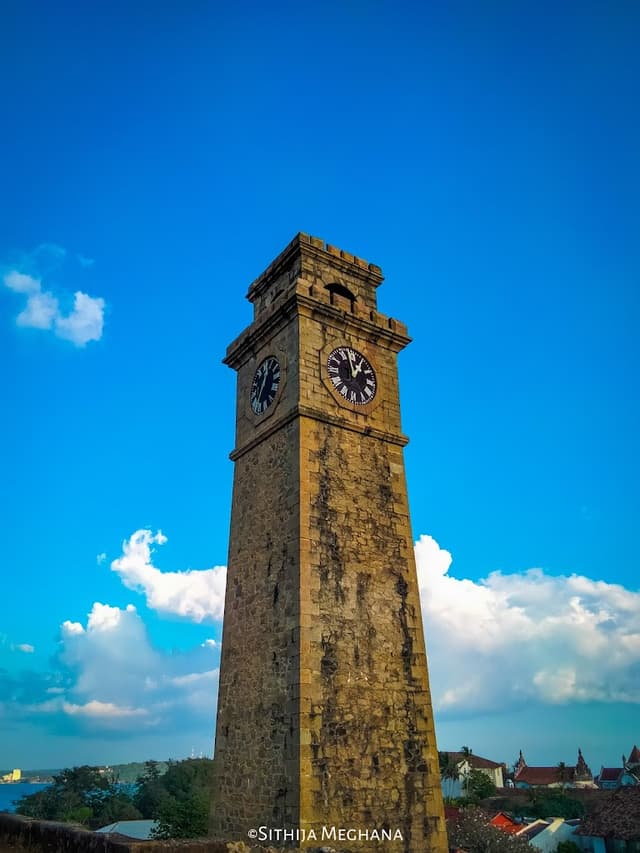
Galle Fort Clock Tower
@ravinkavish
The Galle Fort Clock Tower is an iconic feature of the Galle Dutch Fort, standing tall since 1883 as a tribute to Dr. Peter Daniel Anthonisz, a respected local surgeon. Its sturdy, four-sided stone structure reflects colonial architectural influences and serves as a striking landmark within the fort. Positioned near the main entrance, the clock tower offers a glimpse into the fort's history while adding to its timeless charm. A visit to this historic tower provides a deeper appreciation of the rich heritage preserved within Galle Fort.
Add to
Details

Yatagala Raja Maha Viharaya
@ravinkavish
Yatagala Raja Maha Viharaya, a serene Buddhist temple near Unawatuna, is a hidden gem steeped in history. Believed to be over 2,300 years old, this ancient site was built during the Anuradhapura era and is nestled among massive granite boulders, creating a tranquil and unique atmosphere. The temple is said to have once been blessed by a visit from King Devanampiyatissa, tying it to the origins of Buddhism in Sri Lanka.
The temple complex features a stunning reclining Buddha statue, age-old frescoes, and an atmosphere of deep peace. Surrounded by lush greenery, it’s a perfect place for meditation and reflection.
**Pro tip:** Visit early in the morning to enjoy the quiet ambiance, and take some time to admire the panoramic views from the temple grounds.
Add to
Details

Unawatuna Beach
@ravinkavish
Unawatuna Beach, located just a few kilometers from Galle, is one of Sri Lanka’s most famous and idyllic coastal destinations. Known for its golden sands, calm turquoise waters, and lush palm-fringed shoreline, it’s a perfect spot for swimming, sunbathing, and snorkeling. The beach also has a lively vibe with plenty of beachfront cafes, bars, and shops catering to travelers.
Nearby, you can explore the iconic **Jungle Beach** or visit the **Peace Pagoda**, which offers stunning panoramic views of the coastline. Unawatuna is also known for its vibrant nightlife, making it a favorite for travelers seeking both relaxation and entertainment.
**Pro tip:** Visit early morning for a serene experience, and don’t miss the sunset—it’s magical here!
Add to
Details

Rumassala Sanctuary
@ravinkavish
Add to
Details

National Museum Galle
@ravinkavish
The National Museum of Galle, located within the Galle Fort, is a treasure trove of history and culture, housed in a beautiful Dutch-era building dating back to 1656. This museum provides a fascinating glimpse into Sri Lanka’s past, featuring exhibits that highlight the region's maritime history, colonial influence, and traditional crafts.
Artifacts on display include ancient tools, weaponry, trade goods, and intricately carved wooden objects from the Kandyan era. The museum also showcases items reflecting the blend of cultures that shaped Galle, such as Dutch porcelain and Sri Lankan masks.
**Pro tip:** Visit early to enjoy the museum’s quiet atmosphere and take time to explore the building’s colonial architecture, which is a piece of history itself.
Add to
Details

British Queen's House
@ravinkavish
The **British Queen’s House**, located within the Galle Fort, is a colonial-era building that reflects the architectural elegance of the British period in Sri Lanka. It earned its name during the time of British rule when it served as the official residence for British governors and high-ranking officials visiting the southern region. The name "Queen’s House" was commonly used to denote official government residences associated with the British monarchy in their colonies.
Today, the building stands as a historical relic, showcasing classic British colonial design with arched verandas, high ceilings, and well-crafted woodwork. Although not open to the public, its exterior is a fascinating sight for history enthusiasts exploring the fort.
**Pro tip:** Look for this landmark while walking along the fort’s charming streets—it’s near other key attractions like the lighthouse and the ramparts.
Add to
Details

Black Galle Fort - Zwart Bastion
@ravinkavish
Zwart Bastion, also known as the Black Bastion, is one of the key defensive structures in Galle Fort, built by the Dutch in the 17th century. The name "Zwart" translates to "black" in Dutch, which could refer to the darker stone used in its construction or its position as a prominent fortification along the fort's ramparts. Like other bastions in the fort, Zwart Bastion was designed to protect the port of Galle from naval attacks and served as a strategic lookout point.
Today, the Zwart Bastion offers a fascinating insight into the military architecture of the Dutch colonial period. It provides stunning views of the ocean, the Galle harbor, and the surrounding town, making it a great spot for history enthusiasts and travelers looking to appreciate the historical and scenic beauty of the area. The bastion, while not as well-known as some other parts of the fort, remains an integral part of Galle’s fortifications and is a reminder of the town’s strategic importance during the colonial era.
Add to
Details

Galle Fort - Akersloot Bastion
@ravinkavish
Add to
Details

Old Dutch Hospital
@ravinkavish
Add to
Details

Star Bastion
@ravinkavish
Add to
Details

Stick No Bills®️ Asia Flagship Gallery
@ravinkavish
Add to
Details

Natural Pool Thalpe
@ravinkavish
Add to
Details

Thalpe Beach
@ravinkavish
Thalpe Beach, located just south of Unawatuna, is a serene and less-crowded stretch of coastline known for its unique charm and natural beauty. The beach features a series of iconic rectangular rock pools carved into the reef during the colonial era, originally used for harvesting salt. These pools now serve as relaxing natural jacuzzis during low tide.
The soft golden sands and gentle waves make Thalpe a perfect spot for unwinding, while its laid-back vibe attracts travelers looking to escape the busier beaches nearby. A few boutique hotels and stylish cafes add to the beach’s quiet sophistication.
**Pro tip:** Time your visit with the low tide to experience the rock pools, and bring a camera—the setting is picture-perfect!
Add to
Details

Kabalana beach
@ravinkavish
Add to
Details

Japanese Peace Pagoda - Rumassala
@ravinkavish
The Japanese Peace Pagoda, located in the tranquil area of Rumassala near Unawatuna, is a stunning landmark that offers both spiritual solace and sweeping views of the Indian Ocean. Built by Japanese monks in 2005, the pagoda stands as a symbol of peace and harmony, reflecting the spirit of Buddhist teachings.
The pagoda's design is simple yet majestic, with its white dome standing out against the lush greenery and the blue ocean backdrop. Visitors can enjoy a peaceful atmosphere, perfect for meditation or simply appreciating the surrounding natural beauty.
**Best time to visit:** The best time to visit the Japanese Peace Pagoda is during the early morning or late afternoon when the weather is cooler, and the views are spectacular. The walk up to the pagoda is short but scenic, making it a great stop for travelers near Unawatuna or Galle.
If you're in the area, the Japanese Peace Pagoda is a serene and culturally rich spot worth experiencing.
Add to
Details
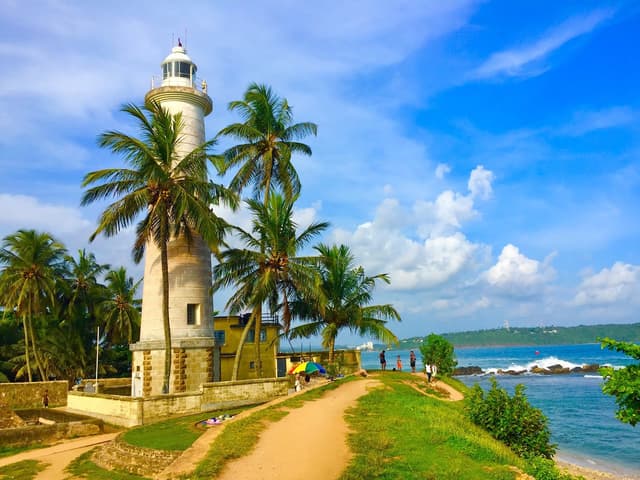
Galle Dutch Fort
@ravinkavish
The Galle Dutch Fort, a UNESCO World Heritage Site, is a captivating blend of history, culture, and coastal beauty. Built by the Portuguese in 1588 and later fortified by the Dutch in the 17th century, this iconic landmark is a testament to Sri Lanka's colonial past and architectural brilliance. The fort's massive stone walls have withstood centuries of weather and waves, offering stunning views of the Indian Ocean.
Inside the fort, you'll find cobblestone streets lined with colonial-era buildings, charming boutiques, art galleries, and cafes. Highlights include the Galle Lighthouse, the Dutch Reformed Church, and the Maritime Museum. As you wander, the mix of European and South Asian influences becomes evident in the architecture and atmosphere.
**Best time to visit:** Visit in the late afternoon to enjoy cooler weather and a magical sunset over the ramparts. Exploring in the evening is also delightful as the fort comes alive with lights and a vibrant atmosphere.
The Galle Dutch Fort is a must-visit destination for history enthusiasts, architecture lovers, and anyone seeking to experience the charm of Sri Lanka's southern coast.
Add to
Details

Koggala Beach
@ravinkavish
Koggala Beach, located along Sri Lanka’s southern coast, is a pristine stretch of golden sands kissed by the turquoise waves of the Indian Ocean. Known for its natural beauty and calm surroundings, it’s perfect for long beach walks, swimming, and sunbathing. Koggala is also famous for its traditional **stilt fishermen**, a unique and photogenic sight symbolizing the region’s coastal heritage.
Close by, you’ll find the **Koggala Lake** and Martin Wickramasinghe Folk Museum, adding cultural and ecological experiences to your visit. With fewer crowds, Koggala offers a peaceful escape for travelers seeking tranquility.
**Pro tip:** Visit early morning to catch the stilt fishermen in action and enjoy a serene start to your day.
Add to
Details
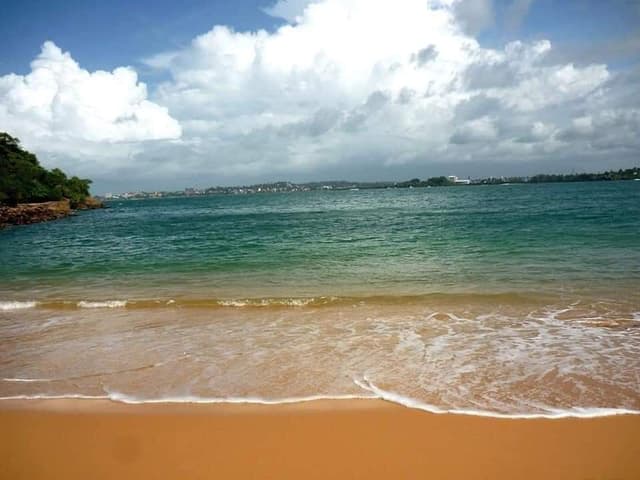
Rumassala South Beach
@ravinkavish
Add to
Details

Midigama Beach
@ravinkavish
Midigama Beach, located between Weligama and Ahangama, is a hidden gem for surfers and beach lovers. Known for its consistent waves, it’s a great spot for both beginners and more experienced surfers. The beach has a relaxed, laid-back vibe with a less crowded atmosphere compared to nearby hotspots.
In addition to surfing, Midigama offers a peaceful environment for swimming, sunbathing, and beach walks. The surrounding area has a mix of small guesthouses and cafes, providing a perfect escape for those looking to enjoy the natural beauty of Sri Lanka’s southern coast.
**Pro tip:** Visit during the early morning or late afternoon for a quieter experience and to catch the best surf conditions.
Add to
Details
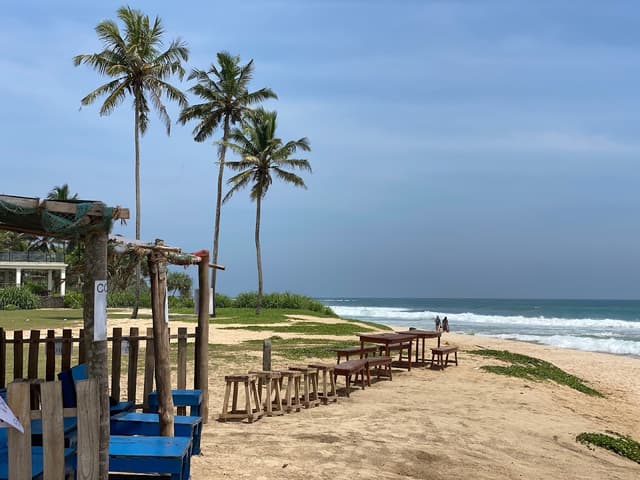
Coconut Point natural pool
@ravinkavish
Coconut Point Natural Pool, located near Ahangama, is a serene and unique spot where the ocean meets a natural rock pool. This hidden gem is perfect for swimming, as the pool is sheltered from the rough sea, providing calm and clear waters. Surrounded by lush greenery and rocks, the natural pool offers a peaceful environment away from the crowds.
It’s an ideal spot for those looking to relax, enjoy the beauty of the coastline, and take a refreshing dip. The area is also great for photography, with its stunning natural landscape.
**Pro tip:** The natural pool is best visited during low tide when the water is calmest. Be mindful of the surrounding rocks, as they can be slippery.
Add to
Details

Abimanagama Beach
@ravinkavish
Abimanagama Beach, located near Weligama, is a quiet, lesser-known beach offering a peaceful escape from the more crowded tourist spots. The beach features soft golden sands and clear, calm waters, making it an ideal spot for swimming, sunbathing, and leisurely walks along the shore. The surrounding area is relatively untouched, providing a serene atmosphere for relaxation.
With fewer visitors, Abimanagama Beach is perfect for those looking to enjoy the natural beauty of Sri Lanka’s southern coastline in a more tranquil setting.
**Pro tip:** It’s best to visit early in the morning or late afternoon for a quiet, uncrowded experience and to enjoy the stunning coastal views.
Add to
Details

Coconut Beach
@ravinkavish
Coconut Beach, located near Ahangama, is a tranquil and scenic spot known for its palm-lined shores and clear blue waters. It’s a quiet escape, offering a peaceful environment ideal for swimming, sunbathing, or simply relaxing under the shade of the coconut trees. The beach is less crowded compared to nearby areas, making it perfect for those seeking a more serene and private experience.
The gentle waves make it a great spot for a refreshing dip, while the surrounding landscape of lush greenery adds to the beauty of the place.
**Pro tip:** Visit during the morning or late afternoon for a peaceful atmosphere and stunning views, especially at sunrise or sunset.
Add to
Details

Mirissa Beach
@ravinkavish
Mirissa Beach, nestled on Sri Lanka’s southern coast, is a slice of tropical paradise renowned for its golden sands, swaying coconut palms, and crystal-clear waters. Its laid-back atmosphere and scenic beauty make it one of the island’s most beloved beaches.
The beach’s gentle waves are perfect for swimming, snorkeling, or paddleboarding, while the eastern end offers great spots for beginner-friendly surfing. A highlight of Mirissa Beach is **Parrot Rock**, a small islet accessible at low tide, providing breathtaking views of the surrounding coastline.
During the season (November to April), the beach transforms into a starting point for **whale-watching adventures**, with boats departing at dawn to spot blue whales, sperm whales, and dolphins. It’s an experience that brings nature lovers from all over the world.
The western end of the beach comes alive in the evening with vibrant beach bars and seafood restaurants, offering fresh catches of the day, tropical cocktails, and live music under the stars.
**Pro tip:** For the best experience, visit during sunrise to enjoy the serene beauty before the crowds arrive. Stay into the evening to soak in the lively atmosphere of this tropical gem.
Add to
Details

Parrot Rock
@ravinkavish
Parrot Rock is a small rocky islet just off Mirissa Beach, offering one of the best vantage points to soak in the beauty of this coastal paradise. Accessible by wading through shallow water at low tide, the rock is a favorite spot for travelers seeking a panoramic view of Mirissa's crescent-shaped beach and the endless blue ocean.
The climb to the top is short but slightly steep, making it an adventurous yet rewarding experience. Once at the summit, you’re greeted by a peaceful atmosphere, gentle sea breezes, and breathtaking scenery, particularly during sunrise or sunset when the colors of the sky transform the landscape.
Though its name suggests a connection to parrots, the origins of the name remain unclear. What’s certain is that Parrot Rock has become an iconic part of Mirissa’s coastal charm, drawing photographers and nature lovers alike.
**Pro tip:** Visit during low tide for safe access and wear sturdy footwear as the rocks can be slippery. Plan a morning or evening trip to avoid the midday heat and catch the best views.
Add to
Details

Coconut Tree Hill
@ravinkavish
Coconut Tree Hill in Mirissa is a scenic spot that has become increasingly popular among travelers for its stunning views and Instagram-worthy scenery. Perched on a hilltop, the area is dotted with tall, swaying coconut trees that perfectly frame the horizon, offering a picture-perfect view of the turquoise waters of the Indian Ocean and the surrounding coastline.
Though it’s not a traditional beach or historical site, **Coconut Tree Hill** has earned its place as one of the top photo spots in Sri Lanka. Visitors often come here to watch the sunset or simply to take in the breathtaking landscape. The hill is easily accessible, with a short walk to the top from the main road, where the towering coconut trees and panoramic views await.
The site was originally a small fishing village area, but in recent years it has become a popular stop for those exploring Mirissa. It's an excellent spot to relax, take in the natural beauty, and capture some incredible photographs.
**Pro tip:** Early mornings or late afternoons are the best times to visit, as the lighting is perfect for photos and the temperature is more comfortable. Be mindful of the local environment and avoid disturbing the coconut trees.
Add to
Details

Madiha Beach
@ravinkavish
Madiha Beach, located just a short distance from Matara, is a serene and lesser-known gem along Sri Lanka’s southern coastline. This quiet stretch of golden sand is perfect for those seeking a peaceful escape, away from the more crowded beaches in the region.
Madiha is known for its calm and clear waters, making it a great spot for swimming, snorkeling, and relaxing. The beach is surrounded by lush greenery and palm trees, adding to its tropical charm. It’s also less commercialized, so visitors can enjoy a more laid-back atmosphere with fewer tourists around.
A highlight of Madiha Beach is its proximity to the **Madiha Reef**, which is home to vibrant coral reefs and marine life. Snorkelers and divers can explore the underwater world, with the chance to see colorful fish, sea turtles, and other marine creatures.
**Pro tip:** Madiha Beach is perfect for those who want a peaceful day by the sea without the crowds. While there are a few guesthouses and small cafes nearby, it retains a rustic charm. The best time to visit is during the dry season from November to April, when the weather is ideal for water activities and beach relaxation.
Add to
Details

Wewurukannala Buduraja Maha Viharaya
@ravinkavish
Wewurukannala Buduraja Maha Viharaya, located in the small town of Wewurukannala in southern Sri Lanka, is a significant Buddhist temple known for its towering statue of the Buddha, which stands at an impressive height of 50 feet. This majestic statue is one of the largest in Sri Lanka and can be seen from miles away, making it a notable landmark in the region.
The temple complex also features beautiful murals, intricately decorated shrines, and a serene atmosphere that attracts both devotees and tourists seeking a peaceful and spiritual experience. The temple is set against a backdrop of lush greenery, and visitors can explore the surrounding areas, including a series of steps leading up to the Buddha statue, offering a great view of the countryside.
The temple's history dates back centuries, with various renovations over the years, and it remains a vibrant place of worship for locals. Visitors can also enjoy the tranquility of the temple grounds, making it an ideal spot for meditation or a reflective visit.
**Pro tip:** The temple is relatively quiet compared to more famous tourist sites, offering a more intimate and serene experience. Be respectful of the religious site, and dress modestly when visiting.
Add to
Details
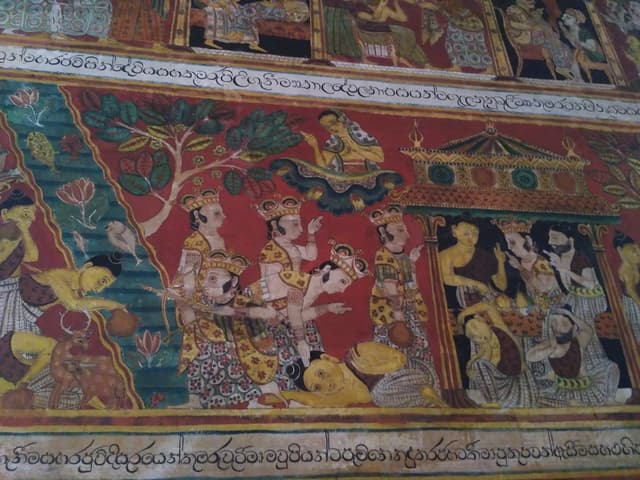
Samudragiri Viharaya
@ravinkavish
Samudragiri Viharaya, located in Mirissa, is a serene Buddhist temple perched on a hill overlooking the stunning Indian Ocean. The name “Samudragiri” translates to “Ocean Hill,” reflecting its breathtaking coastal vantage point. This temple offers a tranquil escape from the bustling beach scene below, making it an ideal spot for spiritual reflection or simply soaking in the natural beauty.
The temple’s highlight is the **giant seated Buddha statue**, which faces the sea, symbolizing peace and harmony. Visitors can enjoy panoramic views of Mirissa’s coastline and the surrounding lush greenery from the temple grounds. The atmosphere is calm and meditative, with the sound of waves providing a soothing backdrop.
Though relatively modest compared to Sri Lanka’s ancient temples, Samudragiri Viharaya is rich in spiritual significance for the local community and offers travelers a glimpse into the island's Buddhist heritage.
**Pro tip:** Visit during sunset for a magical view as the golden light bathes the ocean and surrounding landscape. Dress modestly to show respect, as this is a place of worship.
Add to
Details

Depiyassa Gala -
@ravinkavish
Add to
Details

Secret Beach Mirissa
@ravinkavish
Secret Beach Mirissa has become more popular over the years, and while it still retains a sense of seclusion, it's no longer the hidden gem it once was. However, despite the increasing visitors, it still offers a peaceful atmosphere compared to the busier Mirissa Beach.
The beach's natural charm remains intact, with its clear waters, picturesque rocky formations, and peaceful vibe. It's a perfect spot for a relaxed day by the ocean, swimming, snorkeling, or simply enjoying the beauty of the surroundings. While it’s not as quiet as it used to be, it still offers a great alternative to the crowds, especially if you visit during off-peak hours.
Pro tip: To enjoy the beach at its most serene, visit early in the morning or later in the afternoon when the crowds thin out. Though it's more popular now, it’s still worth the visit for its stunning beauty.
Add to
Details

Dondra Head Lighthouse
@ravinkavish
**Dondra Head Lighthouse**, standing proudly at the southernmost point of Sri Lanka near Matara, is an iconic landmark and one of the tallest lighthouses in Southeast Asia. Built in 1889 by the British, this towering 49-meter structure is constructed from granite and painted white, making it a striking feature against the azure skies and turquoise waters.
The lighthouse serves as a vital navigational aid, guiding ships along the southern coast and marking the meeting point of the Indian Ocean. Its location offers breathtaking panoramic views of the coastline and the endless ocean, making it a favorite spot for photography and quiet reflection.
Visitors are often enchanted by the serene surroundings, with lush greenery and the gentle sound of waves adding to the charm. While entry into the lighthouse is restricted, the area around it provides a peaceful atmosphere to enjoy the southern tip of the island.
**Pro tip:** Visit Dondra Head during the late afternoon to enjoy cooler weather and catch a stunning sunset over the Indian Ocean. The lighthouse is easily accessible from Matara and can be part of a scenic coastal day trip.
Add to
Details

LightHouse View From Sea
@ravinkavish
Add to
Details

Hummana Beach Dondra
@ravinkavish
**Hummanaya Beach**, located near Dondra, is not just a picturesque coastal spot but also home to Sri Lanka’s famous natural blowhole, the **Hummanaya Blowhole**. This beach is where nature puts on a dramatic show, as water shoots high into the air through a natural fissure in the rock, creating a spectacle that's both powerful and mesmerizing.
The beach itself is serene and less crowded, offering visitors a chance to relax while taking in the rugged beauty of the southern coastline. The turquoise waters, rocky cliffs, and the sound of crashing waves create a perfect escape for nature lovers and adventurers.
For an unforgettable experience, walk to the blowhole during high tide when the waves are strongest, and witness the spray shooting up to 30 meters. The area around the beach also features small eateries and local shops where you can enjoy fresh seafood and refreshments.
**Pro tip:** Combine your visit to Hummanaya Beach with a trip to the nearby **Dondra Head Lighthouse** for a full day of exploring Sri Lanka’s southernmost treasures. The best time to see the blowhole in action is during the monsoon season when the sea is rougher.
Add to
Details

Hiriketiya Beach
@ravinkavish
Hiriketiya Beach, located in the small town of Dickwella on Sri Lanka’s southern coast, is a stunning crescent-shaped bay known for its laid-back atmosphere, crystal-clear waters, and picturesque surroundings. This hidden gem is perfect for those seeking a quiet and relaxed beach experience, away from the more crowded tourist spots.
The beach is a popular spot for surfing, especially for beginners and intermediate surfers, thanks to its gentle yet consistent waves. Its sheltered bay also makes it ideal for swimming, paddleboarding, and sunbathing. The palm-lined shore and clear, turquoise waters create a serene setting, perfect for those looking to unwind.
**Pro tip:** Hiriketiya is not only great for beach activities but also for enjoying delicious seafood at the local cafes and beachside restaurants. The beach is perfect for a day of relaxation, and if you're into surfing, don't miss catching a few waves at this beautiful bay. The best time to visit is between November and April when the weather is ideal for outdoor activities.
Add to
Details

Matara
@ravinkavish
Matara, located along Sri Lanka’s southern coast, is renowned for its beautiful and tranquil beaches, offering a perfect mix of relaxation and adventure. The beaches here are less crowded compared to other tourist hotspots, making them ideal for those seeking a peaceful coastal experience.
**Polhena Beach** is one of the standout beaches in Matara, famous for its calm waters and coral reefs, making it a perfect spot for snorkeling and swimming. The beach is lined with palm trees and has a relaxed vibe, with a few local eateries serving fresh seafood right by the water.
**Matara Beach** itself offers stunning views and a quieter atmosphere compared to other southern beaches. It’s ideal for long walks along the shore, swimming, or simply enjoying the sunset. Nearby, you’ll find the **Matara Fort** and local markets, adding a touch of culture to your beach experience.
For a more secluded experience, **Madhiha Beach** is a hidden gem located just a short drive from the town. It’s perfect for those looking to escape the crowds and enjoy the natural beauty of Sri Lanka’s southern coastline.
**Pro tip:** Matara’s beaches are best visited during the dry season from November to April, when the weather is perfect for sunbathing, swimming, and exploring.
Add to
Details

Weligama
@ravinkavish
Weligama is a lively coastal town located between Mirissa and Matara, known for its long sandy beach, surf-friendly waves, and vibrant atmosphere. The name "Weligama" translates to "sandy village," and the beach lives up to its name with its expansive shoreline perfect for beach walks, swimming, and sunbathing.
Weligama is particularly famous for its surf scene, attracting both beginners and seasoned surfers. The beach is known for its gentle, consistent waves, making it a great place to take surf lessons or simply enjoy the ocean. It's also home to the unique **stilt fishing** method, where fishermen perch on stilts in the shallow waters, a practice that has become a notable feature of the local culture.
Beyond the beach, Weligama has a relaxed, yet vibrant atmosphere, with a growing number of cafes, restaurants, and shops along the main road. The town is also a great base for exploring nearby attractions like **Kushtarajagala Temple**, which features a large statue of a seated Buddha.
For those looking for a mix of relaxation, adventure, and local culture, Weligama offers an ideal blend.
**Pro tip:** For a quieter experience, visit early in the morning or during weekdays, when the beach is less crowded. Don’t miss the stilt fishermen, especially at sunrise or sunset, for a truly unique photo opportunity.
Add to
Details

Mirissa
@ravinkavish
**Mirissa**, a charming beach town on Sri Lanka’s southern coast, is the ultimate tropical getaway known for its stunning sandy beaches, vibrant nightlife, and unforgettable marine experiences. Whether you're seeking relaxation or adventure, Mirissa has something for everyone.
The crescent-shaped **Mirissa Beach** is the town’s crown jewel, offering crystal-clear waters perfect for swimming, snorkeling, or simply lounging under the sun. It’s also a hub for water sports, with options like surfing for both beginners and seasoned riders.
One of Mirissa's most iconic attractions is **Parrot Rock**, a small rocky islet accessible during low tide, offering panoramic views of the coastline. For a magical sunrise or sunset, it's the perfect spot to soak in the beauty of the Indian Ocean.
Mirissa is also world-famous for **whale watching**, particularly from November to April. Tours departing from Mirissa Harbor give visitors a chance to see blue whales, sperm whales, and playful dolphins up close.
The vibrant nightlife features beachfront restaurants and bars offering fresh seafood, cocktails, and live music. It's an ideal setting for travelers to unwind and socialize.
**Pro tip:** Visit Mirissa early in the morning for whale watching and spend the rest of the day exploring the beach or nearby attractions like the secret beach or Weligama. The best time to visit is during the dry season for calm seas and clear skies.
Add to
Details

Star Fort - Matara
@ravinkavish
The **Star Fort** in Matara is a unique historical landmark built during the Dutch colonial period in 1765. Its name comes from its distinctive star-shaped design, created for better defense against invaders. This architectural gem stands as a testament to Dutch ingenuity and their efforts to protect the Matara area from outside threats, particularly attacks by the Kingdom of Kandy.
Unlike larger forts, the Star Fort is relatively small, with thick walls and strategically placed bastions. Inside, it housed a barracks, a well for fresh water, and an armory. Today, the fort has been beautifully preserved and converted into a small museum that showcases artifacts from the colonial era, offering visitors a glimpse into the history of Matara and its role in Sri Lanka's maritime trade routes.
**Pro tip:** The Star Fort is just a short walk from the Matara Fort and can be explored in less than an hour. Its compact size and intriguing design make it a must-visit for history enthusiasts. Combine your visit with a stroll through the nearby Matara town to experience the local culture and cuisine.
Add to
Details

Colombo Bandaranaike International Airport
@ravinkavish
Add to
Details

Colombo
@ravinkavish
Colombo, Sri Lanka’s vibrant capital, is a dynamic blend of modernity and history, offering travelers a unique mix of culture, cuisine, and charm. This bustling metropolis is home to a diverse array of attractions, from ancient temples and colonial-era buildings to contemporary skyscrapers and chic cafes.
Explore the historic Fort area, where Dutch and British colonial architecture meet modern developments, or stroll along Galle Face Green, a seaside promenade perfect for catching sunsets. For those interested in culture, the Gangaramaya Temple and Independence Square showcase the city's rich heritage. Colombo also boasts lively markets like Pettah, where you can shop for everything from spices to souvenirs.
Pro tip: Colombo is a great starting or ending point for your Sri Lankan journey, with convenient access to the airport. Plan to spend at least a day exploring its highlights and indulging in the local cuisine, especially at the trendy restaurants and street food stalls scattered across the city.
Add to
Details

Presidential Secretariat
@ravinkavish
The **Presidential Secretariat** in Colombo is a grand colonial-era building that serves as the official office of the President of Sri Lanka. Built in **1930**, this iconic structure was originally the General Post Office during British rule. Its neoclassical architecture, characterized by towering columns and intricate details, reflects the grandeur of its historical origins.
Located near the bustling Galle Face Green, the Secretariat holds a significant place in Sri Lanka’s political history and governance. Although access to the building's interior is restricted, its striking façade and the surrounding area make it a popular spot for photography and sightseeing.
**Pro tip:** Combine your visit with a walk along Galle Face Green to enjoy the area’s historical and modern landmarks. The illuminated view of the Secretariat at night adds a touch of elegance to Colombo’s cityscape.
Add to
Details

Colombo Galbokka Lighthouse
@ravinkavish
Add to
Details
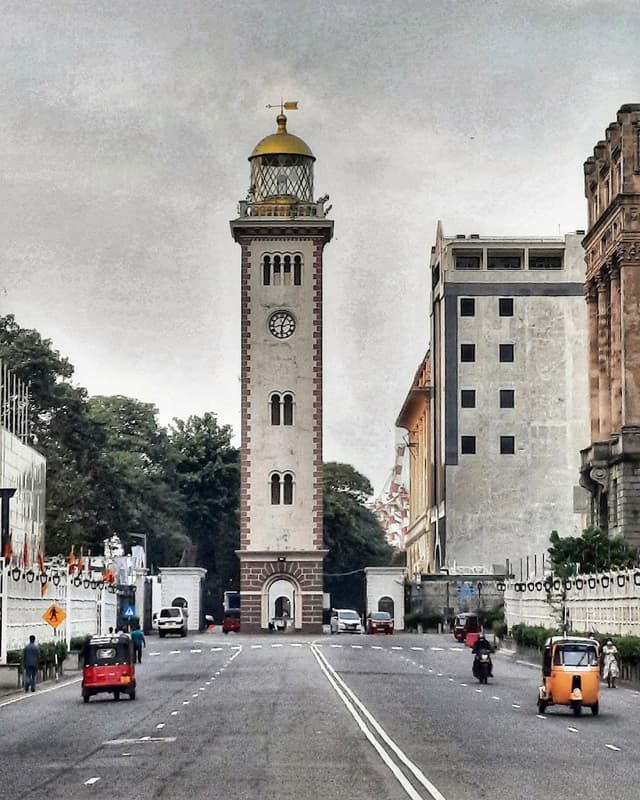
Colombo Fort Old Lighthouse & Clock Tower
@ravinkavish
The **Old Colombo Lighthouse and Clock Tower**, located in the Colombo Fort area, is an iconic historical landmark with a fascinating dual purpose. Built in **1857** during British rule, this 29-meter-tall structure initially served as a lighthouse guiding ships into Colombo's harbor. In **1914**, its light was deactivated as taller buildings obscured its beam, but it continues to function as a clock tower.
Designed by Lady Ward, the wife of Governor Sir Henry Ward, the tower’s neo-classical architecture adds charm to Colombo's bustling financial district. The clock mechanism, made in England, is still operational, making it one of Asia’s oldest clock towers in continuous use.
**Pro tip:** Look out for the engraved royal insignia near the base, and combine your visit with a walk around the Colombo Fort area to discover more colonial-era gems.
Add to
Details

Dutch Hospital - Shopping Precinct
@ravinkavish
The **Dutch Hospital Shopping Precinct**, located in the heart of Colombo, is a beautifully restored colonial building that dates back to the **17th century**. Originally a hospital during Dutch rule, it is considered one of the oldest surviving structures in Colombo. Its thick walls and terracotta roof tiles reflect classic Dutch colonial architecture, seamlessly blending history with modernity.
Today, the precinct is a vibrant hub of activity, housing high-end boutiques, restaurants, and cafes. It’s the perfect spot to shop for souvenirs, indulge in fine dining, or simply relax with a drink in its open-air courtyards. The atmosphere comes alive in the evenings with live music and a lively crowd.
**Pro tip:** Try the local seafood at one of the restaurants, and don’t miss exploring the nearby landmarks like the World Trade Center and Old Colombo Lighthouse. It’s an ideal mix of history, culture, and modern-day leisure.
Add to
Details

Jami Ul-Alfar Mosque
@ravinkavish
The **Jami Ul-Alfar Mosque**, also known as the **Red Mosque**, is one of Colombo’s most striking landmarks. Located in the heart of the city, near the bustling Pettah market area, this mosque was built in **1909** and is renowned for its unique and vibrant red-and-white striped exterior, which makes it instantly recognizable. Its Indo-Saracenic architectural style blends Islamic design with local influences, making it one of the most beautiful mosques in Sri Lanka.
The mosque is an active place of worship and has become a symbol of the multicultural nature of Colombo. While the mosque itself is not open to non-Muslim visitors during prayer times, its impressive architecture makes it a popular spot for photographs.
**Pro tip:** Visit the mosque during the early morning or late afternoon to capture its beauty in the soft natural light. While you're in the area, explore the nearby Pettah market for a true taste of Colombo’s vibrant street life.
Add to
Details

Colombo Lotus Tower
@ravinkavish
Add to
Details

Colombo Town Hall
@ravinkavish
The Colombo Town Hall, built in **1928**, is one of the most iconic colonial-era landmarks in the city. Designed in a Neo-Classical style, the building features a grand white façade with towering pillars and a central dome reminiscent of Washington, D.C.’s Capitol building. It was originally constructed to house the administrative offices of the Colombo Municipal Council and still serves that purpose today.
Set amidst the lush greenery of **Viharamahadevi Park**, the Town Hall is a favorite spot for photography and sightseeing. Though the building itself is not open for tours, its majestic exterior and surroundings make it a must-see while exploring Colombo.
**Pro tip:** Visit during the evening when the building is beautifully illuminated. Pair it with a walk through Viharamahadevi Park for a relaxing escape from the city’s hustle and bustle.
Add to
Details

Dawatagaha Jumma Masjid
@ravinkavish
The Dawatagaha Jumma Masjid, located in Colombo, is a historic and spiritual landmark cherished by the city’s Muslim community. Established in the early **19th century**, this mosque is renowned for its elegant white façade, striking minarets, and serene atmosphere. The mosque also holds a special place as the shrine of **Sheikh Usman Waliyullah**, a revered Sufi saint whose tomb attracts pilgrims seeking blessings and solace.
Nestled in the heart of Colombo, Dawatagaha Masjid is a symbol of the city's multicultural harmony and a peaceful retreat for travelers interested in its rich religious heritage.
**Pro tip:** Visitors are welcome, but be sure to dress modestly and respect the prayer times. The mosque’s intricate architecture and spiritual ambiance make it a unique cultural experience in Colombo.
Add to
Details

Viharamahadevi Park
@ravinkavish
Viharamahadevi Park, Colombo’s largest and oldest public park, is a lush green haven amidst the city’s bustling streets. Originally named **Victoria Park** during the British colonial era, it was later renamed in honor of **Queen Viharamahadevi**, a revered figure in Sri Lankan history. The park boasts a rich history, dating back to the late **19th century**, and has been a cherished spot for locals and visitors alike.
The park is adorned with vibrant flower beds, tall palm trees, and tranquil water features, making it a perfect spot for relaxation and picnics. It also features a children’s play area, a mini zoo, and a golden statue of Buddha, adding to its charm. The park often hosts cultural events, making it a lively hub of activity.
**Pro tip:** Visit early in the morning or late afternoon to enjoy the park’s cool breeze. It’s a wonderful place to unwind after exploring Colombo’s landmarks, with attractions like the Colombo Town Hall and National Museum just a short walk away.
Add to
Details

Gangaramaya Temple
@ravinkavish
The Gangaramaya Temple, located near Beira Lake in Colombo, is one of Sri Lanka’s most significant and vibrant Buddhist temples. Established in the late **19th century** by scholar-monk **Hikkaduwe Sri Sumangala Thero**, this temple is not just a place of worship but also a cultural and architectural gem blending traditional, Thai, Indian, and Chinese styles.
The temple complex houses a richly adorned main shrine, a museum showcasing ancient artifacts and gifts from around the world, and a library. Visitors are drawn to its serene ambiance, intricate statues of Buddha, and the sacred Bodhi tree. The temple is also the centerpiece of the annual Navam Perahera, a grand procession celebrated with elephants, dancers, and traditional music.
**Pro tip:** Dress modestly and explore both the temple and nearby Seema Malaka, a floating meditation hall on Beira Lake. It's a peaceful and spiritual escape in the heart of bustling Colombo.
Add to
Details

Colombo National Museum
@ravinkavish
The Colombo National Museum is a treasure trove of the island's rich history and cultural heritage. Established in **1877** by Sir William Henry Gregory, then British Governor of Ceylon, the museum is housed in a grand colonial building set amidst a lush, serene garden.
Inside, you’ll find an extensive collection of artifacts ranging from ancient Buddhist sculptures, royal regalia of Sri Lankan kings, traditional masks, and ancient manuscripts. Highlights include the **golden throne of King Wimaladharmasuriya II** and a stunning collection of Kandyan-era crafts. The museum offers an immersive journey into Sri Lanka’s past, spanning over 2,500 years.
**Pro tip:** Allocate at least a couple of hours to explore the galleries. Photography is permitted, but flash is prohibited. After your visit, relax in the museum’s beautiful garden or enjoy nearby cafés. A must-visit for history buffs and culture enthusiasts!
Add to
Details

Independence Square
@ravinkavish
Independence Square in Colombo is a historically significant landmark that commemorates Sri Lanka's independence from British rule on February 4, 1948. At its heart lies the Independence Memorial Hall, a grand open pavilion inspired by traditional Kandyan architecture, symbolizing the country’s rich heritage and freedom. The hall is flanked by stone lions and surrounded by lush greenery, offering a peaceful escape within the bustling city.
The site also houses the Independence Memorial Museum, which showcases artifacts and stories from Sri Lanka’s journey to independence. It’s a favorite spot for locals and travelers alike, whether for a leisurely stroll, a jog, or simply soaking in the historical ambiance.
**Pro tip:** Visit in the early morning or evening for cooler weather and vibrant cultural events that sometimes take place here. Independence Square offers a unique mix of history, architecture, and modern-day tranquility.
Add to
Details

Galle Face Green
@ravinkavish
Galle Face Green is a lively urban park stretching along Colombo’s coastline, offering breathtaking views of the Indian Ocean. Originally laid out in **1859** by Sir Henry Ward, the British Governor of Ceylon, this iconic promenade was once used for horse racing and recreational activities. Today, it’s a favorite gathering spot for locals and travelers alike, renowned for its stunning sunsets and relaxed atmosphere.
The open space is perfect for a leisurely stroll, flying kites, or enjoying street food from vendors selling local favorites like **isso wade** (prawn fritters). Nearby landmarks include the historic Galle Face Hotel and the striking Colombo Lotus Tower, making it a great starting point for exploring the city.
**Pro tip:** Visit in the late afternoon to enjoy the cool sea breeze, try some local snacks, and witness the bustling energy of Colombo’s residents unwinding by the sea.
Add to
Details

St. Paul's Church
@ravinkavish
St. Paul's Church, located in Colombo, is a historical Anglican church with a serene ambiance amidst the city's bustling energy. Established in 1848 during British colonial rule, the church reflects classic architectural charm with its elegant Gothic Revival design, stained-glass windows, and peaceful interior.
The church's history and spiritual significance make it a fascinating stop for travelers interested in Colombo's colonial heritage and religious landmarks. Its proximity to the oceanfront adds to its allure, offering a moment of calm and reflection in a busy urban setting.
**Pro tip:** Visit on a Sunday to experience a traditional service or during quiet hours to appreciate the architecture and peaceful environment. St. Paul's Church is a delightful detour for history enthusiasts and those seeking a slice of Colombo's cultural tapestry.
Add to
Details

Elphinstone Local Drama Theatre
@ravinkavish
Add to
Details

Gangarama Sima Malaka
@ravinkavish
The Gangaramaya Temple, located near Beira Lake in Colombo, is one of Sri Lanka’s most significant and vibrant Buddhist temples. Established in the late **19th century** by scholar-monk **Hikkaduwe Sri Sumangala Thero**, this temple is not just a place of worship but also a cultural and architectural gem blending traditional, Thai, Indian, and Chinese styles.
The temple complex houses a richly adorned main shrine, a museum showcasing ancient artifacts and gifts from around the world, and a library. Visitors are drawn to its serene ambiance, intricate statues of Buddha, and the sacred Bodhi tree. The temple is also the centerpiece of the annual Navam Perahera, a grand procession celebrated with elephants, dancers, and traditional music.
**Pro tip:** Dress modestly and explore both the temple and nearby Seema Malaka, a floating meditation hall on Beira Lake. It's a peaceful and spiritual escape in the heart of bustling Colombo.
Add to
Details

Dutch Museum
@ravinkavish
Add to
Details
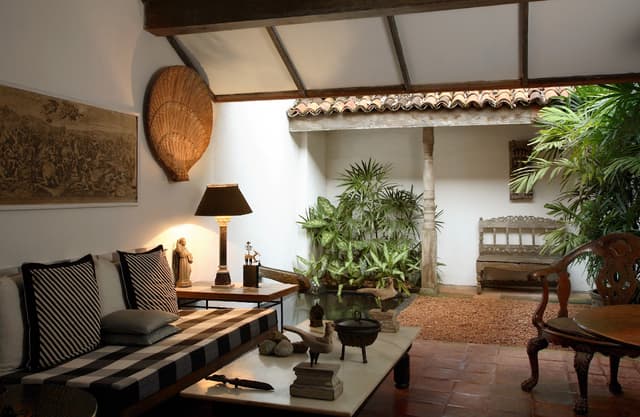
Geoffrey Bawa's Residence
@ravinkavish
Add to
Details

Yala National Park
@ravinkavish
Yala National Park, located in southeastern Sri Lanka, is the country’s most popular wildlife sanctuary and a top destination for nature enthusiasts. Covering over 978 square kilometers, it boasts diverse ecosystems, including forests, grasslands, lagoons, and coastal areas. Yala is particularly renowned for its leopard population, offering one of the highest chances in the world to spot these elusive big cats in the wild.
Beyond leopards, Yala is home to a wealth of wildlife, including elephants, sloth bears, crocodiles, jackals, and over 200 bird species, making it a paradise for photographers and wildlife enthusiasts. The park’s dramatic landscapes, from rocky outcrops to the serene Kumana wetlands, add to its allure.
**History:** Declared a wildlife sanctuary in 1900 and a national park in 1938, Yala has deep cultural ties, with ancient ruins and temples scattered throughout the park, hinting at its historical significance.
**Pro tip:** Plan your safari for early morning or late afternoon when animals are most active. Opt for Zone 1 for leopards or Zone 5 for a quieter, more immersive experience. Yala offers a perfect blend of thrilling wildlife encounters and stunning natural beauty, making it a must-visit for any traveler exploring Sri Lanka.
Add to
Details

Kiri Vehera Temple
@ravinkavish
Kiri Vehera Temple, located near Kataragama, is an ancient Buddhist stupa with deep historical and spiritual significance. Standing 95 feet tall and built from brick, the pristine white stupa is believed to have been constructed during the reign of King Mahasena in the 6th century BCE. According to tradition, it marks the spot where the Buddha meditated during his third visit to Sri Lanka.
Surrounded by a tranquil atmosphere, Kiri Vehera is a popular pilgrimage site for Buddhists, who visit to offer flowers and light oil lamps in reverence. Its proximity to the Kataragama sacred city makes it a key stop for those exploring Sri Lanka’s spiritual heritage.
**Pro tip:** Visit early in the morning or at sunset for a serene experience and to avoid crowds. Combine your trip with a visit to the Kataragama Devalaya, another significant religious site nearby. Kiri Vehera’s timeless beauty and sacred aura make it an unforgettable part of any journey to Sri Lanka.
Add to
Details

Elephants crossing Yala
@ravinkavish
Add to
Details

Yatala Stupa
@ravinkavish
The Yatala Stupa, also known as Yatala Maha Seya or Yatala Dalada Vehera, is a historic Buddhist temple located in Tissamaharama, Sri Lanka. This ancient stupa is believed to have been built during the 3rd century BCE by King Mahanaga, the ruler of Ruhuna, to commemorate the birth of his son. It is also said to have housed a relic of the Buddha, making it a significant site for Buddhist devotees.
The stupa is surrounded by an expansive sand courtyard and bordered by a unique elephant wall with beautifully sculpted stone elephants. Nearby, you’ll find an ancient moonstone and a museum showcasing artifacts discovered in the area, offering glimpses into the rich history of the region. The stupa’s serene setting near the Tissa Wewa reservoir adds to its spiritual charm.
**Pro tip:** Visit during the early hours to enjoy the tranquil atmosphere and explore the surrounding archaeological remains. Yatala Stupa is a must-see for history enthusiasts and those seeking a deeper connection to Sri Lanka's Buddhist heritage.
Add to
Details

Padikapuhela Temple
@ravinkavish
Add to
Details

Tissamaharama Raja Maha Vihara
@ravinkavish
Add to
Details

Sadagiri Maha Stupa- Tissamaharama Sacred City
@ravinkavish
Add to
Details

Tissa Lake View point
@ravinkavish
Add to
Details

Wehera godella(Amunudahaya), Rajamaha Viharaya
@ravinkavish
Add to
Details

Magul Maha Viharaya
@ravinkavish
Add to
Details

Thissa Lake bathing Point
@ravinkavish
Add to
Details

Wilpattu National Park
@ravinkavish
Wilpattu National Park is Sri Lanka’s largest and one of the oldest national parks, famous for its dense jungles, “willus” (natural lakes), and incredible wildlife diversity. If you're up for adventure, Wilpattu is your spot for spotting leopards, who thrive here due to the park’s low human presence. Elephants roam freely, and the park is also home to sloth bears, crocodiles, and a variety of colorful bird species like peacocks and storks.
Pro tip: Mornings or late afternoons offer the best chances for wildlife sightings, as animals are more active then. The park feels like a true wilderness, with a rustic vibe that’s unique compared to more frequented national parks in Sri Lanka. Bring binoculars and a camera—you might be lucky enough to spot a leopard lounging near one of the lakes or catch elephants bathing in a natural pool!
Add to
Details

Udawalawe National Park
@ravinkavish
Udawalawe National Park, located in southern Sri Lanka, is a wildlife haven renowned for its vast elephant population and breathtaking landscapes. Spanning over 30,000 hectares, this park is a sanctuary for a variety of wildlife, including leopards, water buffalo, sambar deer, and an array of bird species, making it a paradise for nature enthusiasts and photographers.
The park’s centerpiece is the Udawalawe Reservoir, which adds a serene charm to the scenery and attracts animals, especially during dry seasons. Safaris here are particularly rewarding, offering close encounters with herds of elephants in their natural habitat—one of the most remarkable experiences in Sri Lanka.
**History:** Udawalawe was established in 1972 to provide a haven for animals displaced by the construction of the Udawalawe Reservoir. Its open grasslands and scrub forests mimic an African savanna, creating a unique ecosystem.
**Pro tip:** The best time for wildlife spotting is early morning or late afternoon. Combine your visit with a stop at the Elephant Transit Home nearby to see young elephants being cared for before their release into the wild. Udawalawe is a must-visit for anyone exploring Sri Lanka’s natural treasures.
Add to
Details

Gal Oya Valley National Park
@ravinkavish
Add to
Details

Kabella Lena Purana Rajamaha Viharaya
@ravinkavish
Add to
Details

Yapahuwa Rock Fortress
@ravinkavish
Yapahuwa Rock Fortress is an incredible historical site, offering a fascinating glimpse into Sri Lanka’s medieval past. Located on a towering rock outcrop, this fortress served as the royal capital in the 13th century under King Buwanekabahu I. One of the most impressive features of Yapahuwa is its stunning entrance, where a grand staircase leads visitors up the rock. The stairs, flanked by ancient stone walls and remnants of royal structures, add an element of adventure to the journey.
At the summit, you’ll be rewarded with panoramic views of the surrounding landscapes, including lush forests and tranquil lakes. The site also features intricate carvings, ancient inscriptions, and a lion-shaped entrance, reminiscent of Sigiriya’s famous gateway.
Pro tip: The climb is moderately steep, but the views and the unique entrance make it well worth the effort. Visit early or late in the day to avoid the heat and enjoy the serene atmosphere. Yapahuwa Rock Fortress is a perfect blend of history, adventure, and stunning scenery.
Add to
Details

Yapahuva Rajamaha Viharaya
@ravinkavish
Yapahuva Rajamaha Viharaya, located in the Kurunegala District of Sri Lanka, is a historical and archaeological treasure. Once a royal capital during the 13th century, this ancient site is renowned for its impressive ruins, including a grand entrance gate and the remains of royal structures. The entrance gate is particularly striking, with intricate carvings and lion statues, giving the site an air of majesty and history.
The temple complex itself is built on a rocky outcrop, providing panoramic views of the surrounding landscape. The site’s serene ambiance and historical significance make it a fascinating destination for travelers interested in Sri Lanka's rich heritage.
**Pro tip:** Explore the well-preserved stone carvings and the remains of the ancient palace. Yapahuva is less crowded compared to other historical sites in Sri Lanka, offering a more peaceful and immersive experience. Be sure to visit during the day to fully appreciate the beauty of the site and its surroundings.
Add to
Details

Kothgala (කොත් ගල කට්ටඹුවාව)
@ravinkavish
Add to
Details

Nagolla Purana Rajamaha Viharaya
@ravinkavish
Add to
Details

Sri Nagala Rajamaha Viharaya - Nikawewa
@ravinkavish
Sri Nagala Rajamaha Viharaya, with a history dating back to the reign of King Devanampiyatissa (250-210 BC), is a hidden gem located at the foothill of the Nikawewa mountain range, nestled between Moragollagama and Madagalla. This ancient Buddhist temple, once neglected and deserted for a long period, has been beautifully restored and redeveloped to its former glory.
The temple features a stunning stupa and several Buddha statues, surrounded by peaceful natural landscapes. While it is a site of historical and spiritual importance, the temple is open to the public only on Poya days, when it hosts religious gatherings and offers a serene atmosphere for meditation and reflection.
Pro tip: Visiting on a Poya day offers the chance to experience the temple’s spiritual significance and tranquility, along with the beauty of its restored heritage. Sri Nagala Rajamaha Viharaya provides a unique opportunity to explore an ancient Buddhist site in a peaceful, off-the-beaten-path setting.
Add to
Details

Knuckles Forest Reserve
@ravinkavish
The Knuckles Forest Reserve, a UNESCO World Heritage Site, is a paradise for nature lovers and adventure seekers, located in the central highlands of Sri Lanka. Named after its unique mountain range resembling a clenched fist, the reserve boasts a diverse ecosystem, home to rare flora, fauna, and breathtaking landscapes. With misty peaks, lush forests, and crystal-clear streams, it’s a haven for hikers, photographers, and wildlife enthusiasts.
The reserve is renowned for its biodiversity, with endemic plants and animals thriving in its unspoiled environment. Visitors can explore numerous trails, each offering unique experiences—from scenic viewpoints like Mini World's End to hidden gems like waterfalls and natural pools. The reserve also provides a glimpse into the traditional lifestyles of local communities living in harmony with nature.
Add to
Details

Kalugala Gerandi Ella Waterfall
@ravinkavish
Kalugala Gerandi Ella Waterfall, located in the serene wilderness of Sri Lanka’s Knuckles Mountain Range, is a hidden natural beauty perfect for travelers looking for a peaceful escape. The waterfall is surrounded by lush forests and rocky terrain, with the water cascading down in multiple stages into a serene pool below. The area is rich in biodiversity, offering a tranquil environment where visitors can connect with nature.
The journey to Kalugala Gerandi Ella involves a moderate hike through dense greenery and rugged paths, making it an ideal destination for nature lovers and adventure seekers. Along the way, you may encounter wildlife, and once you reach the waterfall, you’ll be rewarded with breathtaking views and a chance to cool off in the refreshing waters.
Add to
Details

Infinity Pool Knuckles
@ravinkavish
The Natural Infinity Pool in the Knuckles Mountain Range is a magical spot tucked away in Sri Lanka's wilderness. Formed by a crystal-clear stream cascading over rocks, this serene pool offers stunning views of the surrounding valleys and misty mountains, creating the illusion of an endless edge blending into the horizon. It’s a hidden gem, perfect for cooling off after a hike and immersing yourself in the tranquility of nature.
To reach the infinity pool, you’ll need to trek through lush forests and cross small streams, adding adventure to your visit. The journey is as rewarding as the destination, with breathtaking scenery and the chance to spot wildlife along the way. This spot is ideal for those seeking solitude and a true off-the-grid experience.
Add to
Details

Duwili Ella and Duwili Ella cave
@ravinkavish
Duwili Ella, located in the Sabaragamuwa Province of Sri Lanka, is a stunning waterfall whose name means "Dust Falls," referring to the fine spray created as the water plunges from the rocks. This natural wonder is surrounded by dense jungle, making it a favorite spot for nature lovers and adventurers. The waterfall's pristine beauty and the sound of rushing water create a magical atmosphere perfect for unwinding and immersing yourself in nature.
Adjacent to the waterfall is the Duwili Ella Cave, a historic and adventurous highlight. Used by ancient travelers and monks, this cave offers shelter and a glimpse into Sri Lanka's past. The trek to the site is equally captivating, taking you through rugged paths, streams, and lush greenery.
Add to
Details
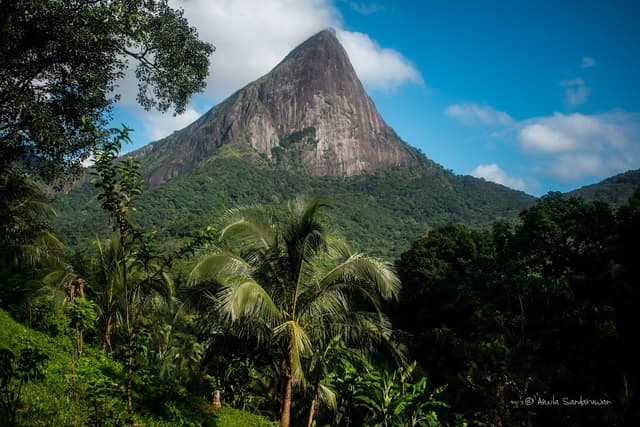
Meemure Lakegala
@ravinkavish
Lakegala, towering over the picturesque village of Meemure, is a striking rock formation steeped in legend and natural beauty. Often referred to as the "Sky Rock," its dramatic peak rises against the backdrop of the Knuckles Mountain Range, making it a must-visit for adventurers and nature enthusiasts. The name "Lakegala" translates to "Rock of Lanka," and it is believed to be connected to the ancient tales of Ravana from the Ramayana epic.
The journey to Lakegala takes you through Meemure’s lush greenery, traditional village life, and scenic paddy fields. The climb to the summit is challenging but incredibly rewarding, offering panoramic views of the surrounding wilderness, including misty mountains and cascading streams. Even if you don’t hike, the base of Lakegala provides a serene atmosphere for reflection and photography.
Add to
Details

Thunhisgala
@ravinkavish
Thunhisgala, a hidden gem in Sri Lanka's hill country, is a stunning rock formation offering panoramic views of the surrounding landscapes. Nestled in the lush greenery of the Knuckles Mountain Range, this destination is perfect for hikers and nature lovers seeking tranquility and breathtaking scenery. The name "Thunhisgala" translates to "Three Peaks Rock," reflecting its distinctive shape.
The hike to Thunhisgala takes you through scenic trails filled with vibrant flora and fauna, making it an adventure for those who love the outdoors. At the summit, you’ll be rewarded with views of mist-covered mountains, valleys, and the occasional glimpse of distant villages.
Add to
Details

Dumbara Ella Waterfall
@ravinkavish
Dumbara Ella Waterfall, nestled in the heart of the Knuckles Mountain Range, is a hidden gem that promises travelers a serene and awe-inspiring experience. Surrounded by lush forests and misty hills, this cascading beauty is a reward for those willing to trek through scenic trails. The sound of the rushing water and the tranquil atmosphere make it an ideal spot for nature lovers and photographers.
The waterfall's name, "Dumbara," reflects its location within the misty Dumbara Valley, a region rich in biodiversity and stunning landscapes. The trek to Dumbara Ella takes you through dense forests, small streams, and panoramic viewpoints, offering glimpses of the untouched wilderness that defines the Knuckles region.
Add to
Details

Riverston
@ravinkavish
Add to
Details

Pitawala Pathana, Riverston
@ravinkavish
Add to
Details

Mathalagala Camping Site
@ravinkavish
Mathalagala Camping Site, nestled in the breathtaking Knuckles Mountain Range, is a haven for nature lovers and adventure seekers. This serene spot offers an unforgettable camping experience surrounded by lush greenery, misty hills, and the tranquil sounds of nature. Located at a vantage point, Mathalagala treats visitors to stunning panoramic views of the valleys and peaks of the Knuckles Range, making it an ideal destination for those looking to escape the urban rush.
The campsite is perfect for hiking enthusiasts, with trails leading to hidden waterfalls, dense forests, and unique biodiversity. The Knuckles Range is a UNESCO World Heritage Site, known for its rich flora and fauna, including rare species of plants and animals.
Add to
Details

Naa Ella Falls
@ravinkavish
Naa Ella Falls, a hidden gem located in the picturesque Knuckles Mountain Range, is a beautiful and serene waterfall that offers a peaceful retreat for nature lovers and adventurers. The falls, named after the local "Naa" tree found nearby, cascade down the rocks into a crystal-clear pool, creating a tranquil atmosphere surrounded by lush greenery and dense forests.
The journey to Naa Ella Falls involves a scenic hike through the forest, where you can enjoy the sights and sounds of Sri Lanka’s rich biodiversity. The waterfall is a perfect spot for a refreshing dip, a picnic, or simply enjoying the beauty of the natural surroundings.
Add to
Details
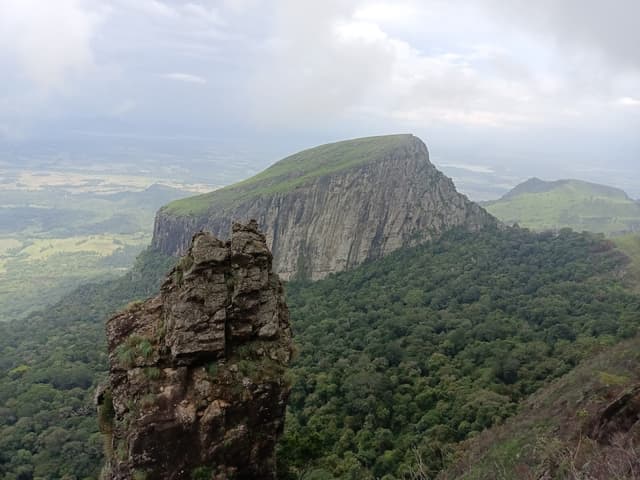
Yahangala peak
@ravinkavish
Yahangala Peak, located in the stunning Knuckles Mountain Range, is a hidden gem offering panoramic views of Sri Lanka’s breathtaking landscapes. This relatively unknown peak is perfect for travelers seeking a peaceful yet rewarding hiking experience. The summit provides a 360-degree view of rolling hills, lush forests, and distant villages, making it a prime spot for nature photography and tranquility.
The hike to Yahangala Peak is moderately challenging, taking you through dense forests and rugged terrain, with plenty of opportunities to spot endemic flora and fauna along the way. Once at the top, the view of the surrounding mountain ranges and valleys is truly spectacular, especially during sunrise or sunset.
Add to
Details

Welangolla Pathana
@ravinkavish
Welangolla Pathana, nestled in the serene surroundings of the Knuckles Mountain Range, is a breathtaking plateau that offers stunning views and a tranquil environment for nature lovers and adventurers. This picturesque spot is perfect for travelers seeking an off-the-beaten-path experience, surrounded by rolling hills, lush greenery, and peaceful landscapes.
The area is known for its cool climate, making it a refreshing stop on a hike through the Knuckles Range. The plateau is also home to a variety of endemic flora and fauna, adding to its appeal for nature enthusiasts and wildlife photographers.
Add to
Details

Five peaks of Knuckles
@ravinkavish
The Five Peaks of Knuckles, a breathtaking cluster of mountains in Sri Lanka's Knuckles Mountain Range, offer some of the most spectacular views and adventurous hiking experiences on the island. Named for their unique shape resembling five fingers, these peaks rise dramatically from the surrounding lush forests, creating a striking natural landscape.
The trek to the Five Peaks is challenging yet immensely rewarding, with trails that take you through dense forests, rugged terrains, and picturesque valleys. Along the way, you'll encounter rich biodiversity, with opportunities to spot endemic flora and fauna. Once at the summit, the panoramic views of misty mountains, valleys, and distant villages will leave you in awe.
Add to
Details

Saree Ella Waterfall
@ravinkavish
Saree Ella Waterfall, nestled in the enchanting Knuckles Mountain Range, is a serene and captivating natural wonder. Its name, "Saree Ella," comes from the way the cascading water resembles the flowing folds of a saree, a traditional Sri Lankan garment. Surrounded by lush greenery and tranquil forests, this lesser-known gem is perfect for travelers seeking a peaceful retreat in nature.
The waterfall is accessible via a short hike, making it a great destination for both casual explorers and adventure enthusiasts. The soothing sound of the water and the refreshing ambiance provide the perfect escape from the hustle and bustle of daily life.
Add to
Details

Lakegala viewpoint
@ravinkavish
Add to
Details

Heen Gaga Natural Pool
@ravinkavish
Heen Gaga Natural Pool, located in the remote Meemure village within the stunning Knuckles Mountain Range, offers a peaceful and rejuvenating escape for nature lovers and adventurers. Surrounded by lush forests and serene landscapes, this crystal-clear natural pool is the perfect spot for a refreshing swim or a quiet moment of relaxation.
The journey to the pool involves a scenic hike through the picturesque Meemure village, where you can witness traditional village life and experience the rich biodiversity of the area. The waters of Heen Gaga are fed by a nearby stream, making it an ideal place to cool off after the trek.
Add to
Details

rassagala mountain
@ravinkavish
Add to
Details
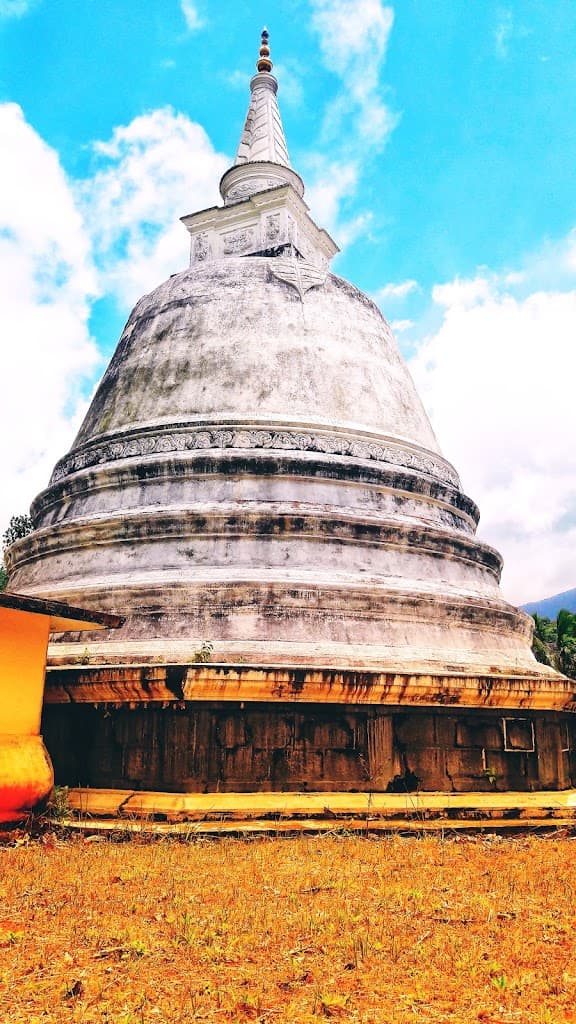
Rankoth Viharaya Rassagala
@ravinkavish
Add to
Details

Bambarakotuwakanda Forest reserve
@ravinkavish
Add to
Details

Raksagala - Kinihira Kanda
@ravinkavish
Add to
Details

Kabaragala Peak
@ravinkavish
Add to
Details

Batticaloa
@ravinkavish
Add to
Details

Kokkaddicholai Thaanthonreeswarar Temple | கொக்கட்டிச்சோலை தான்தோன்றீச்சரம்
@ravinkavish
Add to
Details

Batticaloa Lagoon Park
@ravinkavish
Add to
Details

Batticaloa Lighthouse
@ravinkavish
Add to
Details

Batticaloa Dutch Fort
@ravinkavish
Add to
Details

Kallady Beach
@ravinkavish
Add to
Details

Negombo
@ravinkavish
Negombo, a charming coastal town just north of Colombo, is known for its beautiful beaches, rich history, and vibrant fishing culture. With a mix of colonial-era architecture and modern-day Sri Lankan life, Negombo offers a unique blend of experiences. The town is home to a bustling fish market, scenic canals, and several significant religious sites, including churches and temples that reflect the island's diverse cultural heritage.
One of the highlights of Negombo is its long, sandy beaches, perfect for relaxing or enjoying water activities like swimming and windsurfing. The town also has a wide range of restaurants, cafes, and shops where travelers can indulge in local seafood and souvenirs.
Pro tip: Negombo is a great place to unwind at the beginning or end of your Sri Lanka trip, thanks to its proximity to the airport. The town offers a laid-back atmosphere and is ideal for travelers looking to explore Sri Lanka’s coastal beauty while experiencing the local culture and hospitality. Visit in the early morning for peaceful beach walks or in the evening to enjoy the vibrant sunset views.
Add to
Details

Victoria Memorial Clock Tower
@ravinkavish
The Victoria Memorial Clock Tower in Colombo is a historic landmark that stands as a testament to Sri Lanka's colonial past. Built in 1902 to commemorate Queen Victoria's diamond jubilee, this elegant clock tower combines functionality with architectural beauty. Its whitewashed façade and intricate details reflect the colonial-era craftsmanship, making it a striking feature in the bustling heart of Colombo Fort.
Originally designed to serve as both a clock tower and a lighthouse, it played a significant role in guiding ships entering Colombo Harbor until modern technology rendered the lighthouse function obsolete. Today, the clock tower is a symbol of the city's rich history and cultural heritage.
Pro tip: The tower is located near several other key attractions in the Fort area, making it an easy stop during a walking tour of Colombo. Visit in the morning or late afternoon to explore the area comfortably while appreciating the charm of this colonial-era monument.
Add to
Details

St. Stephen's Anglican Church
@ravinkavish
St. Sebastian's Church, located on Sea Street in the vibrant town of Wellawaya, is a significant religious site with deep cultural and spiritual importance. This beautiful church, dedicated to St. Sebastian, features stunning architecture, with intricate designs and a peaceful atmosphere that makes it a perfect spot for quiet reflection or to experience local Christian heritage.
The church is known for its vibrant surroundings, with colorful murals and statues of saints, as well as its well-maintained grounds. It is a popular place for both locals and visitors, especially during religious festivals and Poya days.
Pro tip: The church is located in a serene area, making it a great place to visit for anyone seeking a peaceful break or to learn about Sri Lanka's religious diversity. Visit early in the morning or late in the afternoon to enjoy the tranquil atmosphere and cooler temperatures. St. Sebastian's Church offers a unique cultural experience for travelers interested in exploring Sri Lanka’s Christian heritage.
Add to
Details

St. Mary's Church
@ravinkavish
St. Mary's Church in Negombo is a beautiful and historically significant Catholic church, located in the heart of the town. Known for its stunning colonial architecture, the church features grand whitewashed walls, an elegant façade, and a spacious interior adorned with beautiful stained-glass windows and intricate carvings. The church is one of the largest in Sri Lanka and stands as a testament to the country's colonial past and the long-standing Christian heritage in the region.
The church is particularly famous for its serene atmosphere, making it a perfect spot for reflection and prayer. Visitors can admire the well-maintained grounds, which include a peaceful garden and a large bell tower that is visible from afar. St. Mary’s Church also hosts regular mass services, and local festivals often draw crowds, adding to the vibrant cultural experience.
Pro tip: St. Mary’s Church is easily accessible, and its peaceful setting makes it a great stop for anyone looking to experience Sri Lanka’s Christian heritage. Visit in the morning or late afternoon to avoid the heat and to enjoy the church in a quieter atmosphere. It’s a perfect stop for those interested in exploring Sri Lanka's colonial history and religious diversity.
Add to
Details

Mother of Purification Church - Pitipana
@ravinkavish
Mother of Purification Church in Negombo is a peaceful and beautiful Catholic church, known for its serene atmosphere and impressive architecture. The church is dedicated to the Mother of Purification, an important figure in the Catholic faith. Its modern design, with large, stained-glass windows and elegant interior, offers a calm and reflective environment for visitors.
The church is an active place of worship for the local community, and travelers can experience its spiritual ambiance during regular mass services or simply enjoy the tranquil surroundings. The well-maintained grounds and peaceful garden add to the overall charm of the location.
Pro tip: Mother of Purification Church is a wonderful stop for those seeking to explore the spiritual and cultural heritage of Negombo. It's less crowded than some of the larger churches, offering a more peaceful experience. Visit in the morning or late afternoon for a cooler, quieter visit and to fully appreciate the calm, reflective atmosphere.
Add to
Details
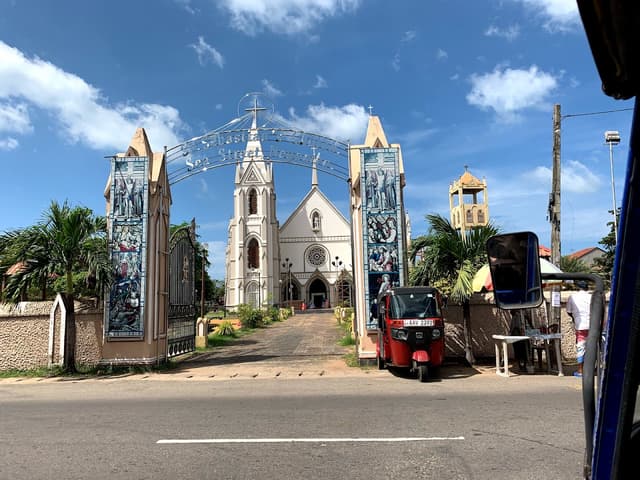
St. Sebastian's Church - Sea Street
@ravinkavish
St. Stephen's Anglican Church in Negombo is a charming and historically significant church located in the heart of the town. Built in the early 19th century, this colonial-era church is known for its simple yet elegant architecture, featuring a distinctive bell tower and beautiful stained-glass windows. The church, which belongs to the Anglican tradition, serves as a peaceful retreat for both locals and visitors alike.
The interior of St. Stephen’s Church is serene, with wooden pews and a sense of calm that makes it a perfect spot for quiet reflection or to learn more about the island’s Christian heritage. The church also holds regular services, and visitors can often catch a glimpse of local worshippers participating in prayer.
Pro tip: St. Stephen’s Anglican Church is less crowded compared to other historical churches, making it ideal for those seeking a tranquil environment. It’s an excellent stop for travelers interested in colonial architecture and exploring the diverse religious history of Sri Lanka. Visiting in the early morning or late afternoon allows you to enjoy the church in a peaceful, cooler atmosphere.
Add to
Details

Angurukaramulla Temple (Bodhirajaramaya)
@ravinkavish
Angurukaramulla Temple (Bodhirajaramaya) is a significant Buddhist temple located in Negombo, Sri Lanka. This serene temple is well-known for its stunning Buddha statues, including a large, seated Buddha statue at the entrance, which is one of the temple's main highlights. Visitors can also admire beautiful murals that depict various scenes from the life of the Buddha and important Buddhist teachings.
The temple has a rich history, with structures dating back centuries, and remains an important place of worship for the local community. It is not only a place of religious significance but also offers a peaceful atmosphere for visitors to explore and reflect.
Pro tip: Angurukaramulla Temple is a great place to visit for those looking for a tranquil spot to learn about Sri Lanka's Buddhist heritage. It's less crowded than other popular tourist destinations, so it's perfect for travelers seeking peace and culture. Visit in the morning or late afternoon to enjoy the calm, cooler temperatures.
Add to
Details
* * *
ABOUT THE AUTHOR
Solo Travel Guide Sri Lanka
Hi there! I’m Ravin from Sri Lanka.
As a solo traveler and a Travel Designer, I’ve explored this beautiful island, and while I often travel solo, I’ve made a lot of amazing connection with other solo travelers from all around the world. And they always filled my journey with a lot of good vibes and memories.
However, I noticed that many solo travelers miss out on the true magic of Sri Lanka. And they also end up taking back-and-forth routes or miss hidden gems that could’ve made their trip unforgettable. So I decided to create custom-made itineraries designed especially for solo travelers like you. My goal is to help you explore smarter, see more, save more, explore more and experience Sri Lanka with ease. No guesswork, no missed spots, just a well-planned adventure filled with discovery and excitement.
After working as a Travel Designer, I decided to go freelance because I love sharing authentic experiences and connecting with fellow travelers. Every itinerary I share is a result of my own journeys, insights, and research.
Here’s the best part: I’m giving these itineraries away for free! It’s my way of supporting you, Sri Lanka’s tourism, local communities, and small businesses. As a solo traveler myself, I understand what it’s like to be on a budget, I’ve been there!
If my work adds value to your journey, you’re welcome to leave a tip as a token of appreciation, but it’s totally optional. I’m just happy to help you explore Sri Lanka in a way that’s meaningful and memorable.
So, let’s make your trip to Sri Lanka something truly special. I’m here to guide you every step of the way!"
Send A Tip
Support Solo Travel Guide Sri Lanka’s work.
Select your tip amount
$5
$10
$20
$50
Or type in other amount
Explore related destinations
Read more about places in this guide
Powered by Thatch
The home for unique & authentic travel
The home for unique & authentic travel
Powered by Thatch: Where great trips are made.
© Solo Travel Guide Sri Lanka 2024 • Help • Privacy • Terms • Copyright • Become a Seller • Seller Academy • About • Careers • Blog • Explore Places